Just who was George Peabody, the “Father of Modern Philanthropy?”
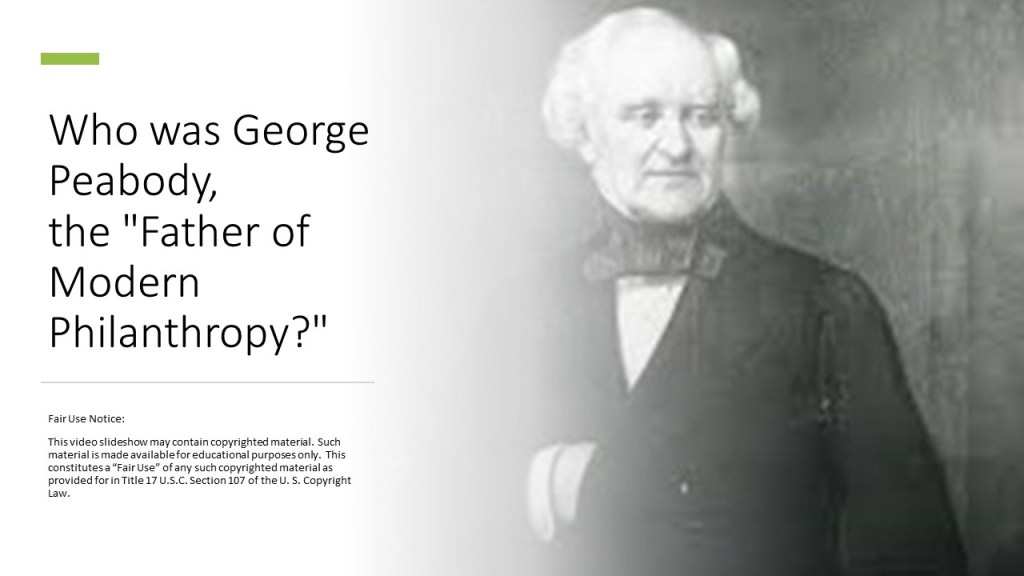
George Peabody came to my attention in the interview “Secrets of the Wormholt – the Wormhole in West London.”

James Connolly mentioned philanthropist George Peabody early in our interview, and Peabody Estates very close to where he grew up in the Wormholt Estate at 37 Steventon Road in the Wormholt, a neighborhood in the Shepherd’s Bush District of West London.

What he said about the Peabody Estates piqued my curiosity, so I decided to do a deep dive and find out more about exactly who George Peabody was.
It is interesting to note that the Cleverly Estate, a Peabody Housing Trust Estate in Shepherd’s Bush that was said to have been completed in 1928, with the most elaborate features of any of their other pre-war estates and the first Peabody estate built with a bathroom in every flat…
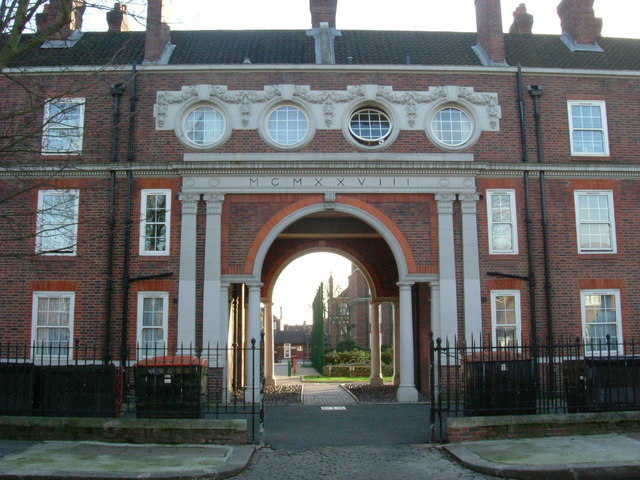
…suffered a direct hit by a V Rocket during World War II, less than 20-years later, in 1945, killing thirty residents.

Widely regarded as the “Father of Modern Philanthropy,” George Peabody was said to have been born into a poor family in Massachusetts.
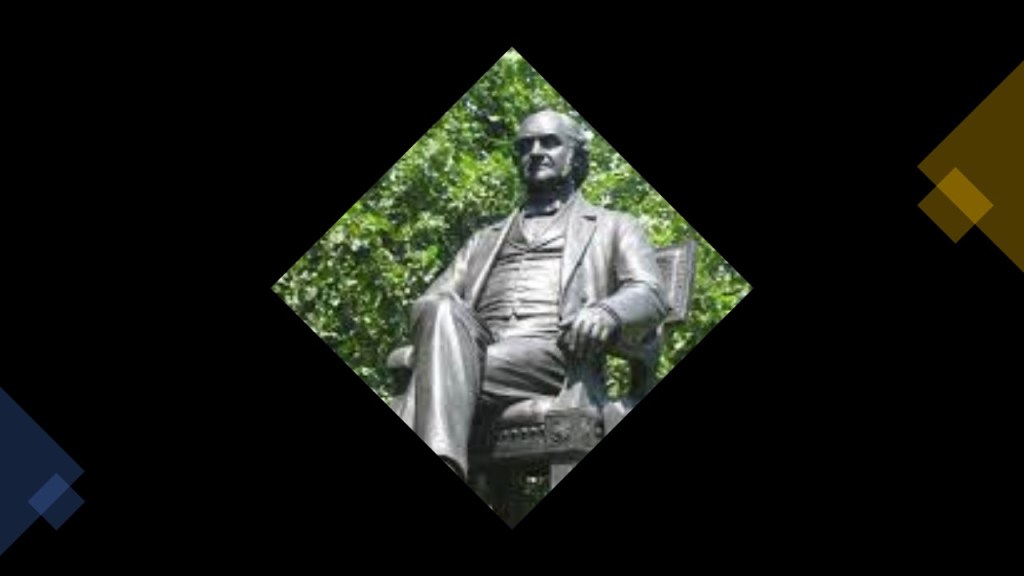
There were other major historical figures who became wealthy said to have been born into poverty or difficult circumstances.
Ones off the top of my head include:
John Molson, who was born in England in 1763.
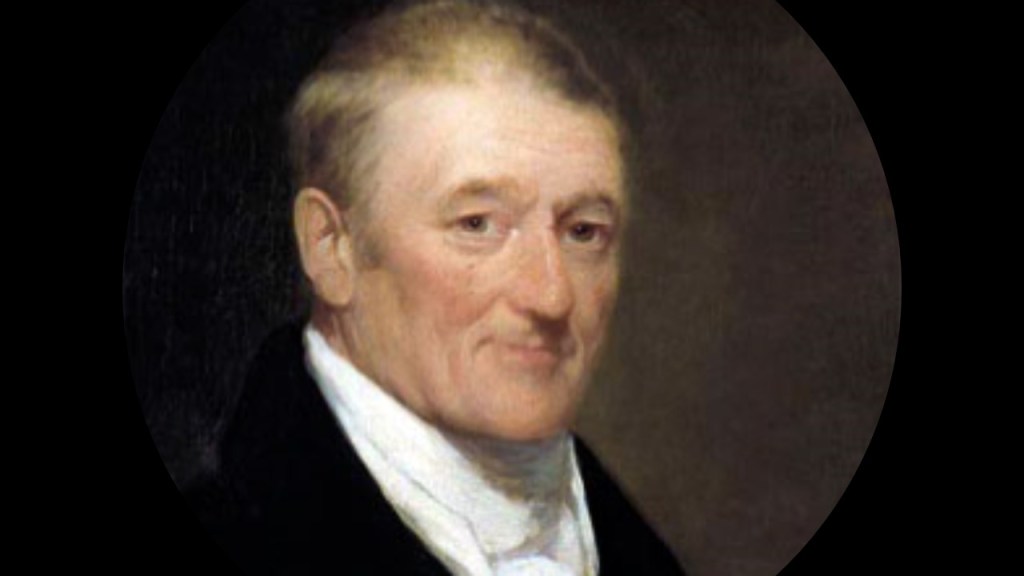
He was said to have been orphaned at the age of 8, when first his father died, then his mother two years later. He lived with various guardians until he left England for Montreal, Quebec in 1782 at the age of 18.
This is a 1761 map of the “Isle of Montreal.”
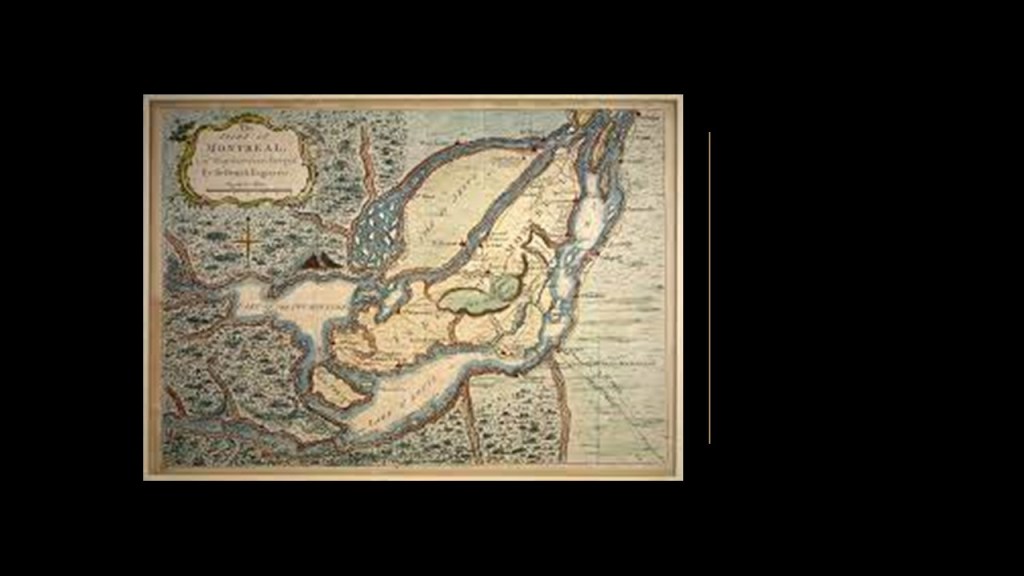
After his arrival in Montreal, he moved in with a brewer, Thomas Loyd, and shortly thereafter became a partner of the brewery. At the age of 21, he took over the brewery completely.
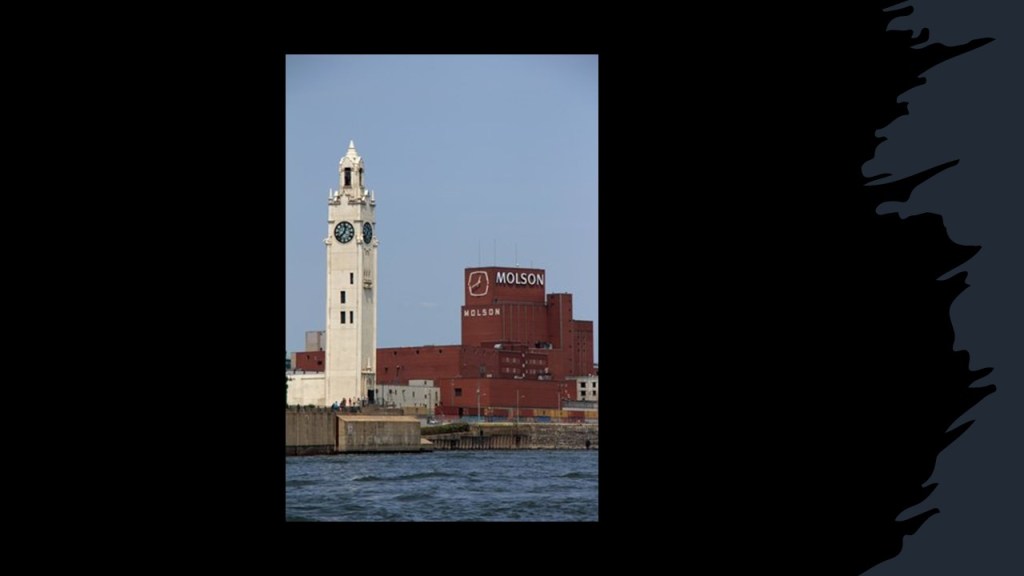
He became a brewer and entrepreneur in colonial Quebec and Lower Canada.
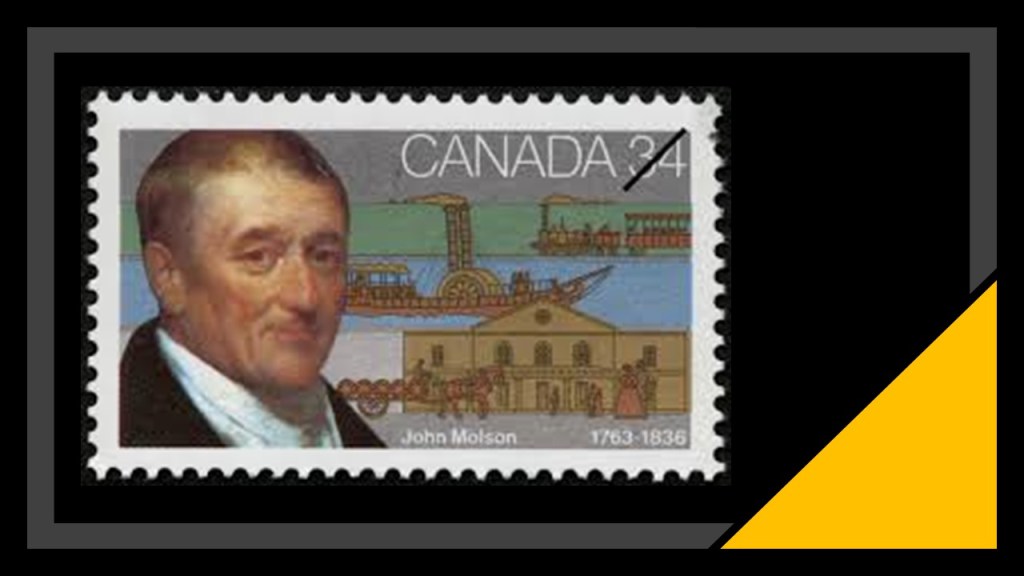
In addition to being given the credit for financing the first public railway in Canada, the Champlain & St. Lawrence Railway, chartered in 1832 and built in 1835…

…he founded Molson Brewery in 1786 in Montreal…

…financed the first steamship built in North America in 1809, “The Accommodation…”

…and was President of the Bank of Montreal.

He was also appointed the Provincial Grand Master of the District Freemasonic Lodge of Montreal by the Duke of Sussex in 1826, a position he held for five years before resigning in 1831.
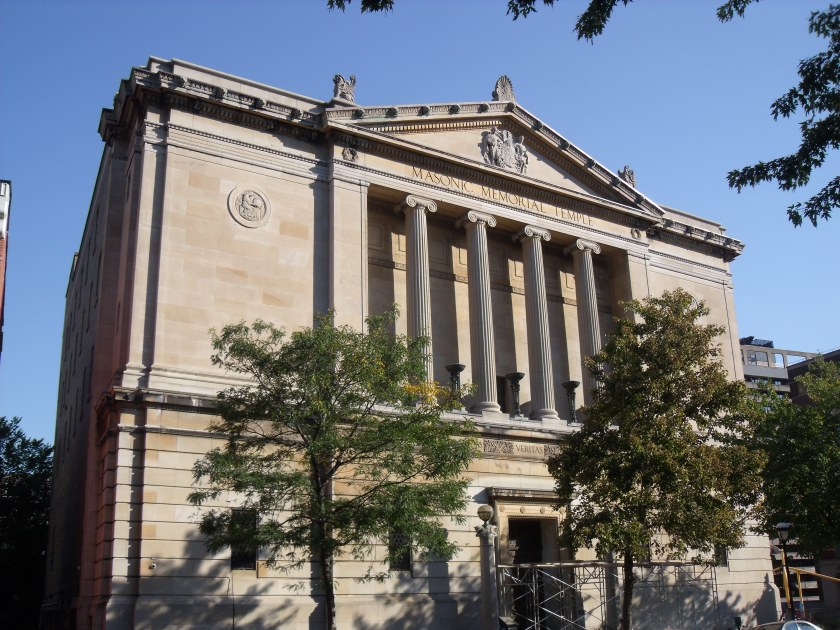
Another poor boy made good story that comes to mind is another Canadian, distiller Joseph E. Seagram.

Born in 1841 in what is now Cambridge, Ontario, his parents died when he was a child and he and his brothers were said to have been raised by clergy.
He received education at a business college and eventually learned about the distilling process at Waterloo Distillery, and ultimately bought out other owners to become the full owner, and renamed it Seagram’s. His 1907 Creation of “VO Whiskey” became the largest-selling Canadian whiskey in the world.
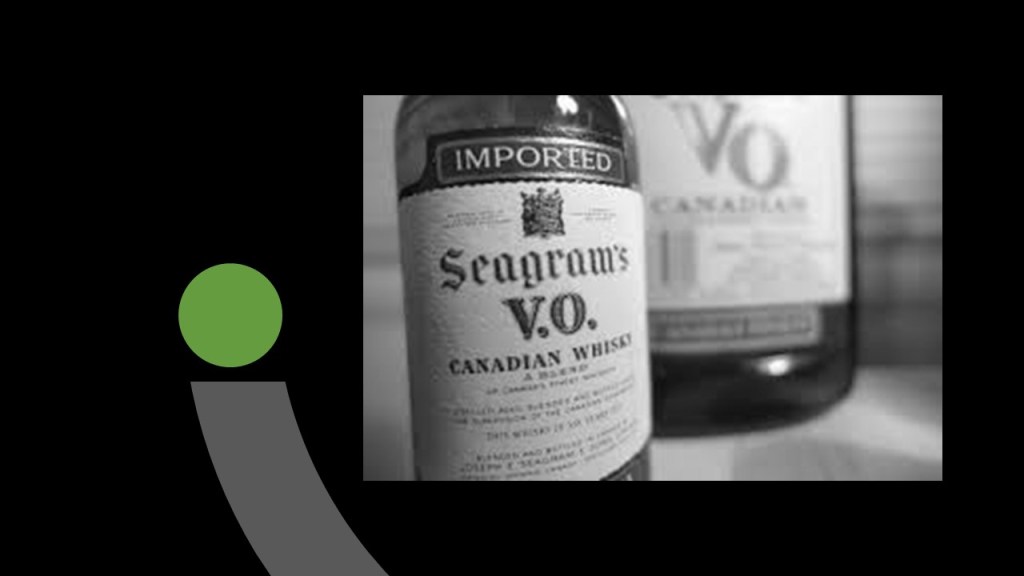
Seagram, like Molson, was also a freemason, and at one time Senior Warden of the Grand River Lodge, Number 151, in what is now Kitchener, Ontario, which was previously known as Berlin.
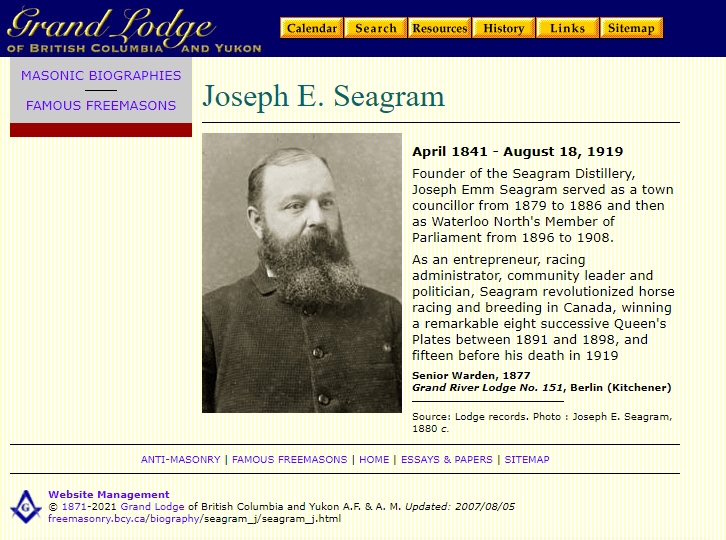
Jack Daniel, same idea.
Jasper Newton “Jack” Daniel was born sometime in the mid-1800s. The birth date of 1850 was on his tombstone, however, his birthdate was said to be listed as September 5th, 1846 in Tennessee state records from the time.
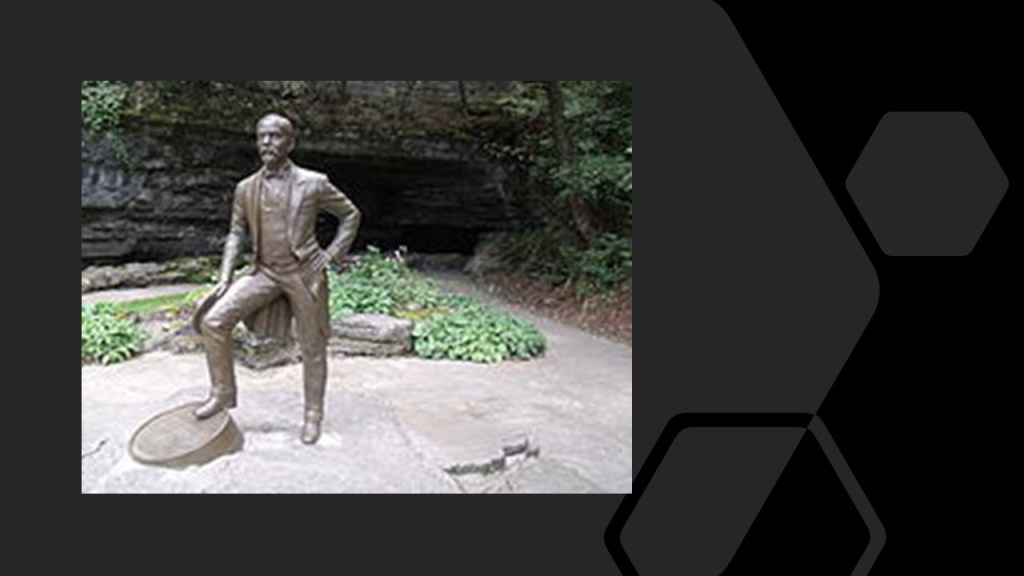
He was the youngest of ten children, and his mother died shortly after he was born.
When his father died in the Civil War, he ran away from home because he didn’t get along with his stepmother.
He was taken in by the local lay-preacher and distiller, Dan Call, and began to learn the distilling trade.

He was said to have received an inheritance from his father estate’s after a long dispute with his siblings was resolved, and he founded a legally-registered distilling business with Call in 1875.
Shortly afterwards, Call was said to have quit for “religious reasons.”
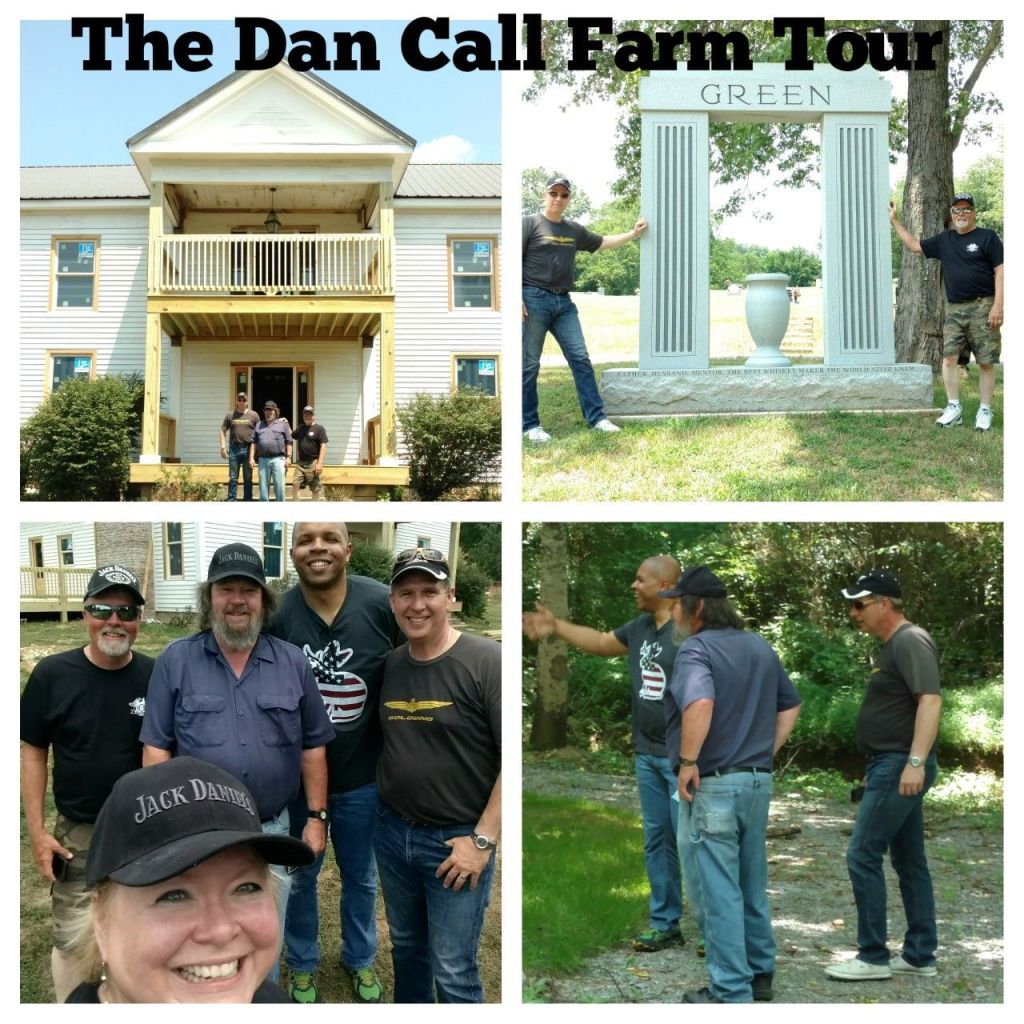
Jack Daniel purchased the hollow and land the distillery was located on in Lynchburg, Tennessee, after taking over the distillery in 1884.
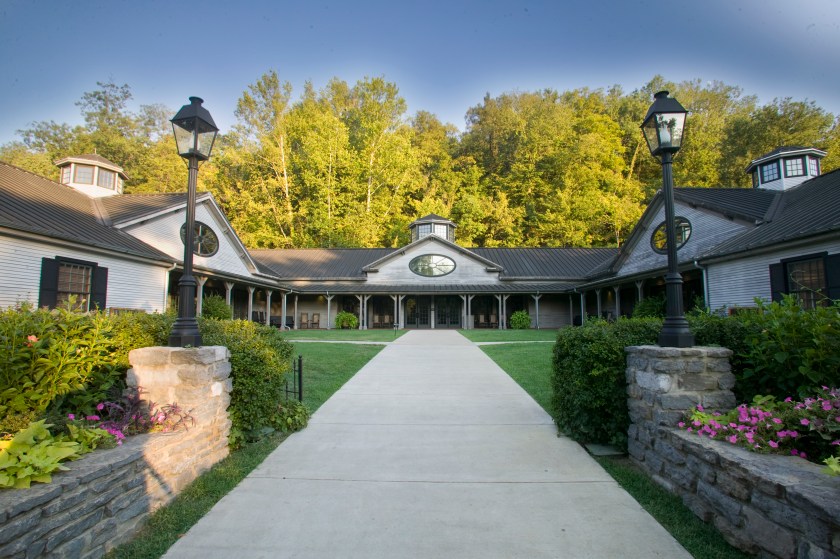
Jack Daniel’s is a brand of Tennessee Whiskey, and the top-selling American whiskey in the world.
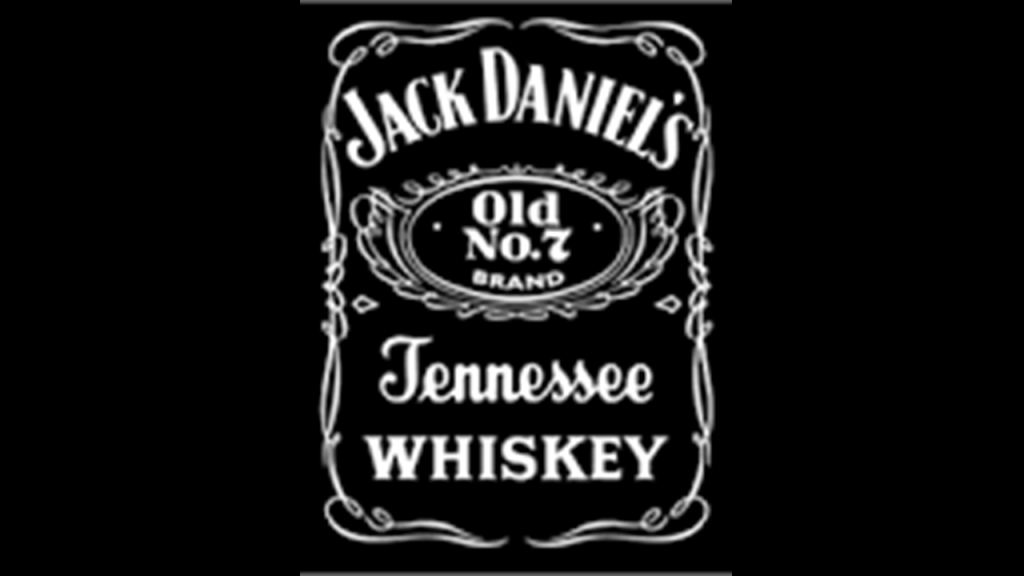
I couldn’t find anything about Jack Daniel being a Freemason, but I did find some interesting connections Freemasons and his whiskey.
One was a limited edition commemorative bottle of “Jack Daniel’s Single Barrel Whiskey,” bottled exclusively for American Freemasons…

…and the other thing I found was a rare “Jack Daniel Whiskey Freemasonic Masonic Watch,” complete with skull and bones in between the compass and the square underneath the cover of it, that the information is no longer available for on the website where one was auctioned off.
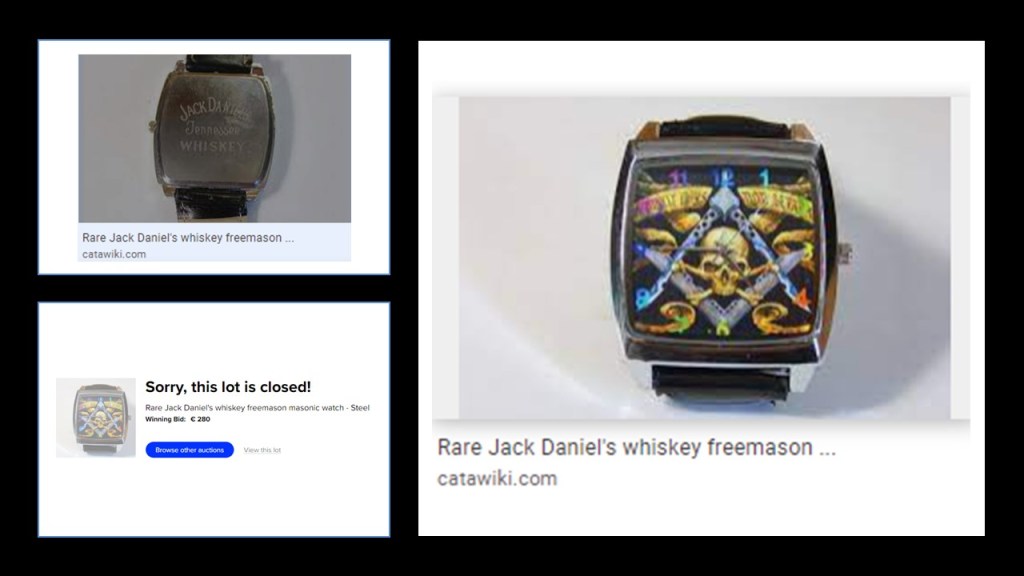
This biographical information about these four men, including George Peabody, would be otherwise unremarkable, but isn’t it curious they all share a similar theme in childhood and how they all came into fame and fortune.
And, in addition to the connections I have found to freemasonry with Molson, Seagram, and Daniel, can I find one for George Peabody?
Well, first I found this one referring to the British Freemasonic Banker, George Peabody, on page 175, and there is a lot more on this page and others that I am going to delve into in the course of this post…
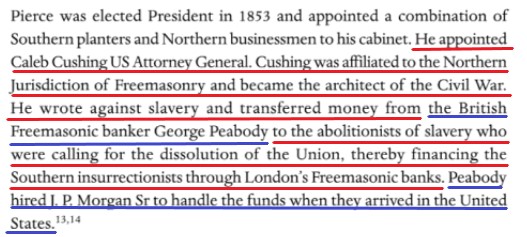
…of the book “The Secret Founding of America, the Real Story of Freemasons, Puritans & the Battle for the New World,” by Nicholas Hagger.
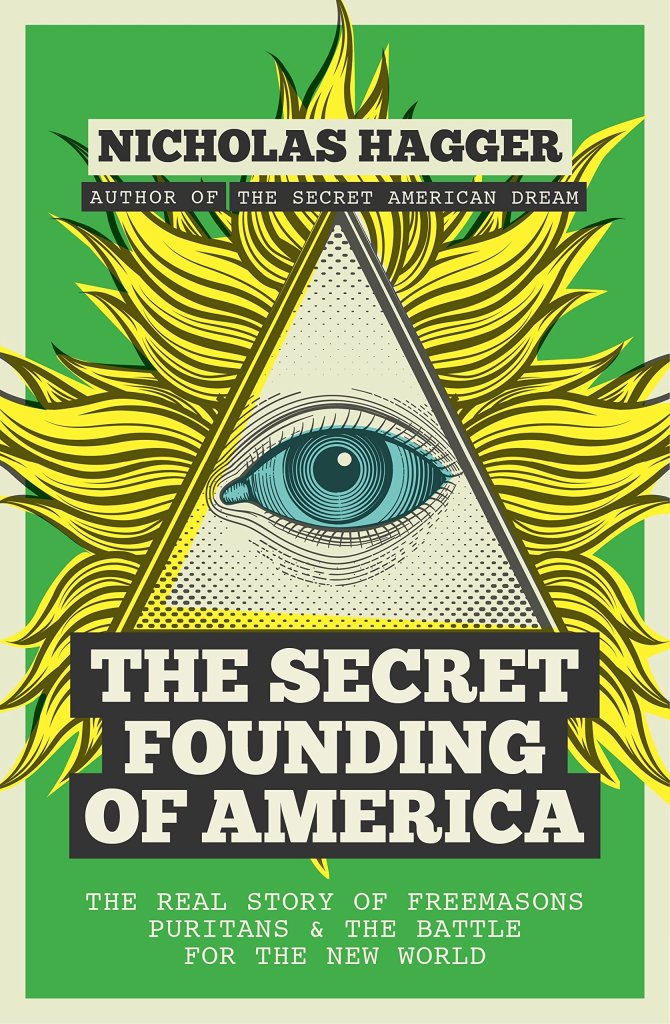
Peabody and J. S. Morgan Sr. became business partners in 1854, and after Peabody retired in 1864, their joint-business became known as J. S. Morgan and Company in 1864, which later became known as J. P. Morgan.

…and there are the other names I am finding on this same page in the book that are ringing bells from my past research, which I will tying in as I go.
All of this information bears a much closer look!
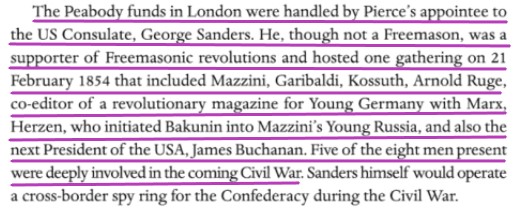
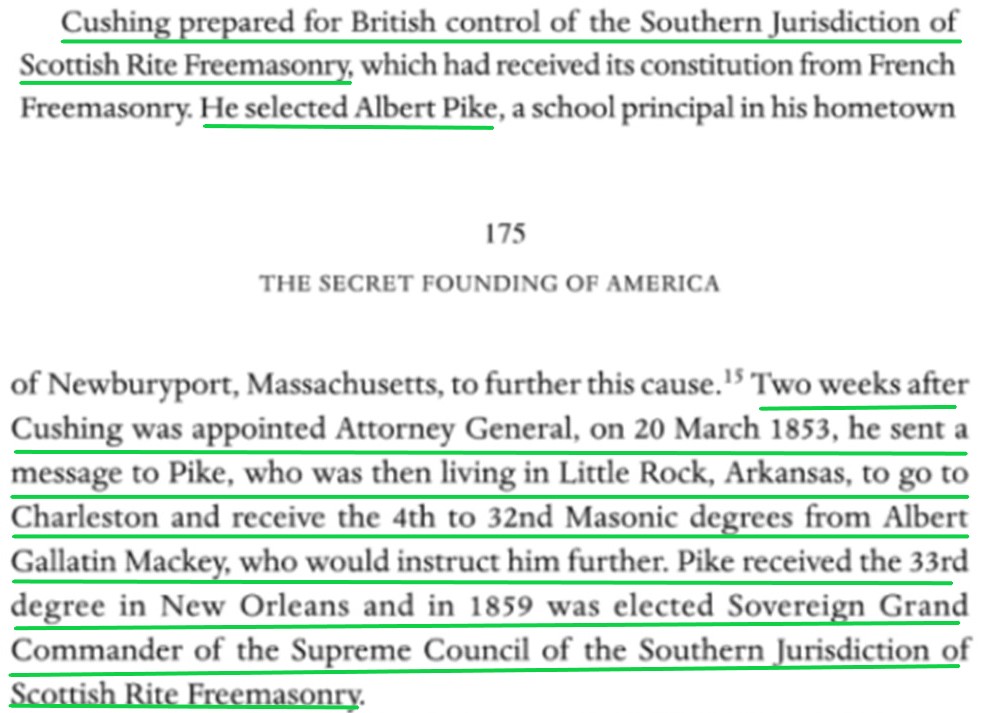
However, before I go any further down this Freemasonic rabbit hole, about which this book is a treasure trove of information, I am going to continue researching what we are told about George Peabody’s life, and then return to this subject because there is quite a bit that can be tied together using “The Secret Founding of America” as a guide about what has actually taken place here as opposed to what we have been told.
I didn’t know about this book’s existence until I did an internet search for “Was George Peabody a freemason?”
Here is another connection of George Peabody, where he is striking the Freemasonic “hidden hand” pose in this portrait, signifying “Master of the Second Veil.”
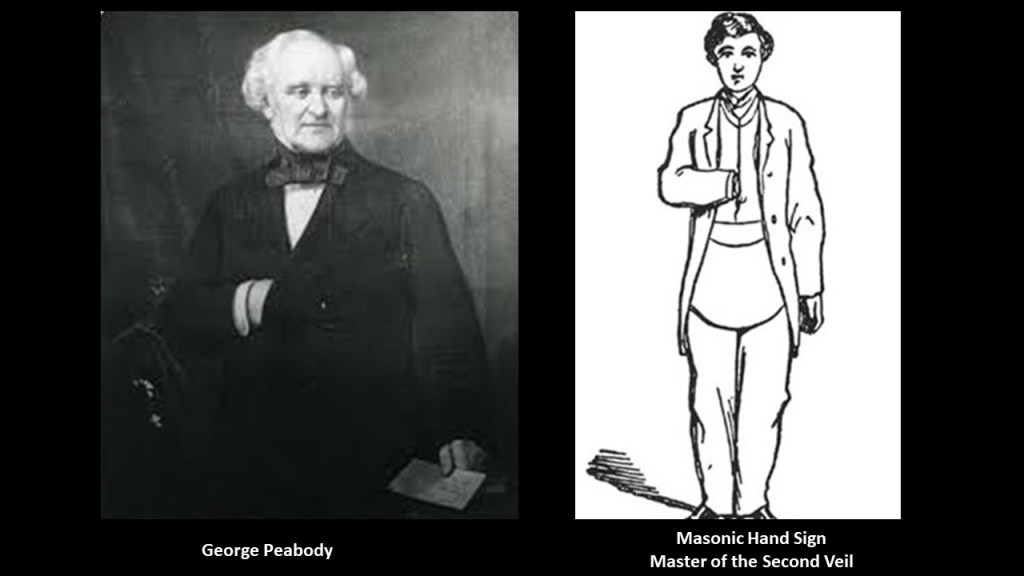
This is what we are told about his life.
George Peabody was born on February 18th of 1795 in South Danvers, Massachusetts, near Salem, as one of seven or eight children in a poor family, as the number of siblings varied from reference to reference.
South Danvers was re-named Peabody in his honor in 1868…
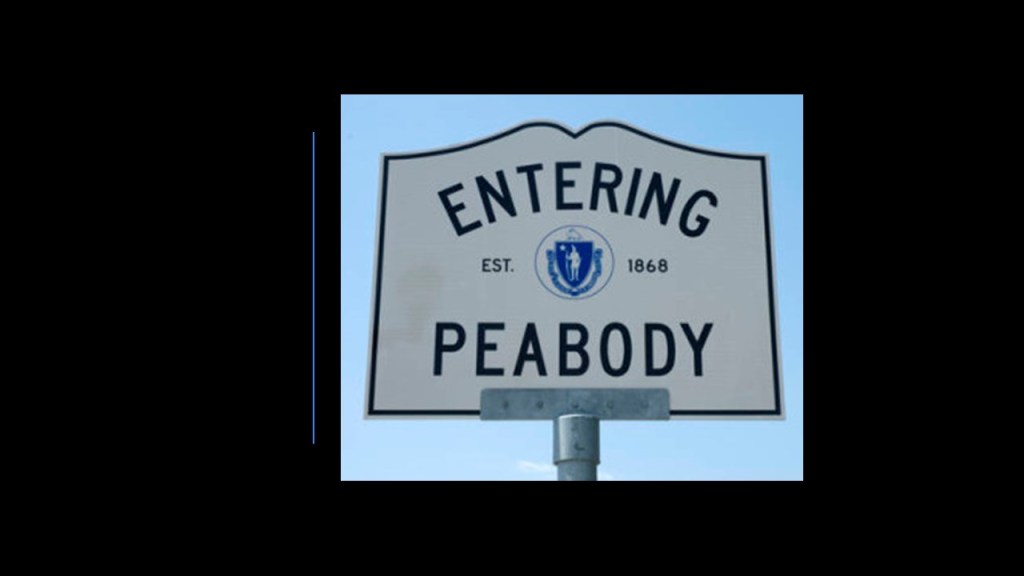
…and it became a major center of New England’s leather industry until the loss of its tanneries in the second-half of the 20th-century.
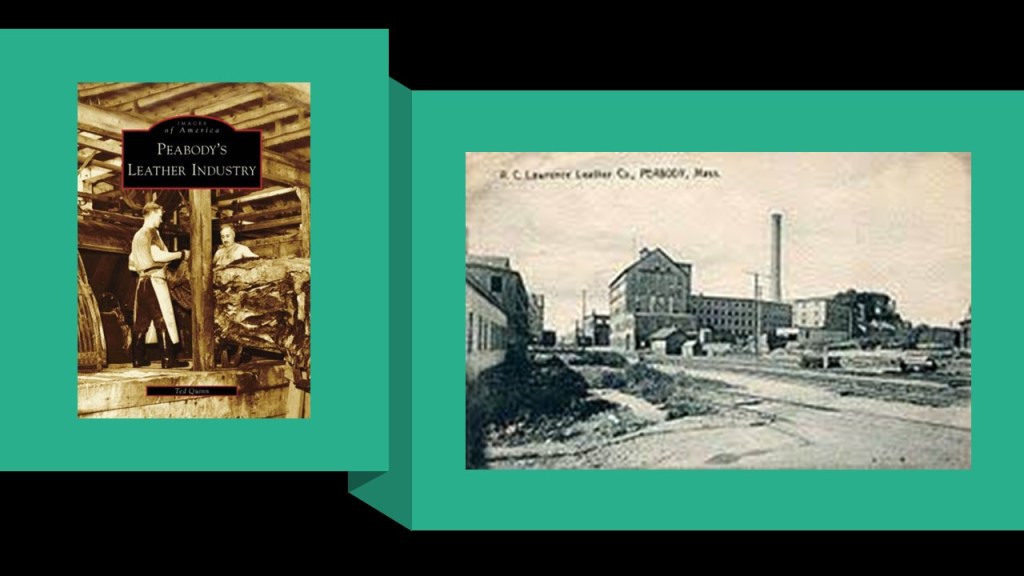
Only attending school for a few years, George left school at the age of 11 to work in his brother’s shop in Newburyport, Massachusetts, to help support his mother and siblings when his father died, and the poverty of his early years was said to have influenced his philanthropy in later years.
The George Peabody House Museum in Peabody, Massachusetts, is touted as his birthplace.

When his brother’s Newburyport, Massachusetts, dry goods business burned down, Peabody went to Georgetown in Washington, DC, in 1811, to work in a wholesale dry goods’ warehouse.
The owner of the warehouse, Elisha Riggs. hired George Peabody as his office boy, and by 1814, Riggs provided the financing for the wholesale dry goods firm of Riggs, Peabody & Company, specializing in importing dry goods from Great Britain.
When Riggs retired in 1829, the firm became Peabody, Riggs & Company, as George became the Senior Partner.
Elisha Riggs also financed the founding of Riggs National Bank, which was organized by his son George Washington Riggs.
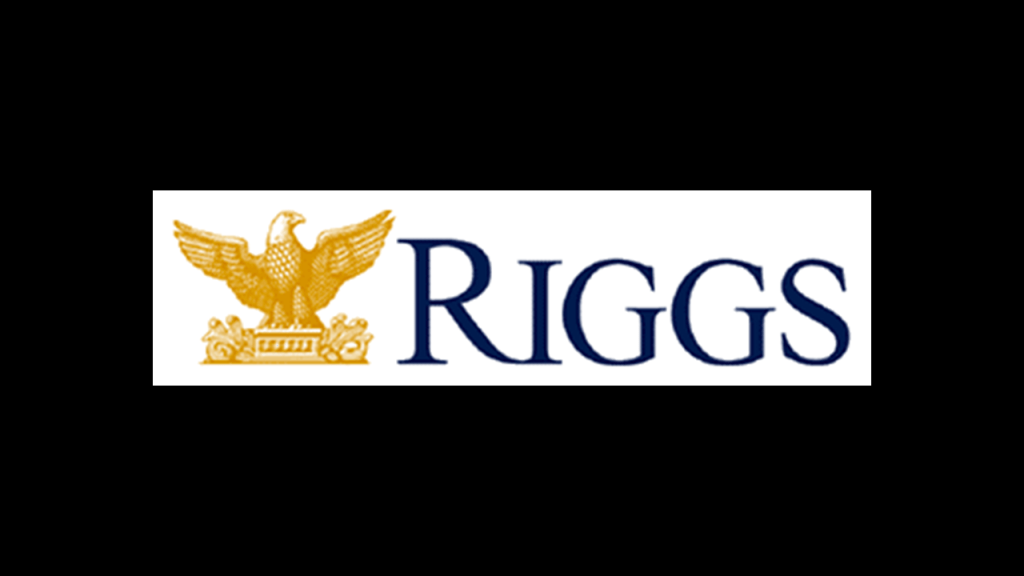
This building on Pennsylvania Avneue in Washington, DC, said to have been completed in 1902, served as the headquarters for Riggs National Bank until 2005, when Riggs was dissolved, and acquired by PNC Financial Services.
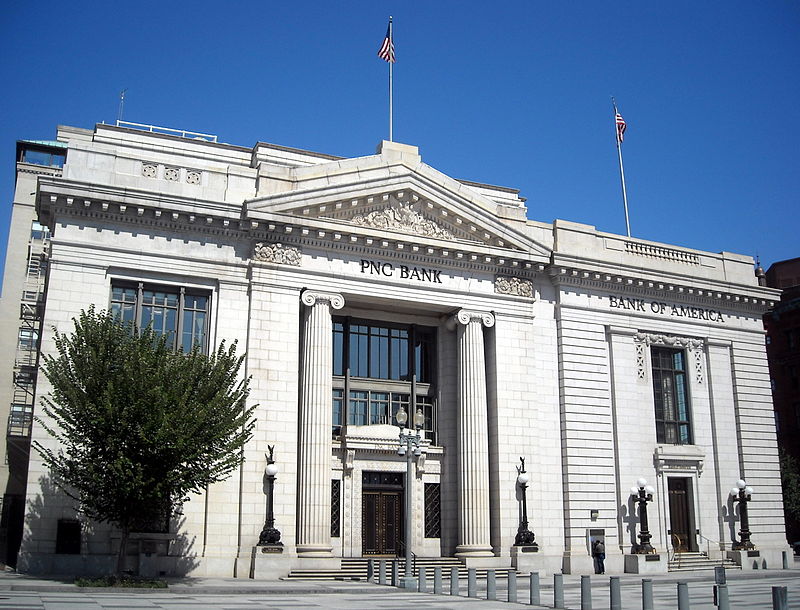
The reason for the change in ownership of the bank was the investigation of Riggs Bank for several money-laundering scandals, including “unknowingly” allowing the hijackers involved in 9/11 to transfer money “due to lax controls” at the bank…
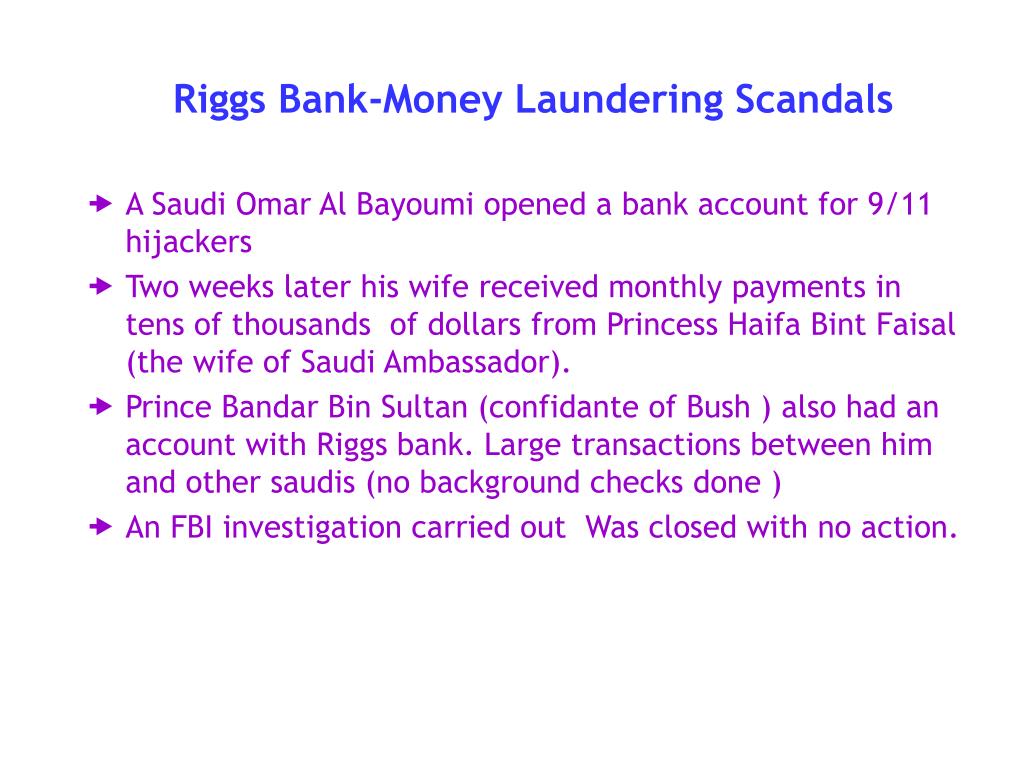
…allowing the former Chilean dictator Augusto Pinochet to hide his fortune after his accounts were frozen.

It is interesting to note that as a “National Bank,” Riggs was authorized to print currency at one time in its history.
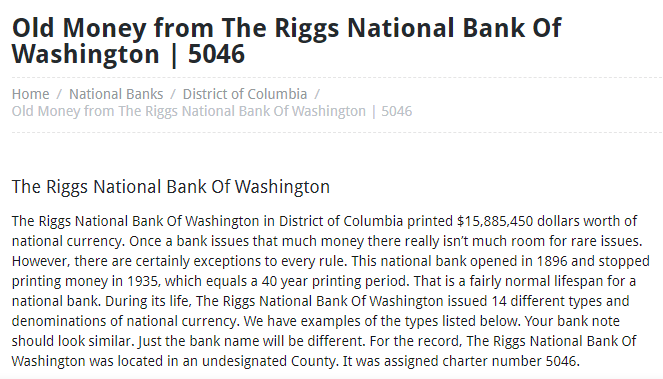
It is also interesting to note that one of the many definitions of “to rig” is to “manage or conduct something fraudulently to produce the result or situation that is advantageous to a particular person or party.”
Coincidence that a bank named after the last name of “Riggs” was implicated in money-laundering for other parties?
Are they telling us without telling us they are telling us?
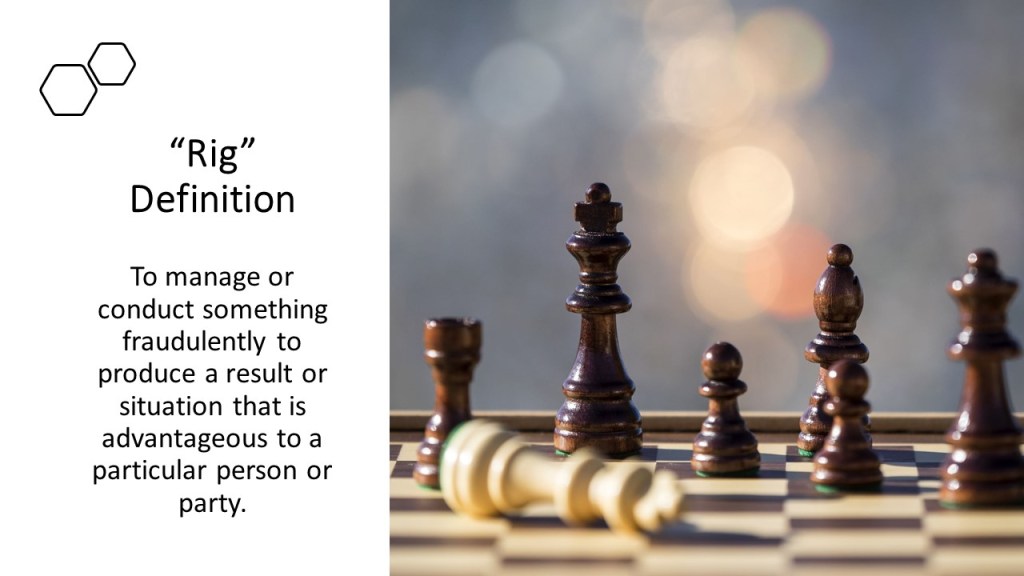
Lots of rabbit holes on this trail, once I started looking for information on this particular bank!

At any rate, as a result of his partnership with George Peabody went to live Baltimore in 1816, where he established his office and residence in the Henry Fite House, which was famous for where the Second Continental Congress met from December 20th of 1776 to February 22nd of 1777, becoming the nation’s seat of government for a brief period of time during the Revolutionary War.

The Henry Fite House burned to the ground in the Great Baltimore Fire of 1904.
The 1904 fire started at the John E. Hurst building near where the Henry Fite House was located in Baltimore…
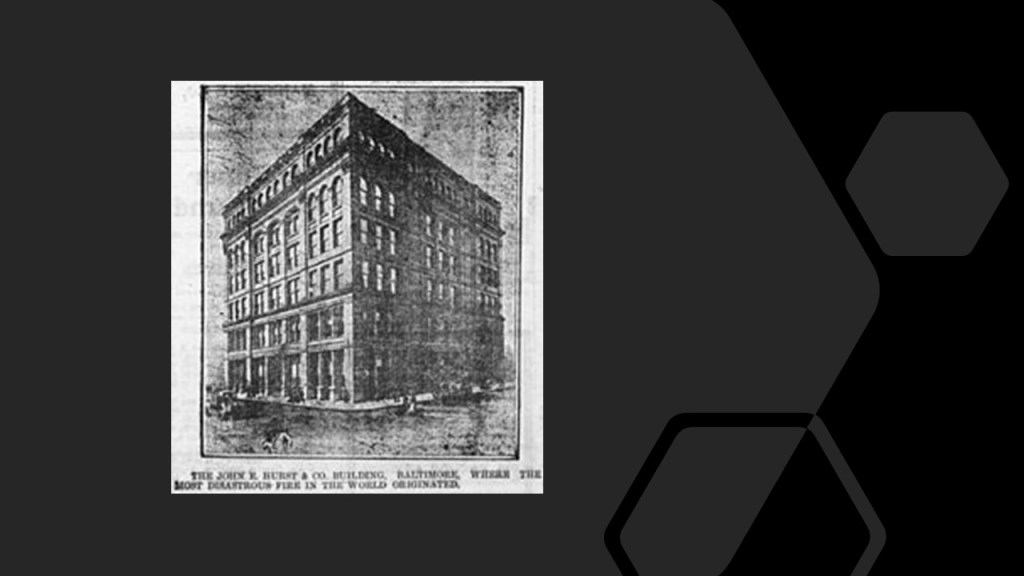
…and after burning for two days, left approximately 2,500 buildings either completely destroyed or severely damaged, and $100 million in property loss.
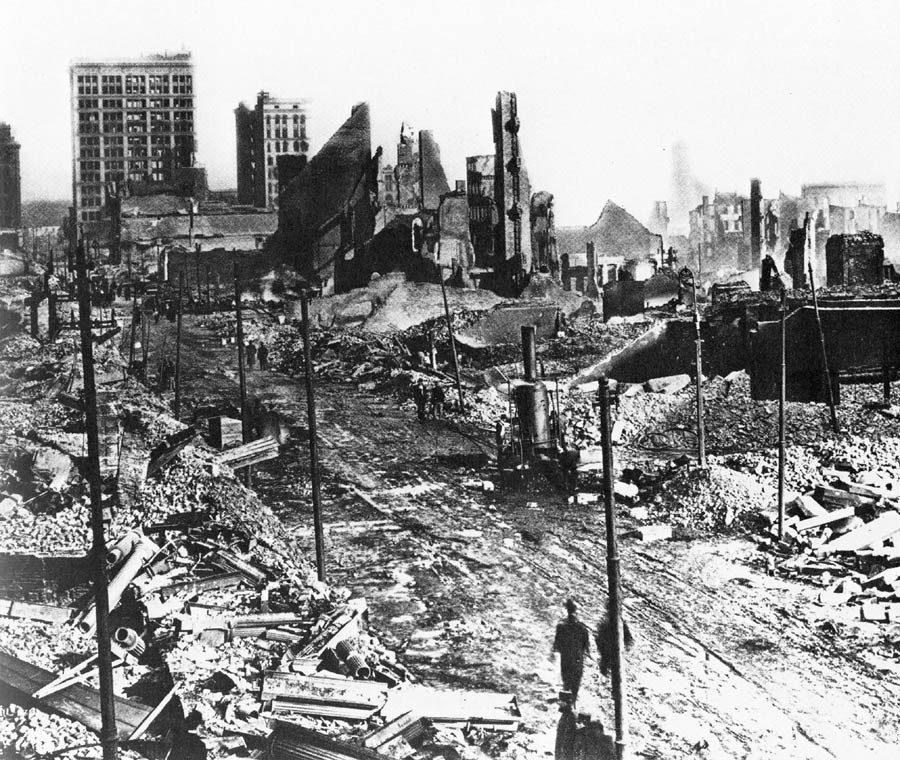
This is a good place to mention that there have been lots and lots of “Great Fires of ______” in our historical narrative, wreaking great destruction in cities the world over. Here is only a partial list from the mid-19th-century, as the list of fires truly goes on and on:
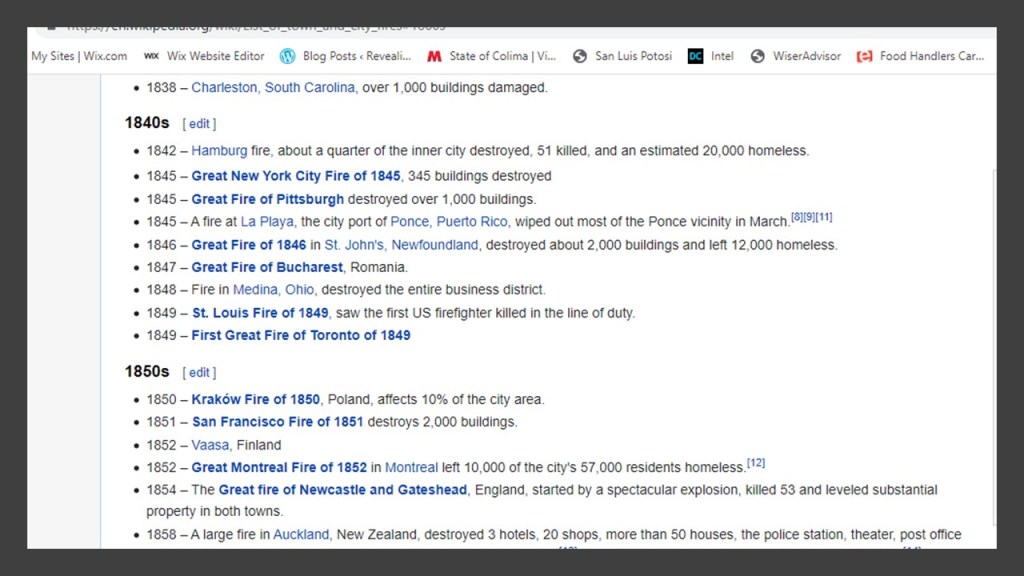
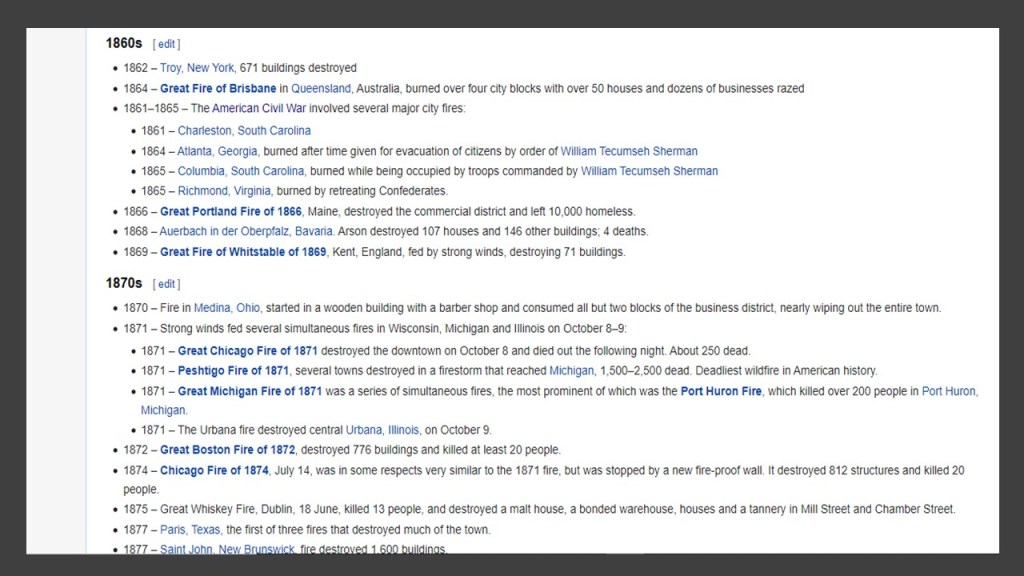
The Baltimore Civic Center was built where the Fite House and Hurst building once stood, which officially opened in October of 1962…
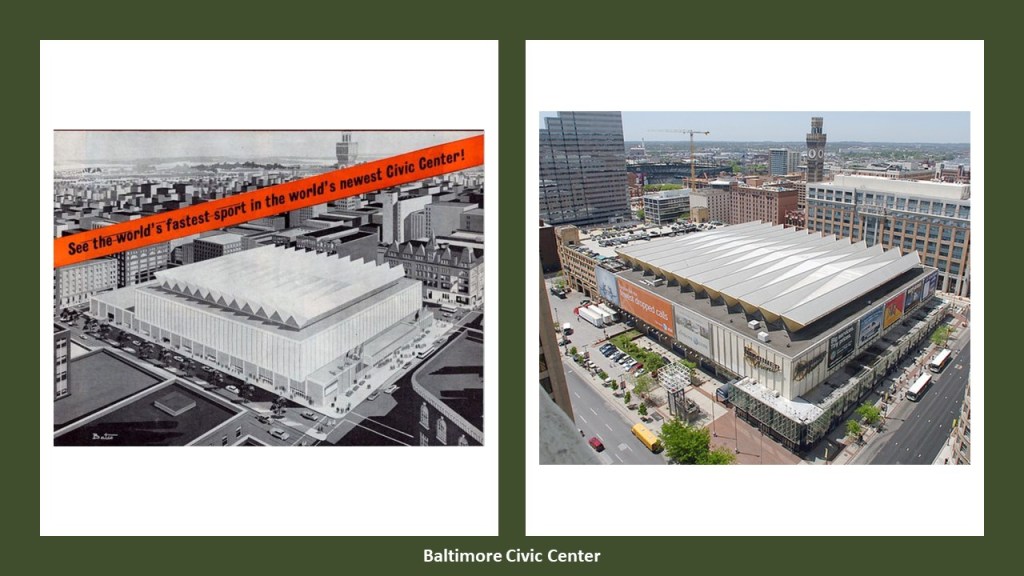
…and which has been known as the Royal Farms Arena since 2014, and is used primarily for sporting events and concerts.

Back to George Peabody.
During the years he lived in Baltimore, he established his career as a businessman and financier.
Here are some of the things I am finding about his business career.
He first travelled to England in 1827 to purchase wares, and negotiate the sale of American cotton in Lancashire.
This is interesting because by 1825, cotton was Britain’s biggest import, primarily from American cotton fields, and Lancashire was dominant force in the British economy with its cotton industry, where the raw cotton was turned into thread and fabrics in a factory-based production line with the advent of the Industrial Revolution in this industry, and marked the birth of the British-working class.

George Peabody opened an office in Liverpool, with British business playing a more and more important role in his business affairs.
The bankers who helped establish him in Liverpool included the son of the Irish-born banker in America, Alexander Brown, Sir William Brown, 1st Baronet of Richmond Hill, who managed his father’s Liverpool office.

Alexander Brown, an Irish linen merchant who immigrated to America, established the first investment banking firm in the United States in 1800.
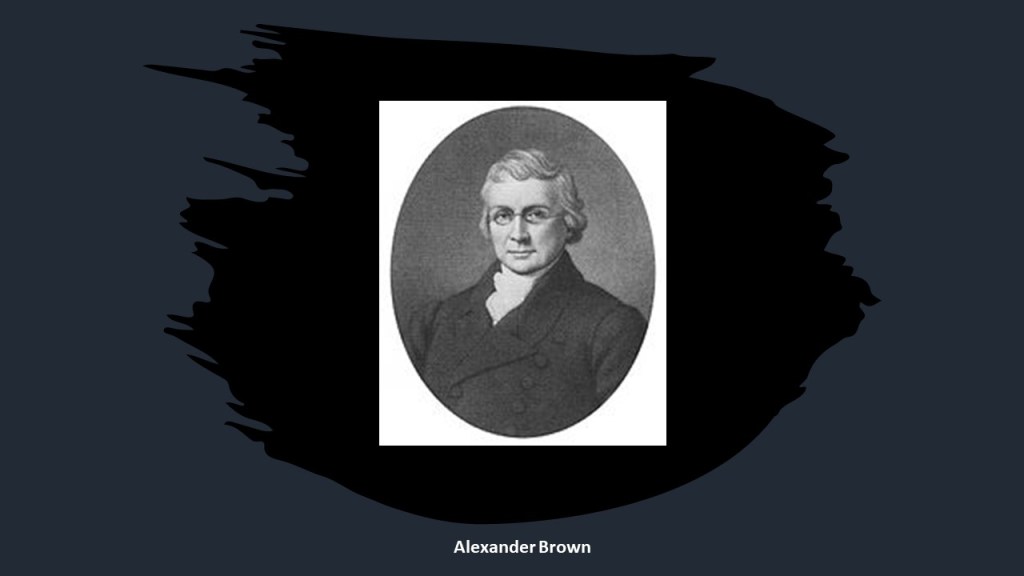
He was joined in business by his sons William, George, John, and James, and the firm became “Alex. Brown & Sons” in 1810.
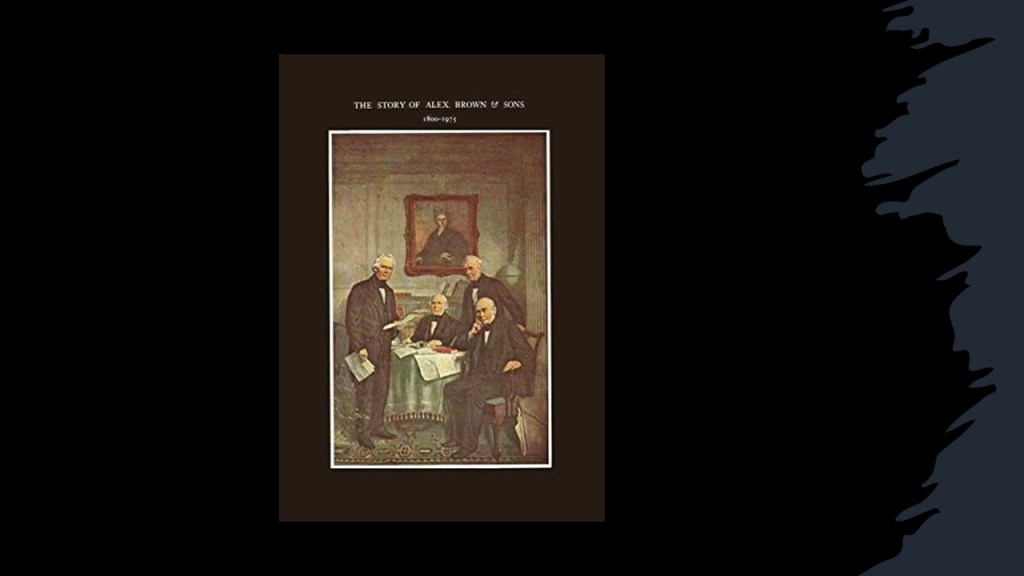
So his son William established the Liverpool office of the family business; George and John founded “Brown Bros. & Company” in Philadelphia, Pennsylvania; and James opened a branch in New York City and Boston.
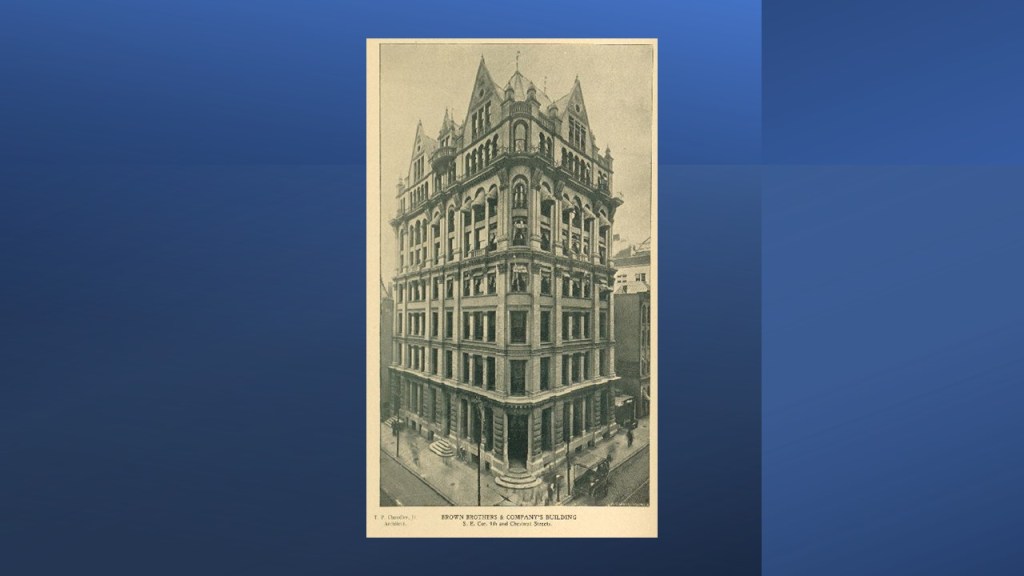
This is what we are told about Brown Brothers & Company, that during the first 100-years of its existence, it helped make paper money standard currency in the United States; underwrote the first railroad and trans-Atlantic steamship companies; and essentially created the first foreign exchange system between the American dollar and the British pound.

In 1931, the Brown Brothers merged with the Harriman Brothers & Company, a private bank started with railway money, in 1931 to become known as the “Brown Brothers Harriman & Company,” one of the oldest and largest private investment banks in the United States.
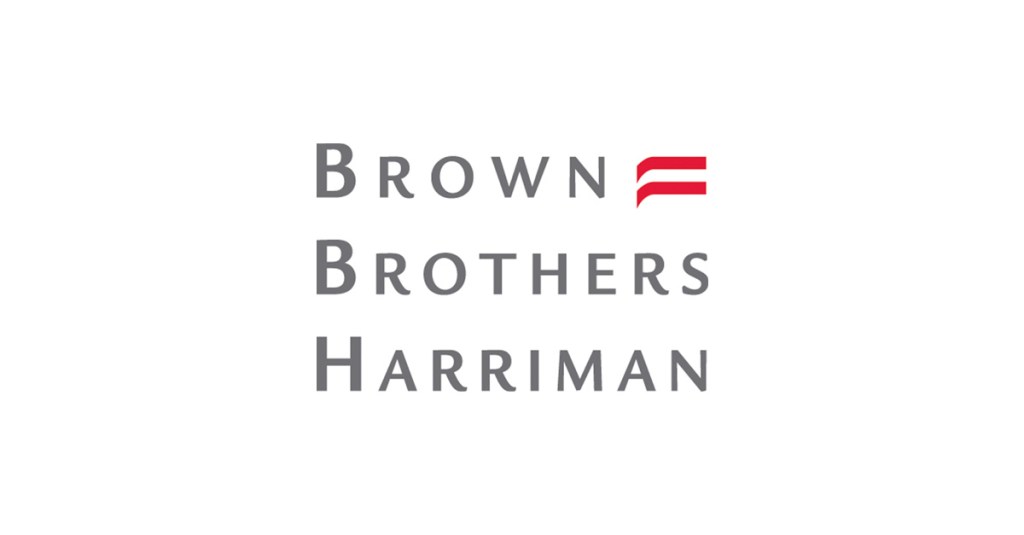
Founding partners of the “Brown Brothers Harriman & Company” included W. Averill Harriman, the son of railroad baron E. H. Harriman, and Secretary of Commerce under President Harry S. Truman…

…and Prescott Bush, American banker and politican, and the father of President George H. W. Bush.
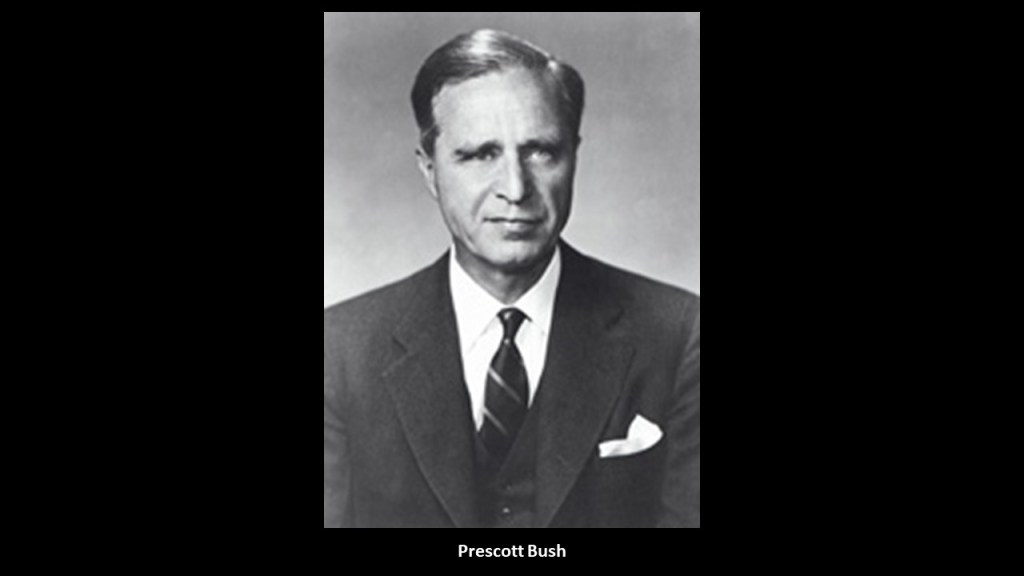
Alexander’s son George stayed in Baltimore and took a leading role in the founding of the Baltimore & Ohio Railroad in 1827, and became the head of the business branch upon Alexander’s death in 1834.
The “Alex. Brown & Sons” company proclaimed itself “America’s Foremost International banking enterprise in the 19th-century.”
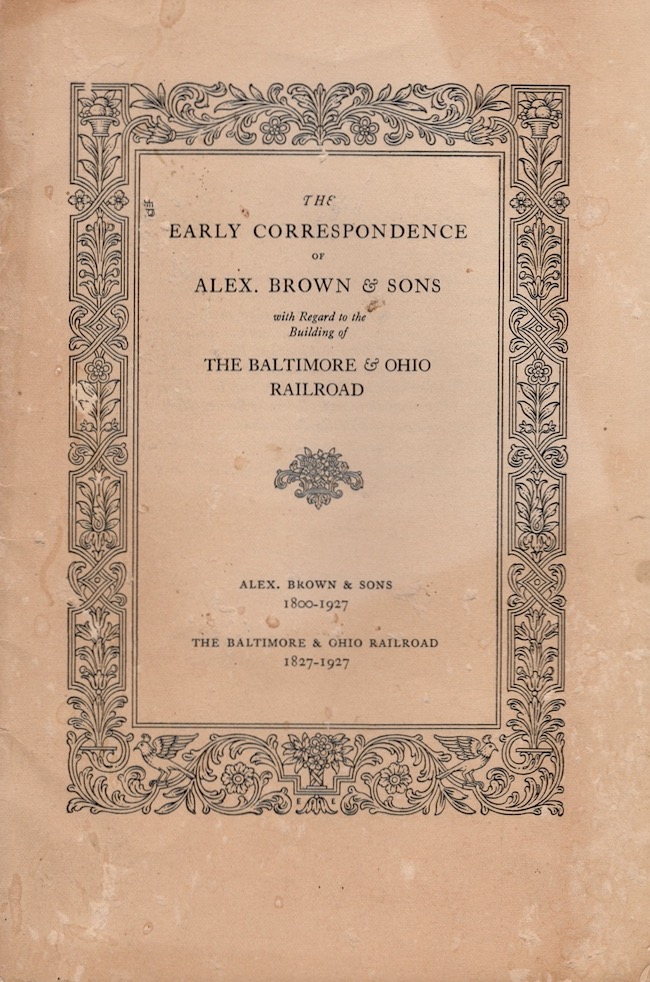
This bank building for “Alex. Brown & Sons” was said to have been built in in 1901, and survived the 1904 Great Fire of Baltimore, having the least amount of damage of any building within the “Burnt District.”

Since then, the building has served as a “Capitol One” Branch, and in 2019 became the “Alex Brown Restaurant,” only to be permanently closed in 2020 because of the pandemic.
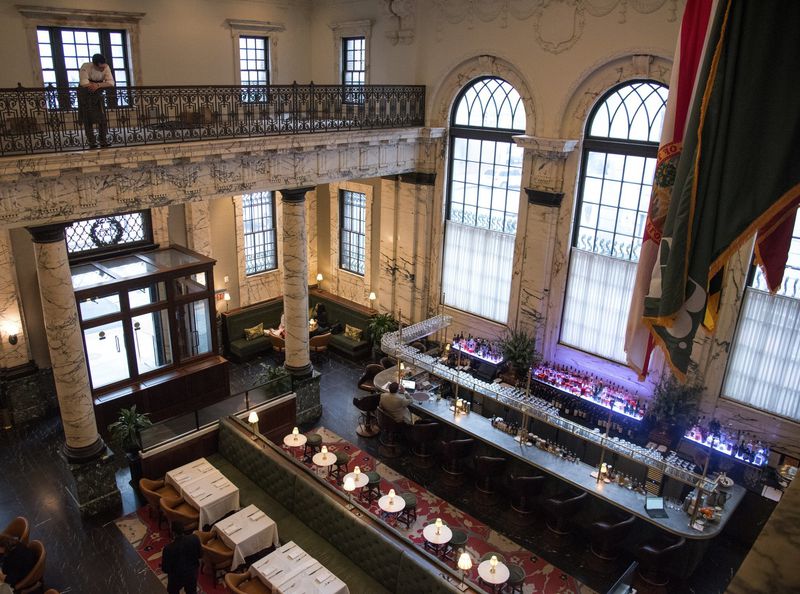
The company “Alex. Brown & Sons” was purchased by the Bankers Trust in 1997, absorbed into Deutsche Bank in 1999, and Alex Brown Wealth Management was sold to Raymond James in 2016.
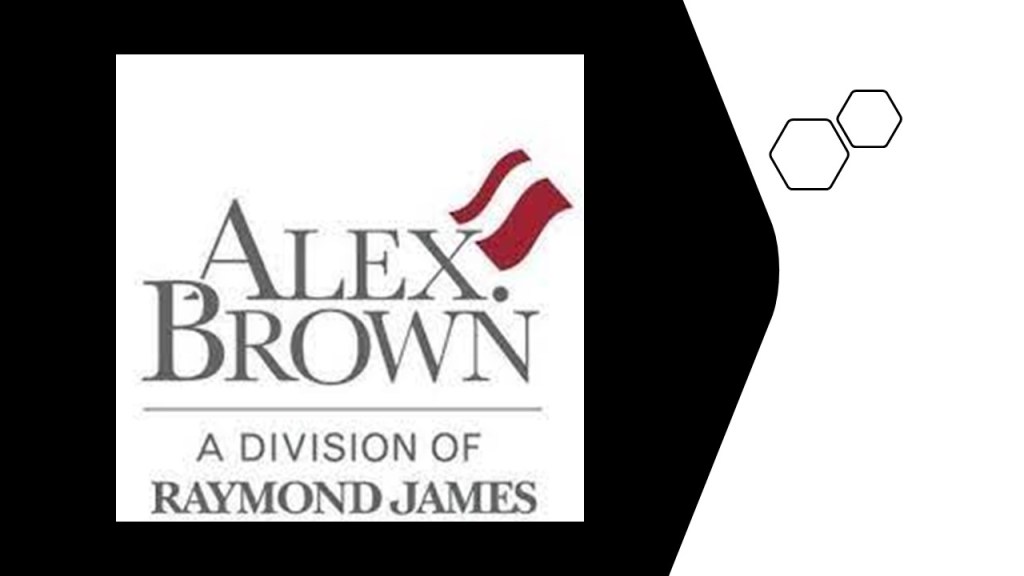
This man was Alex. Brown’s Chairman in 1998…
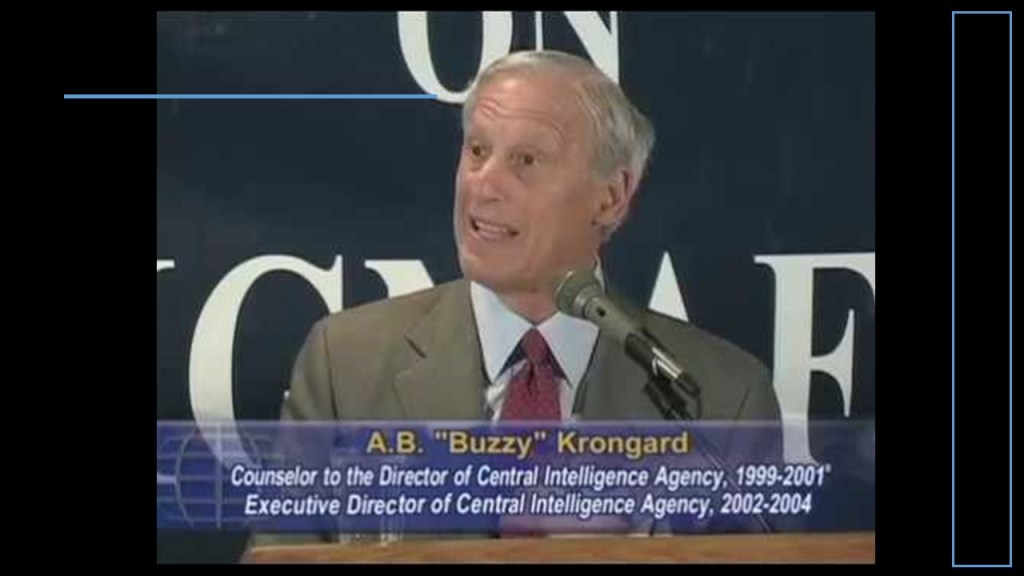
“Alex. Brown & Sons” sure sounds like the American-Irish version of the Rothschild International Banking family dynasty, started by Mayer Amschel Rothschild in Frankurt in the 1760s, who established an international banking family through his five sons:
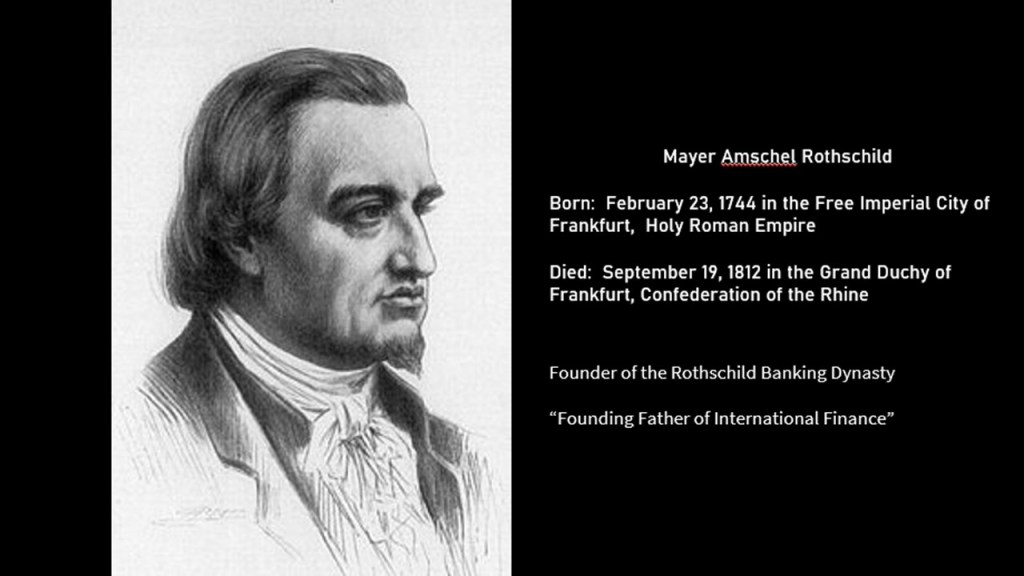
His oldest son, also Amschel Mayer Rothschild, succeeded his father as the head of the Frankfurt bank.
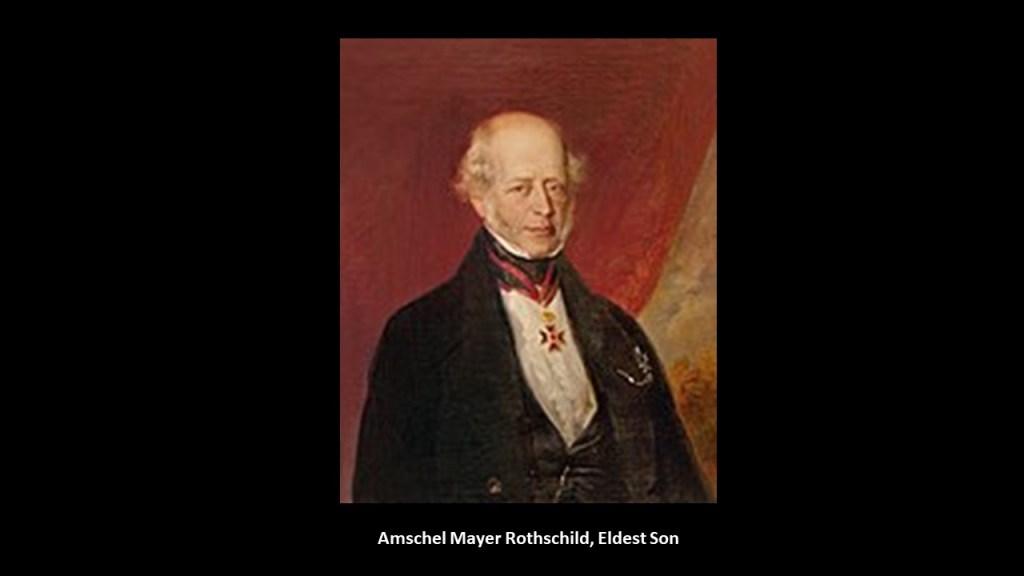
Nathan Mayer Rothschild settled in Manchester, England in 1798, and established a business in textile trading and finance, and made a fortune in a banking enterprise he began in London in 1805 that dealt in foreign bills and government securities.

Nathan had become a freemason in London of the “Emulation Lodge, No. 12, of the Premier Grand Lodge of England” in October of 1802.
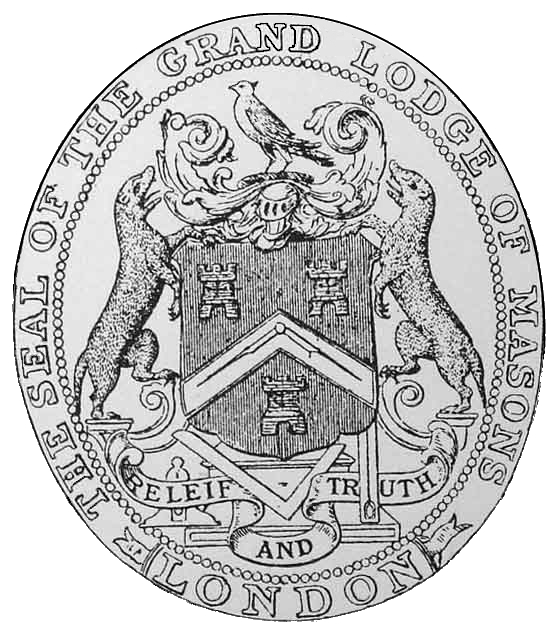
By the time of his death in 1836, Nathan Mayer Rothschild had secured the position of the Rothschilds as the preeminent investment bankers in Britain and Europe, and his own personal net worth was over 60% of the British national income.
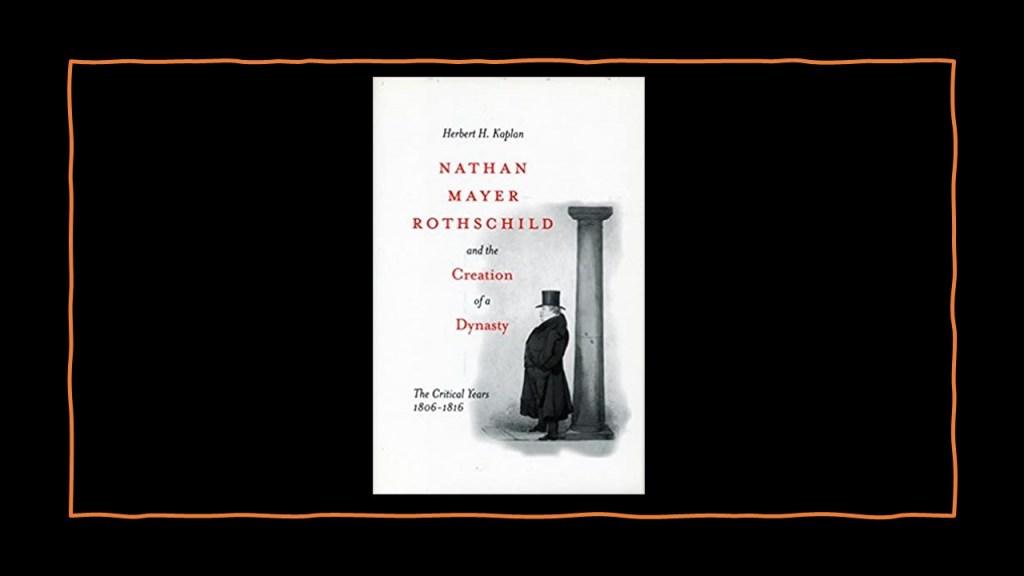
Mayer Amschel’s son Salomon Mayer von Rothschild went to Austria, and established the “S M von Rothschild” banking enterprise in Vienna in 1820, and was raised to the Austrian nobility as a baron in 1822, with the offer extended to all of his brothers, and which Nathan turned down.
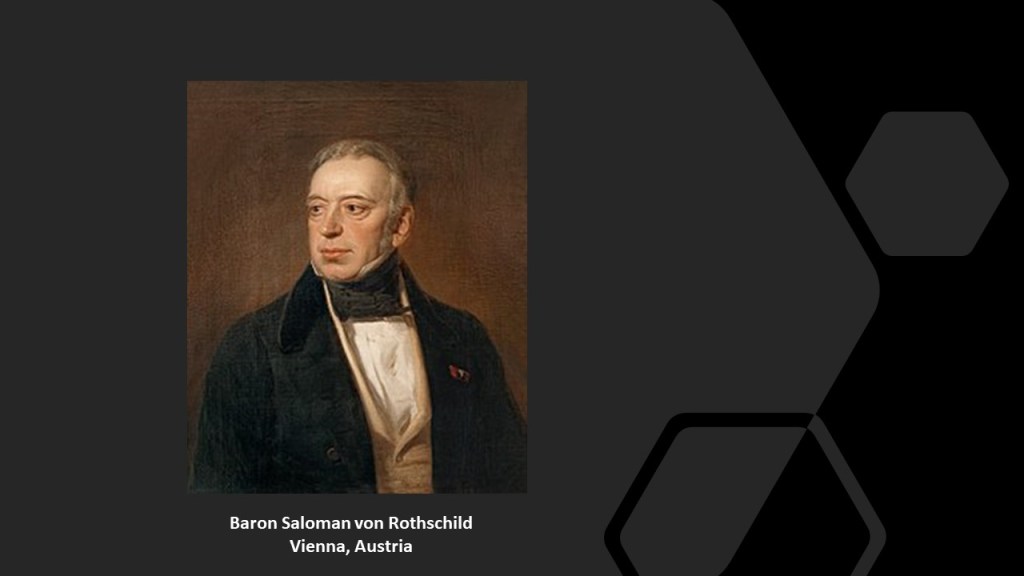
Among other major funding projects in Austria, his banking enterprise financed the Nordbahn Rail Transport Network, Austria’s first steam railway.

Mayer Amschel’s son Carl Mayer von Rothschild went to live in the “Kingdom of Sicilies,” located in Southern Italy between 1816 and 1860, in 1821.
He set up C M de Rothschild & Figli, which became the dominant financial house in Naples and operated as a satellite office to the main Rothschild bank in Frankfurt.
Clients of the Naples Rothschild bank included the Vatican, the Dukes of Parma and the Dukes of Tuscany.
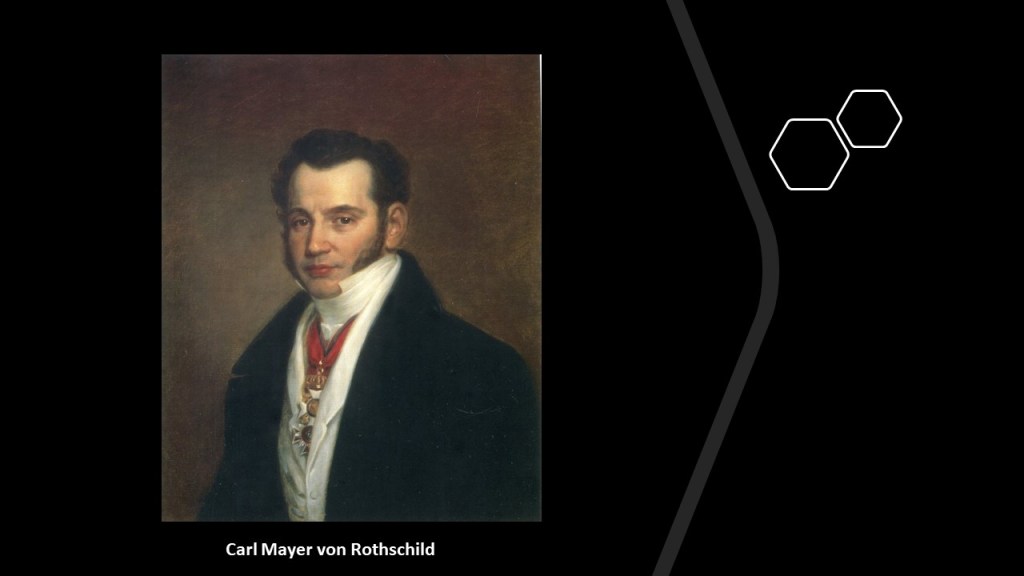
James Mayer de Rothschild was the founder of the French branch of the Rothschild family, moving to Paris in 1812 to coordinate the purchase of specie (money in the form of coins rather than notes) and bullion (gold and silver in bulk before coining, valued in weight) for his brother Nathan back in London, and in 1817, opened the De Rothschilds Freres (The Rothschild Brothers) bank in Paris, and by 1823, was firmly established as the banker to the French government.
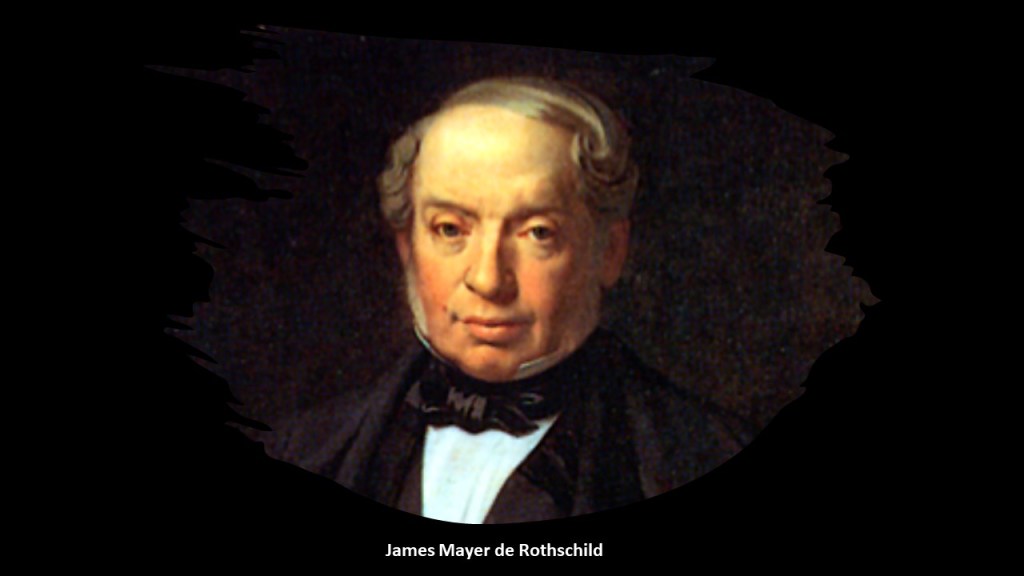
Just looking at parallels in the historical record between the Irish-American Brown business history, the German-Jewish Rothschild business history, and the born-into-poverty George Peabody’s business history, all which included links to textile merchants, banking and railroads.
With all of his great connections, George Peabody branched out.
He took up residence in London permanently in 1837, and went from being a wholesale dry-goods and cotton merchant, to a merchant-banker offering securities in American railroad and canal enterprises to British and European investors.
He started a banking business trading on his own account a year after he moved to London, and by 1851, he established the banking firm of “George Peabody & Company” to meet the increasing demand for securities issued by American railroads, and his company specialized in financing governments and large companies.
Apparently railroad and canal developers in the early 19th-century in the United States needed investment capital, and turned to European money markets for the funding to complete their projects.

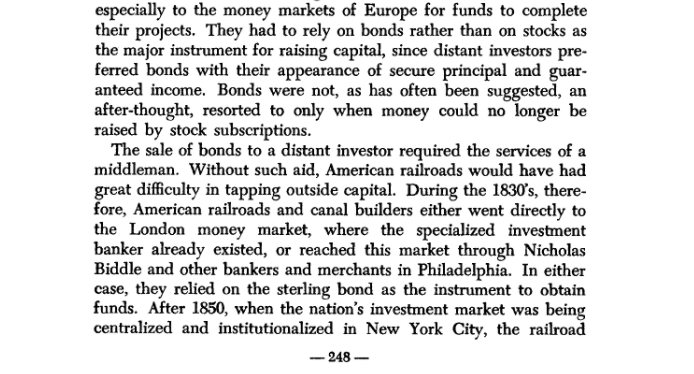
George Peabody’s bank quickly rose to become the premier American banking house in London, and this is a statue of him that is located near the Royal Exchange in London.

The same year that George Peabody formally established his banking company, 1851, was the same year that the Great Exhibition of All Nations took place, better known as the Crystal Palace Exhibition, and was something he was really keen about!
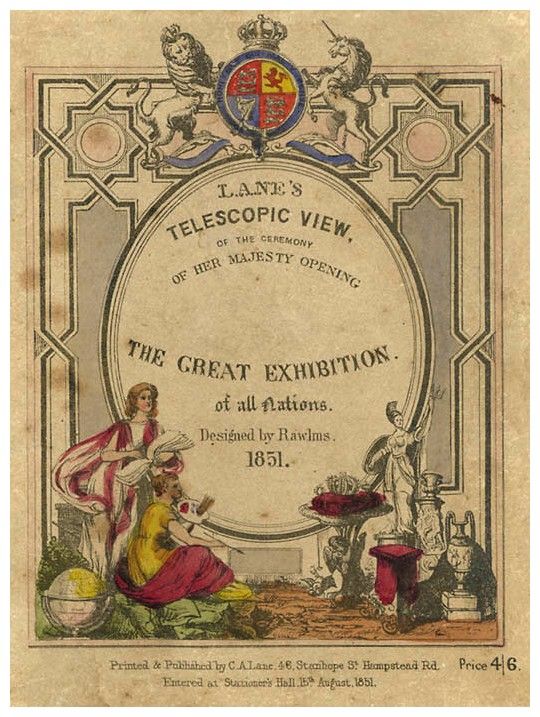
The purpose of the first Great Exhibition in 1851 was said to be making clear to the world Britain’s role as industrial leader, while at the same time it provided a platform on which other countries from around the world could display their achievements.
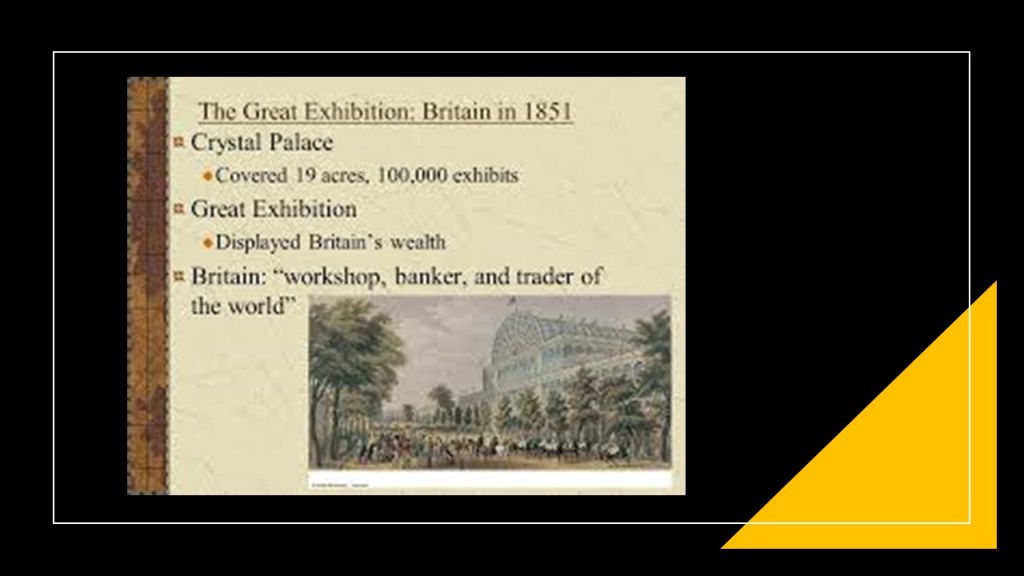
The reference to the Crystal Palace Exhibition was the allegedly temporary structure in which it was held…
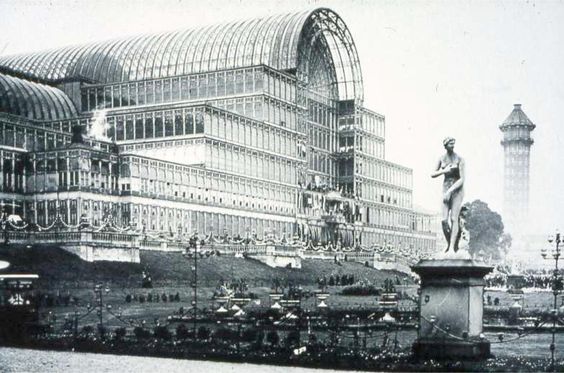
…which had a high-level railway station…

…and an underground station.

The ornate pillars of the Crystal Palace Underground Station reminded me of ones, in the middle, of the Old Portuguese Fort on Hormuz Island in the Strait of Hormuz, located between the United Arab Emirates and southern Iran, and part of the Iran’s Hormozgan Province, and the underground pillars of the Upper Roxborough Reservoir in Philadelphia, Pennsylvania, on the right.
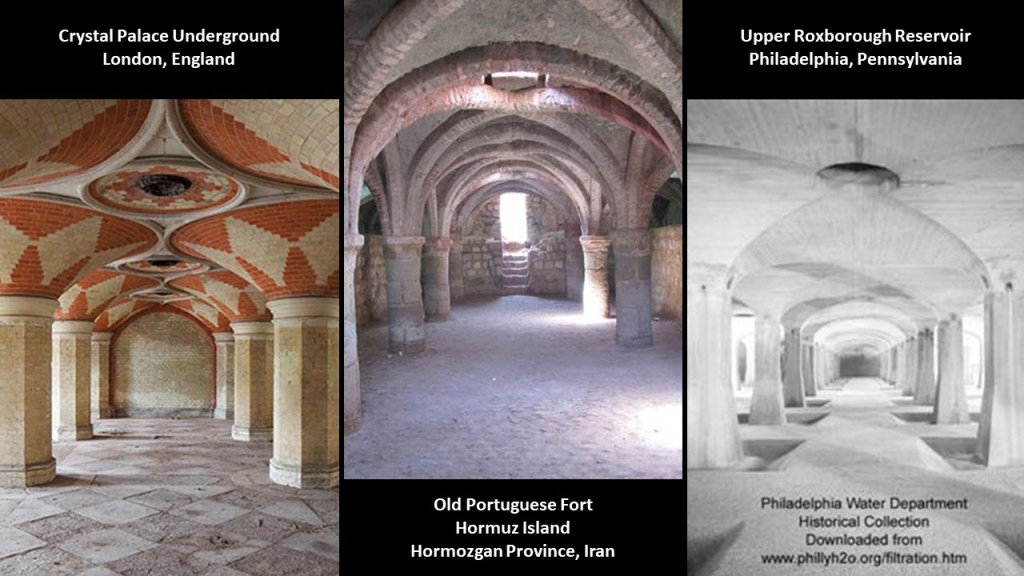
This is important information because of what I think was really going on here.
I think that Exhibitions, Expositions, and World Fairs, starting with the Crystal Palace Exhibition in 1851, were actually showcasing the technology and architectural wonders of the original advanced Human civilization before the wonders were hidden away or forever destroyed, and that “building” going on in large part was actually digging-out the original infrastructure from the mud flows of a deliberately-caused cataclysm that covered the Earth in mud.
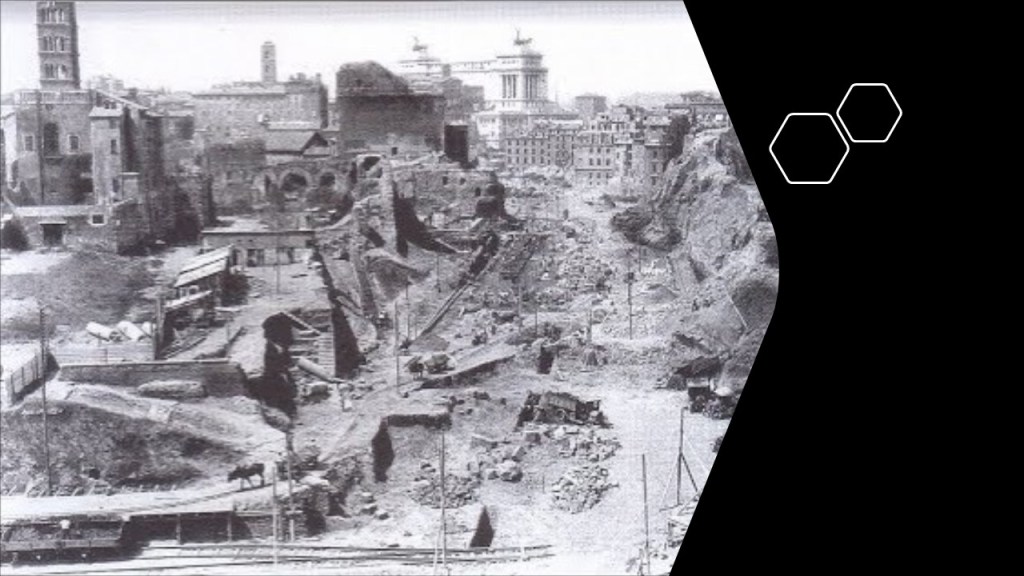
I believe the 1851 Crystal Palace Exhibition was the official kick-off of the New World Order timeline, and the history we learn about regarding the Victorian-era in the 19th-century and very early 20th-century, was actually telling us about when the largest-part of the new historical reset narrative was being put into place
We are told that it took only 9-months to develop the first Great Exhibition in London, from plans and organization to the Grand Opening with Queen Victoria.

It was organized by Sir Henry Cole, British civil servant and inventor, and Prince Albert, the husband of Queen Victoria.
The Crystal Palace was said to have been designed by Sir Joseph Paxton, a gardener and greenhouse builder, and built in Hyde Park to house the Exhibition.
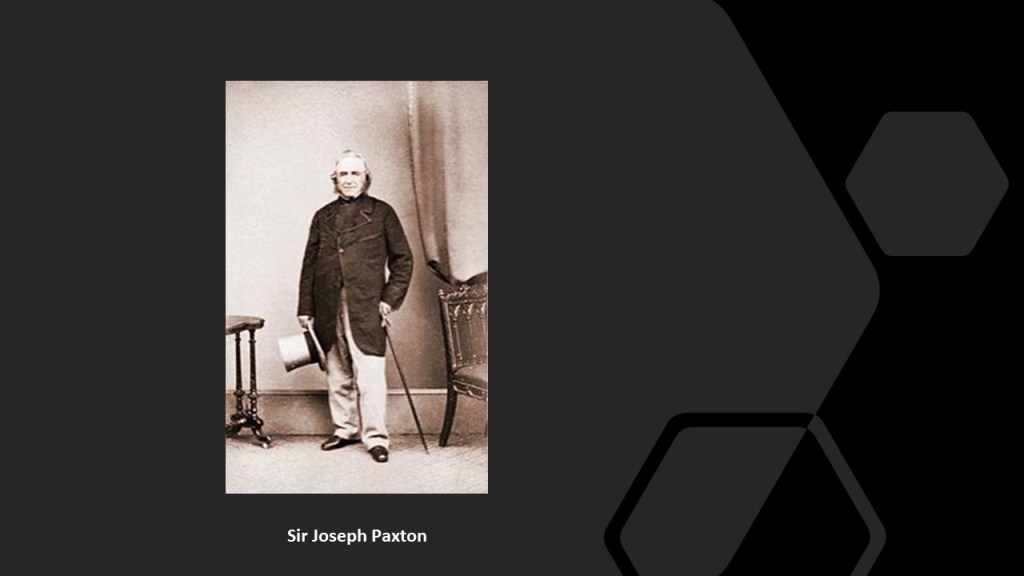
Sir Joseph Paxton was also said to have been commissioned by Nathan Mayer Rothschild’s son, Baron Mayer de Rothschild, in 1850 to design the Mentmore Towers in Buckinghamshire, said to be one of the greatest country houses constructed during the Victorian era, and built between 1852 and 1854.
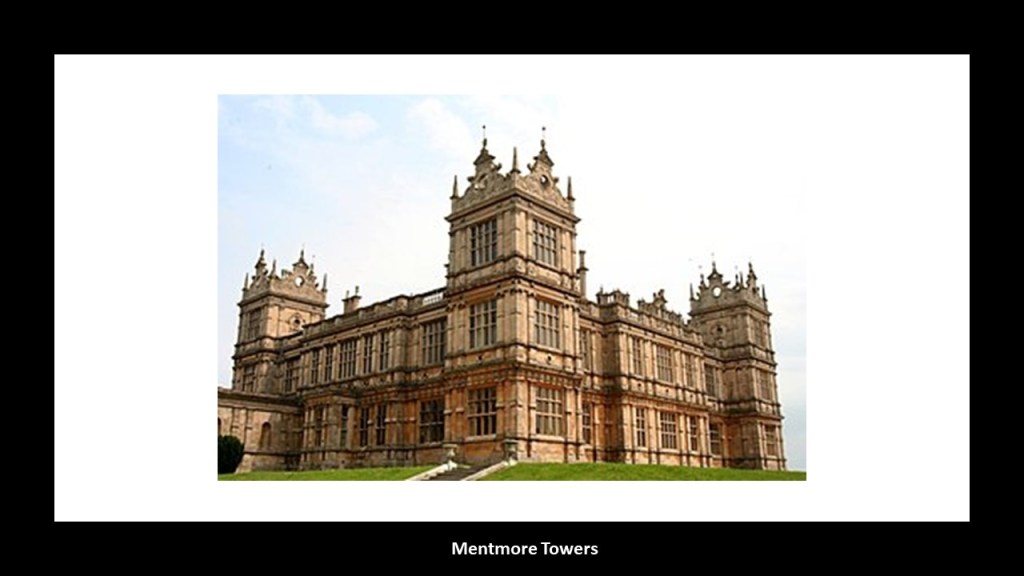
The Crystal Palace was described as a massive glass house that was 1,848-feet, or 563-meters, long, by 454-feet, or 138-meters, wide, and constructed from cast-iron frame components and glass. There were statues on the inside, and trees – said to demonstrate man’s triumph over nature.
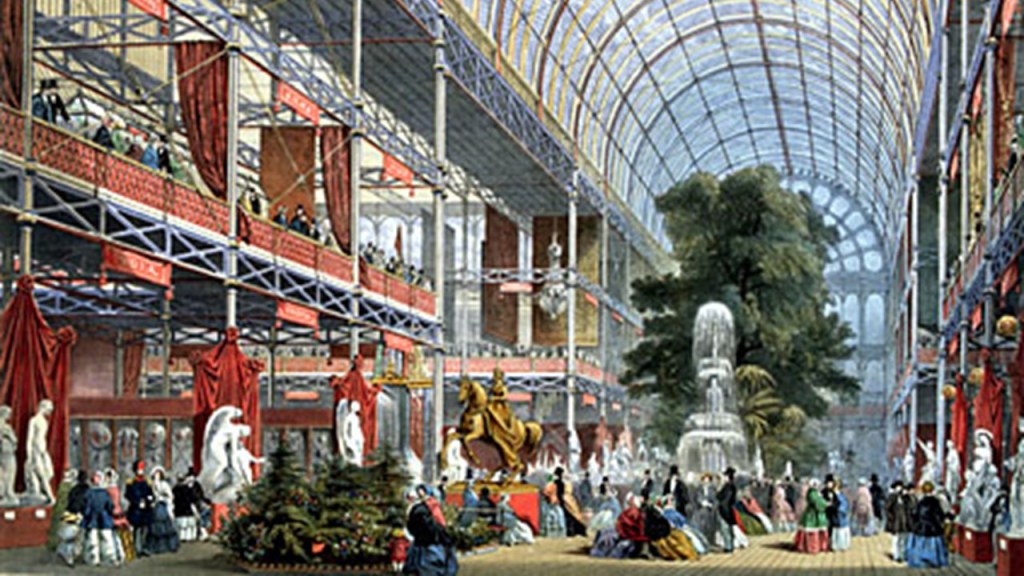
Between May 1st and October 15th of 1851, six-million people were said to visit the Exhibition, including famous people of the time like Charles Darwin, Samuel Colt, Charlotte Bronte, Charles Dickens, and Alfred Lord Tennyson.

The proceeds generated by the Great Exhibition of 1851 were then said to be used to found the Victoria and Albert Museum in 1852 on the left, which happens to look very similar to the Natural History Museum in Milan, Italy, which was said to have been founded in 1838, on the right.
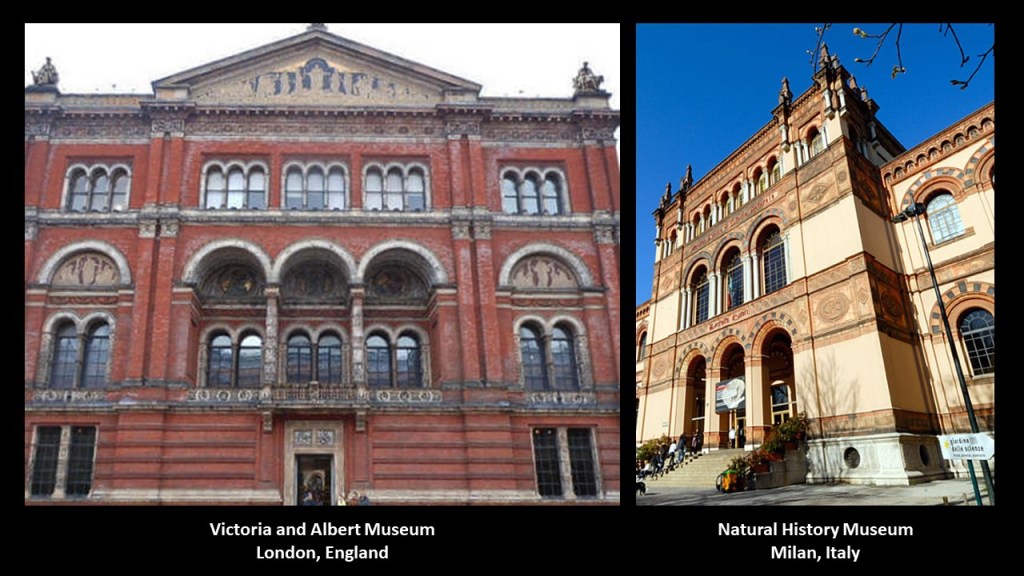
Proceeds from the Great Exhibition were also said to have been used to found the Science Museum in London in 1857…

…and the Natural History Museum in London in 1881.

What was the fate of the Crystal Palace itself?
We are told the Crystal Palace was moved and re-erected in 1854 to Sydenham Hill in South London.
How did they manage to move a massive building of plate-glass and cast-iron, said to be three times larger than St. Paul’s Cathedral in London?

It was later destroyed by fire in 1936.
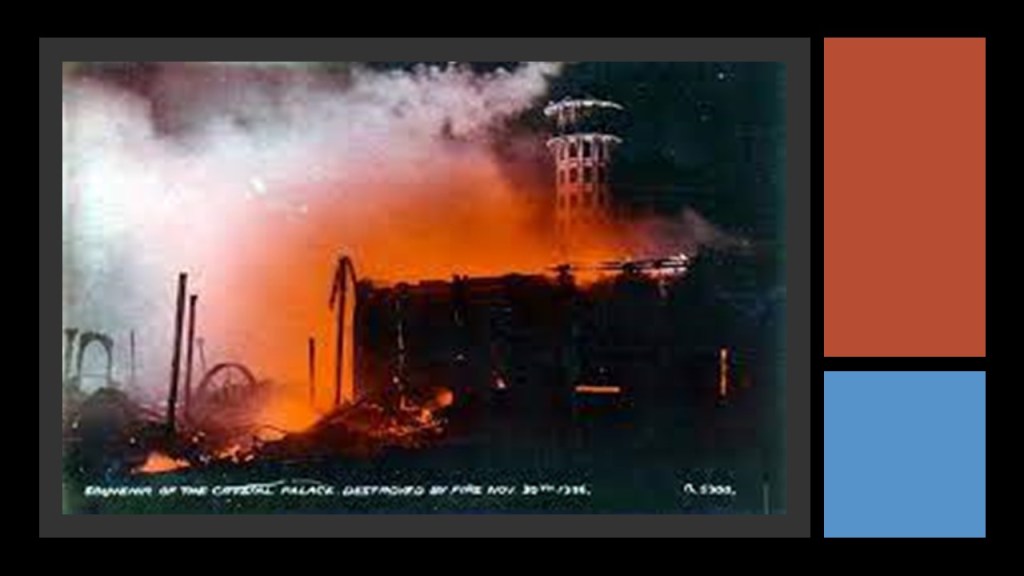
Where does George Peabody come into the story of the Crystal Palace Exhibition?
George Peabody, who was passionate about the Exhibition, made an offer of a loan of $3,000, about $15,000 in today’s value, to the American Ambassador to the Court of St. James, the royal court for the sovereign of Great Britain, Abbott Lawrence, that made it possible for the American Pavilion to be suitably prepared and decorated for the Exhibition since the United States Congress did not provide funds for it.
Peabody’s funding made possible the displays of the following American inventions: Robert Newell’s unpickable Parautoptic Lock…

…Samuel Colt’s revolvers, like this rare, cased, special-engraved, Colt “Baby Dragoon,” made for the 1851 Crystal Palace Exhibition…
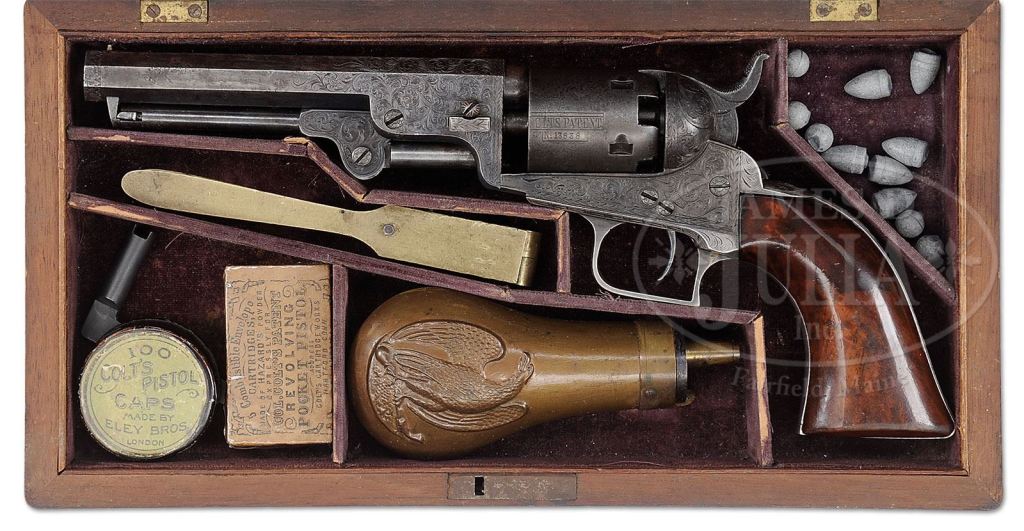
…the statue of the American neoclassical sculptor Hiram Powers called “The Greek Slave”…
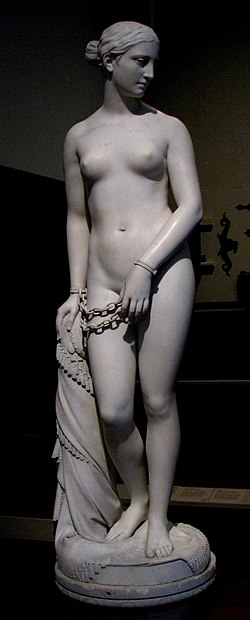
…which was placed in a central location at the Crystal Palace Exhibition…
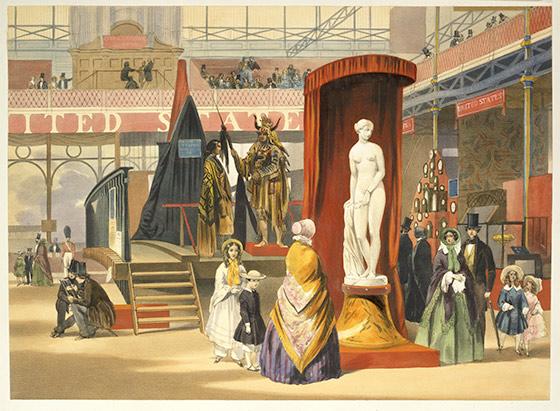
…and about which Elizabeth Barrett Browning had already written a sonnet.
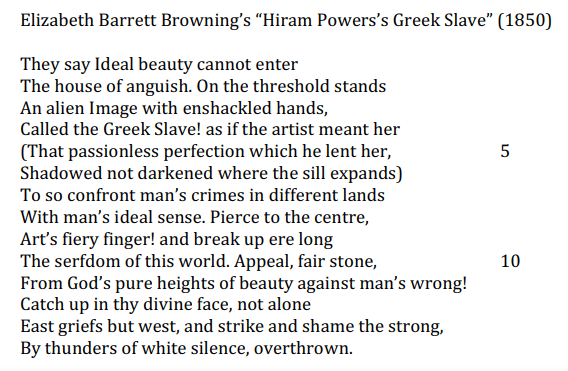
Cyrus McCormick’s reaper was also exhibited at the American Pavilion in the 1851 Exhibition…
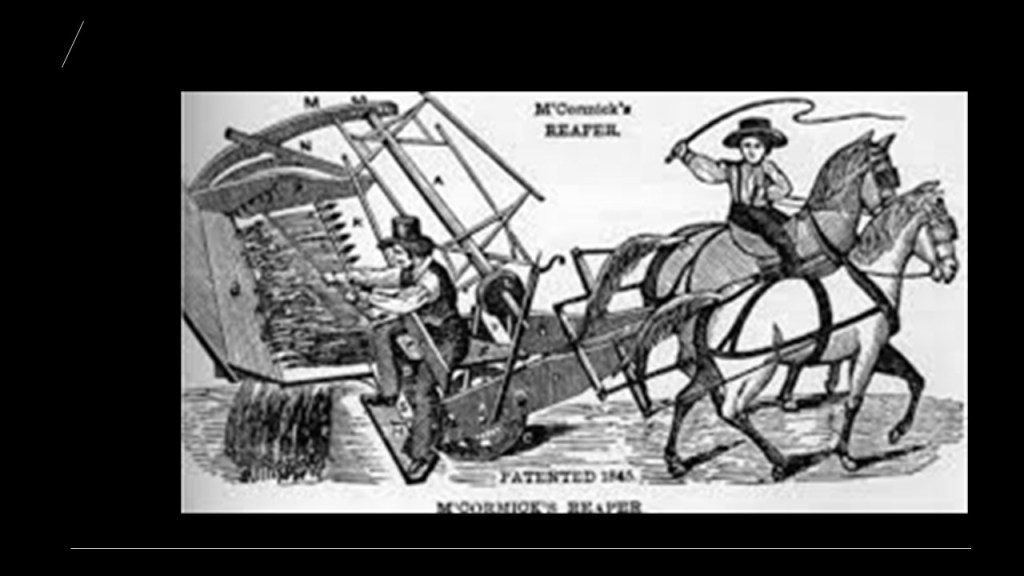
…as well as Richard Hoe’s rotary printing press.

This was the menu for a banquet, concert, and ball that George Peabody hosted after the start of the Crystal Palace Exhibition, on July 4th of 1851, in honor of the visiting Ambassador Lawrence and his wife.
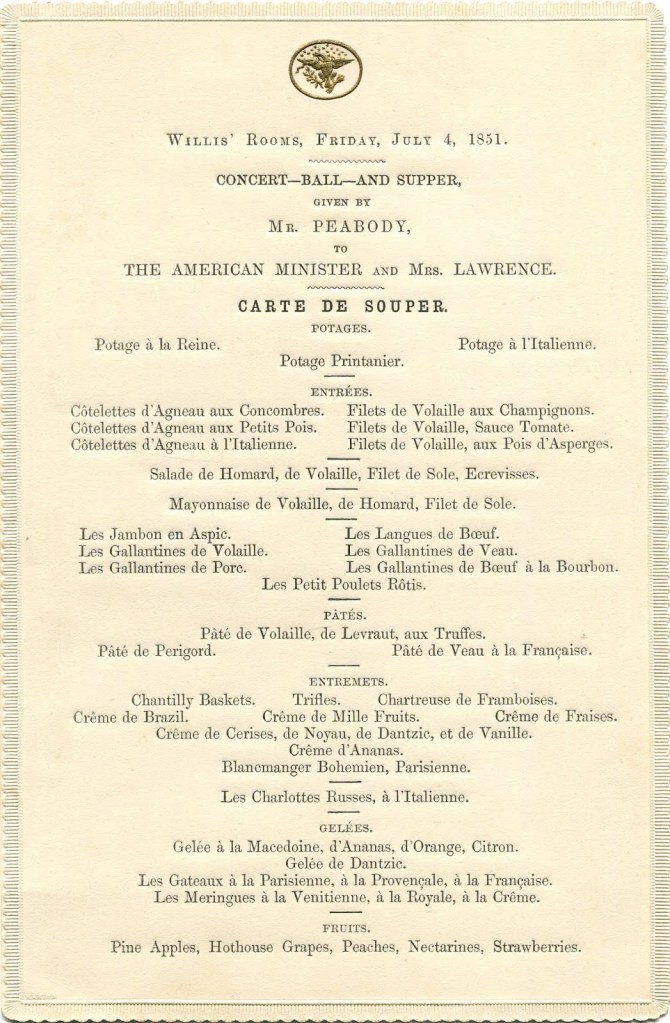
This elegant affair also signified George Peabody’s social emergence, and was attended by members of the British aristocracy, including the 82-year-old Duke of Wellington, the hero of the Battle of Waterloo, the battle in 1815 that marked the end of the Napoleonic Wars.
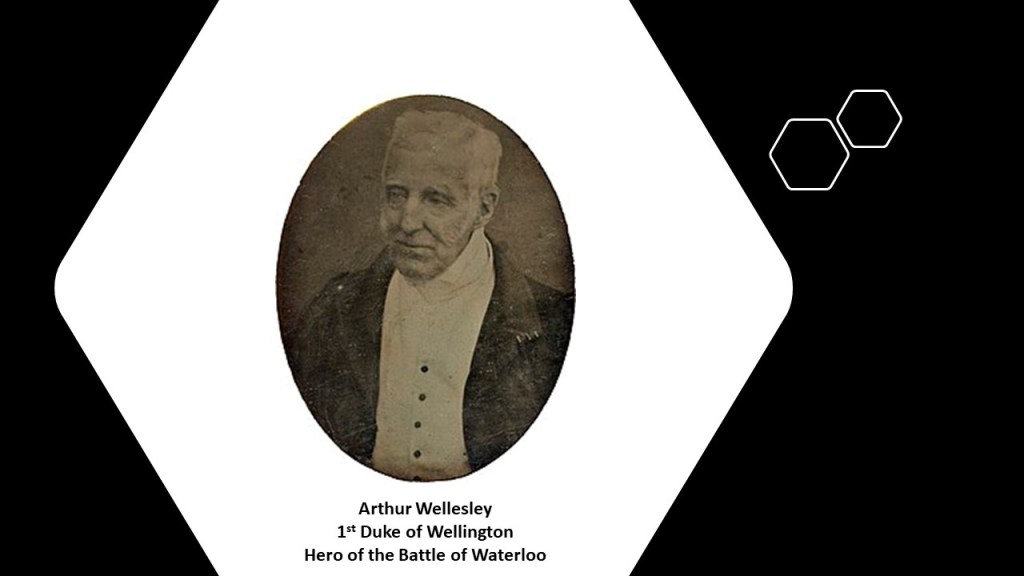
I don’t know if Charles Dickens based his famous miserly character, Ebenezer Scrooge, on George Peabody, but Dickens and Peabody were contemporaries of each other, but Peabody was known to be very thrifty…and miserly with his employees and relatives…and Dickens’ novella “A Christmas Carol,” featuring Scrooge, first came out in 1843, which would have been five-years after George Peabody moved to London.
And, like Scrooge, George Peabody never married.
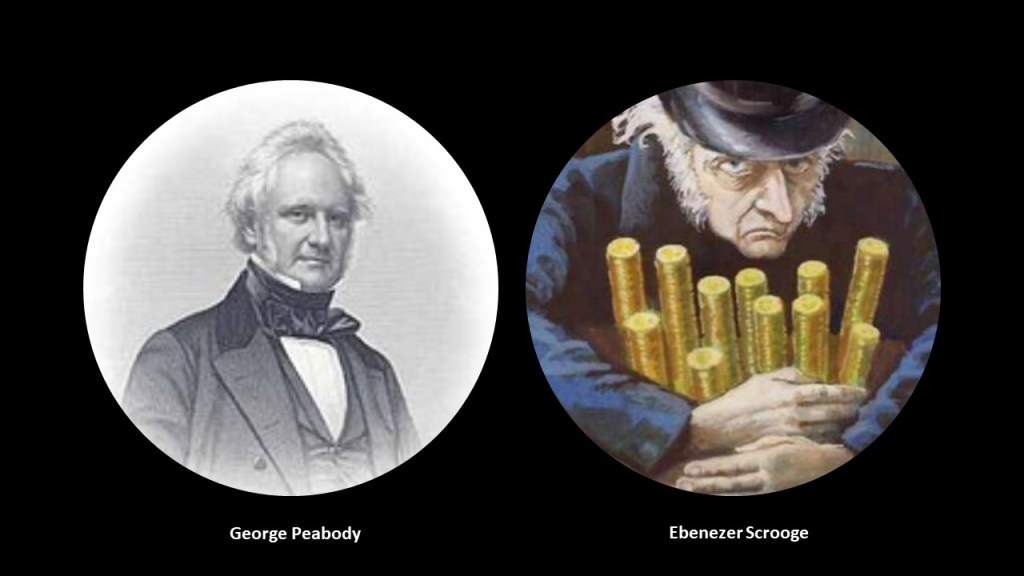
Just pure speculation on my part, but it was very interesting to discover in my research his personal thriftiness with money, even though he soon became famous for his philanthropic giving to charitable causes.
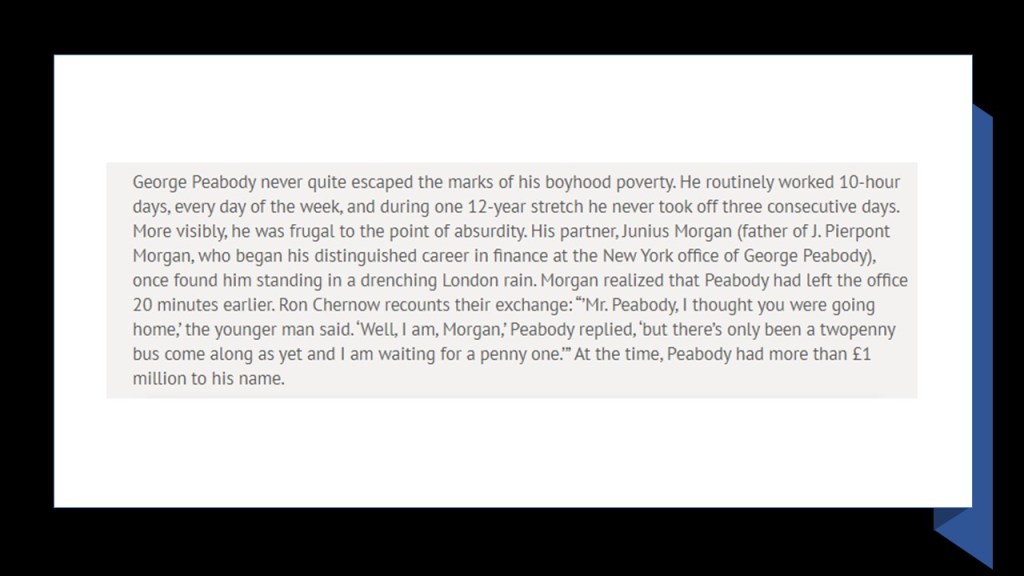
We are told that George Peabody’s interests began to turn to philanthropy in the early 1850s.
In the United States, George Peabody’s philanthropy was largely centered around education, and in Great Britain, his philanthropy took the form of providing housing for the poor.
We are told he donated $50,000 for the construction of a library sometime in the early 1850s in his birthplace, South Danvers, Massachusetts, and the location of the current library building, called the Peabody Institute, was said to have been built in 1891, after the first building for it, constructed between 1868 and 1869 was destroyed by fire in 1890.
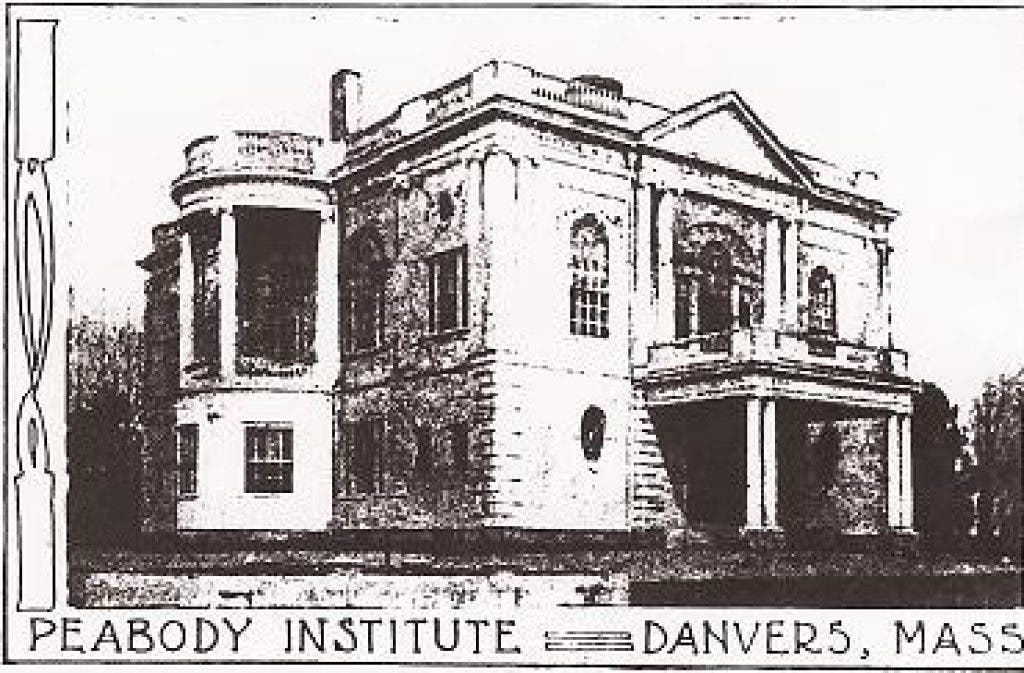
In 1857, he established the Peabody Institute in Baltimore with a bequest of at least $800,000, and it is the oldest conservatory in the United States.
By the time it was completed and opened in 1866, one year after the official end of American Civil War, it was dedicated by George Peabody himself,and included a music academy, library and art gallery.

The Peabody Institute is located directly across from the Washington Monument in Baltimore…
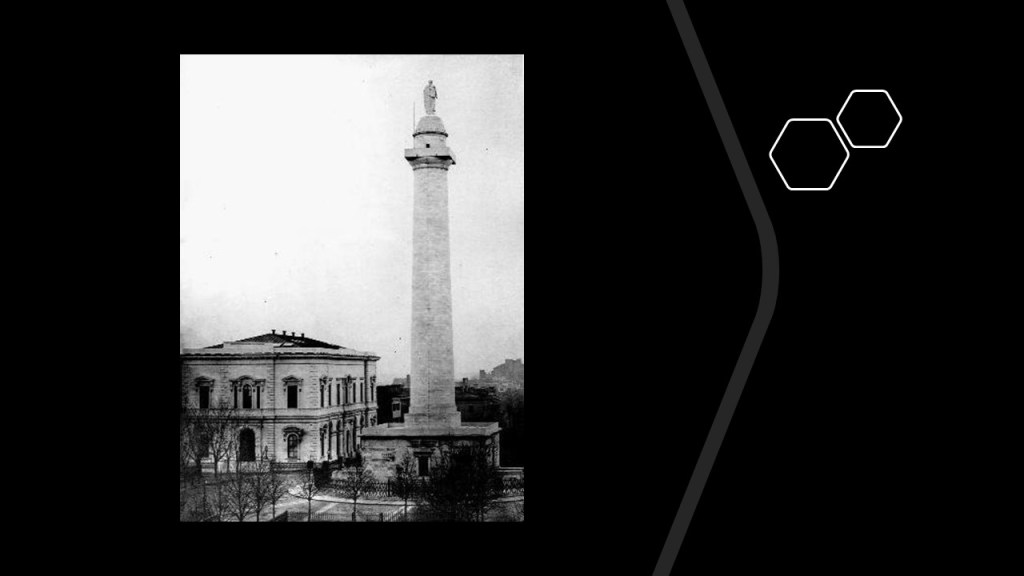
…the first major monument said to have been erected, between 1815 and 1829, to honor George Washington.

In Great Britain in April of 1862, George Peabody established the “Peabody Donation Fund,” which is known as the “Peabody Trust” today, with the stated goal of “providing housing of a decent quality for “the artisans and labouring poor of London.”
The first Peabody dwellings in London were “Spitalfields,” a district in London’s East End located on Commercial Street on the top left, which looks like what are known as “Flatiron” buildings, across the pond, examples of which are in San Francisco on the top right; New York City on the bottom left; and Seattle, Washington, on the bottom right.
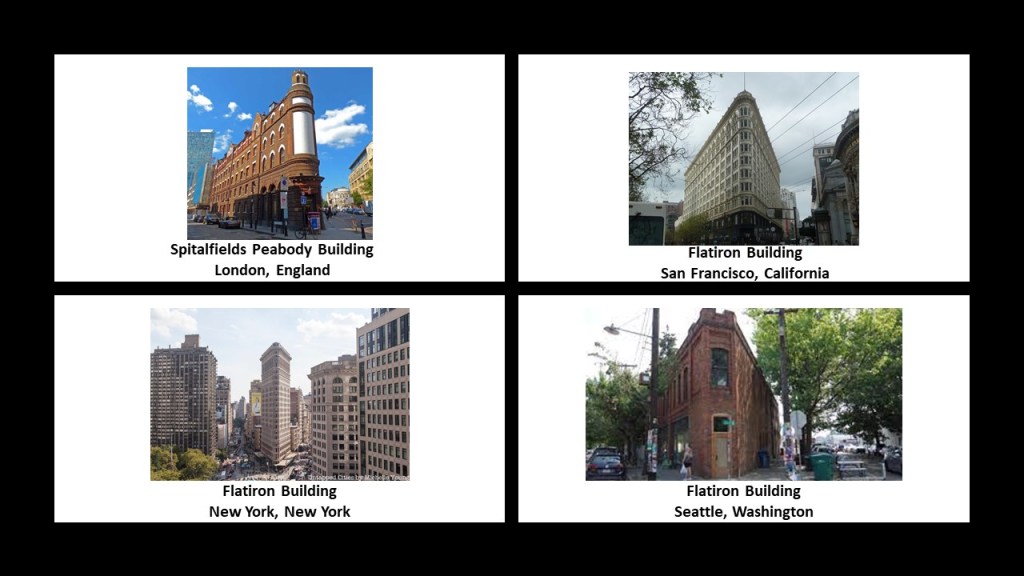
There were a number of strict rules for the new tenants to follow, but it immediately had more applicants than rooms available.
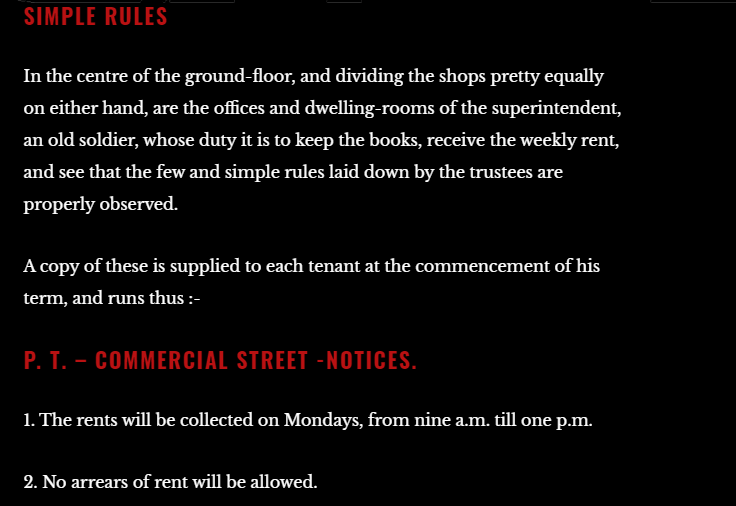
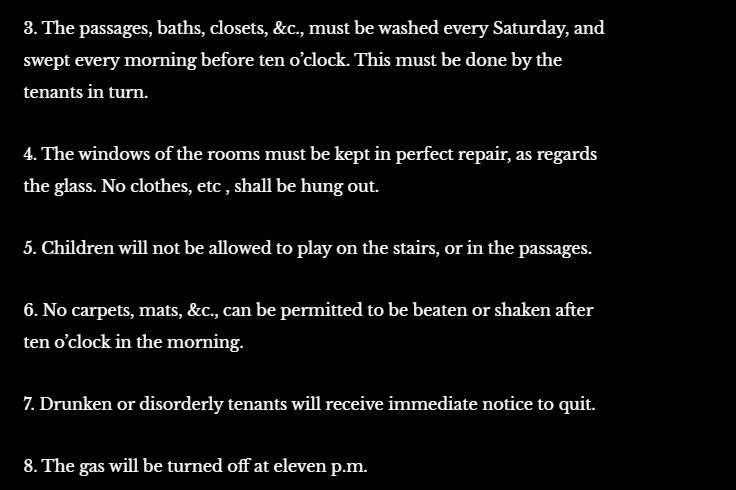

An interesting side-note about Spitalfields district in London that it was the location of the several of the notorious “Jack-the-Ripper” murders, which took place during the Victorian-era, in 1888.
The historical serial killer “Jack-the-Ripper” was never apprehended.


The Peabody Trust today has around 55,000 properties across London and the South East.
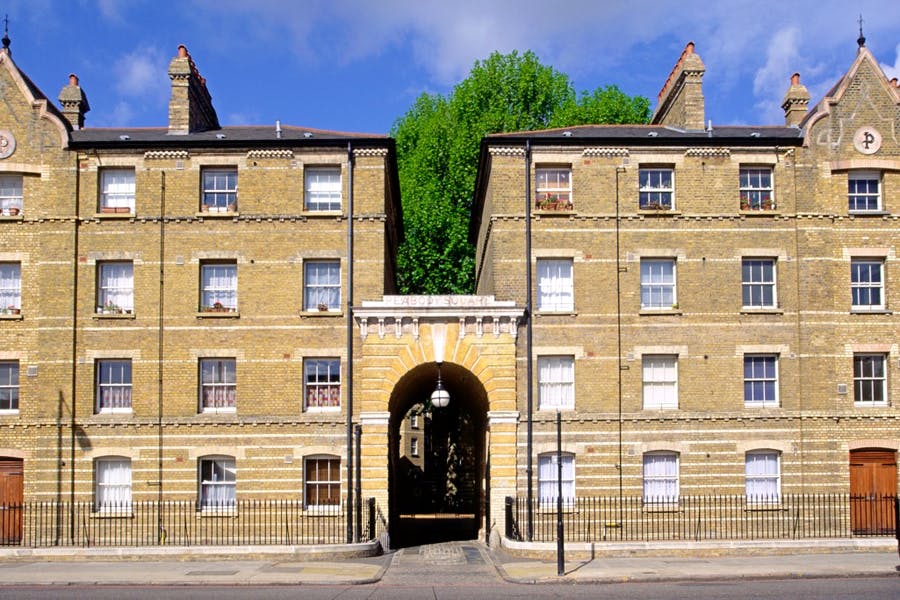
For his generosity and philanthropic work, George Peabody was awarded the Congressional Gold medal in the United States…
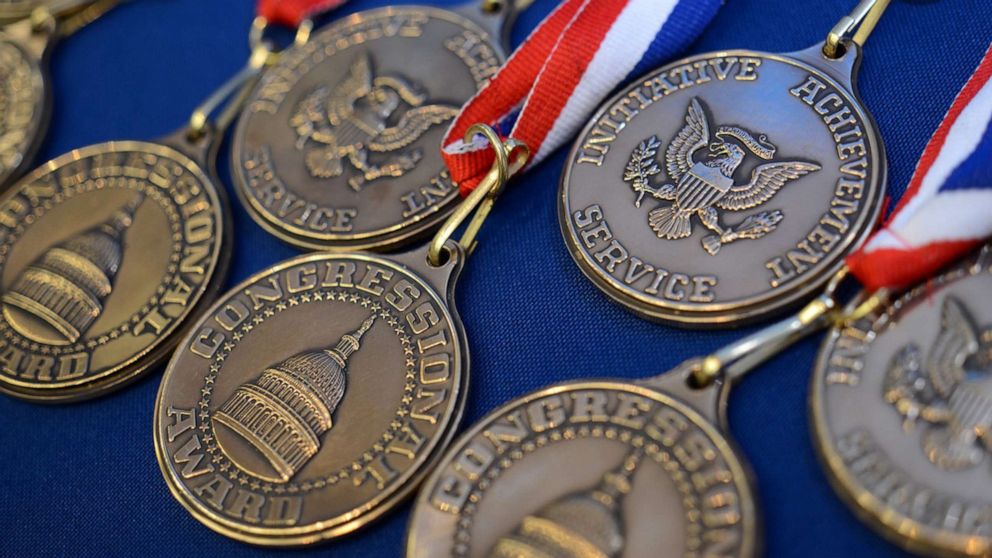
…and was a receipient of the “Freedom of the City of London,” or a “Freeman,” one word.
Sounds like “Free Man,” two words.
Why would there be a special designation of someone becoming a “Freeman,”if we are all born free?
We are told that medieval term “freeman” meant someone who was not the property of a feudal lord, but enjoyed privileges, such as the right to earn money and own land.
So, seriously, what is up with that?
Why do you have to have a special honor bestowed upon you to become a “free man?”
I don’t know the answer to this question, but I am just asking about the meaning behind what it sounds like.

Not only that, George Peabody was given a funeral and temporary grave in Westminster Abbey when he died in 1869, until his remains could be transported to his birthplace in Massachusetts.

Now I am going to go back and dissect information that I stumbled across about George Peabody being a Freemason in “The Secret Founding of America” book by Nicholas Hagger, and tie in some if it in with other research I have done.
This type of information is very hard to find, but it dovetails with other information I have been finding about this period in history.
There is a lot more information contained in the pages of this book, but I am going to concentrate primarily on some things I have uncovered in my research that are 1) either hard to find in writing; or 2) hard to substantiate when found in writing.

This paragraph called “Rothschilds Plan an American Central Bank” from page 73 of “The Secret Founding of America” talks about Mayer Amschel Rothschld funding Adam Weishaupt’s Order of the Illuminati in the 1770s; his five sons controlling banks in the major cities of Europe; the Rothschilds’ wanting to start a central bank in America; and several of the Rothschilds being behind the funding of both North and South “in the planned division.”
In the “planned” division?
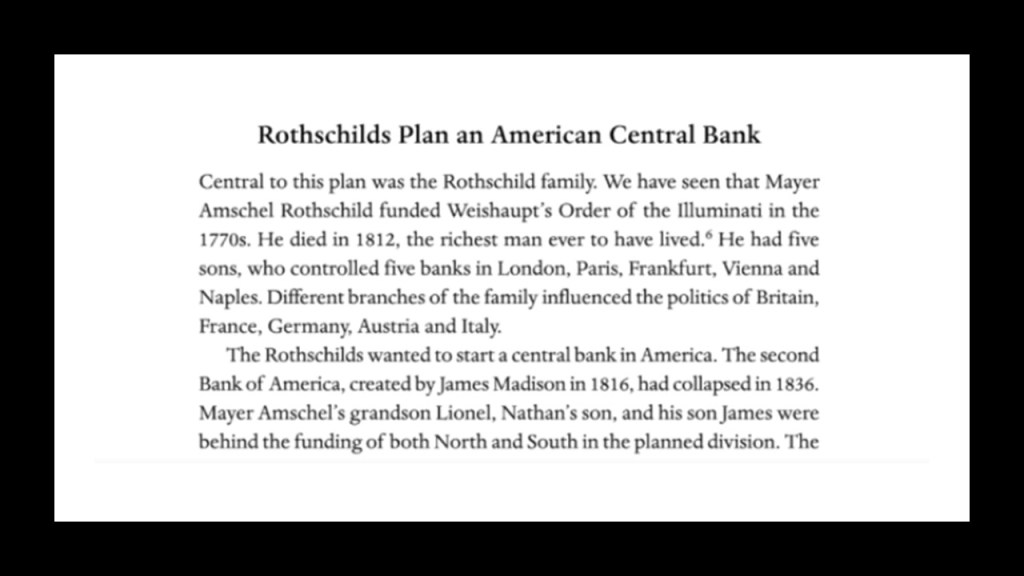
We have already seen Mayer Amschel Rothschild and his five sons establish their International banking family dynasty throughout major cities of Europe.
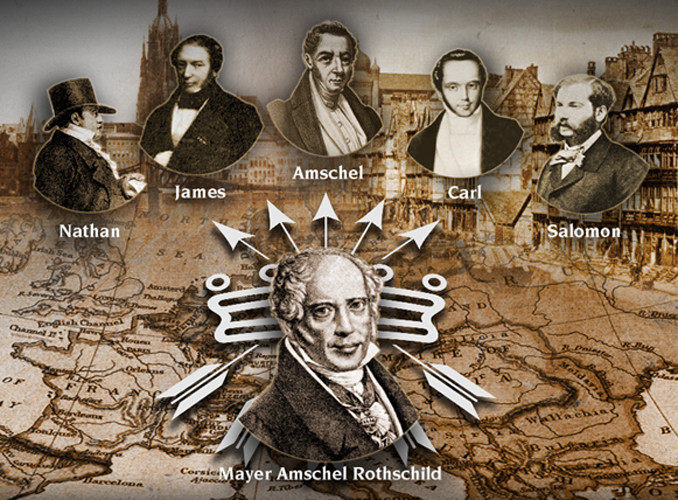
And this is the saying that has been attributed to more than one prominent member of the Rothschild family, starting with the first London family banker, Nathan Mayer Rothschild.

Adam Weishaupt established the Bavarian Order of the Illuminati on May 1st of 1776.
Born in Ingolstadt, Germany, He was educated by Jesuits starting at the age of 7, and was initiated into Freemasonry in Munich in 1777.
He died in Gotha in Germany, under the protection of Duke Ernest II, of Saxe-Gotha-Altenburg in 1830.
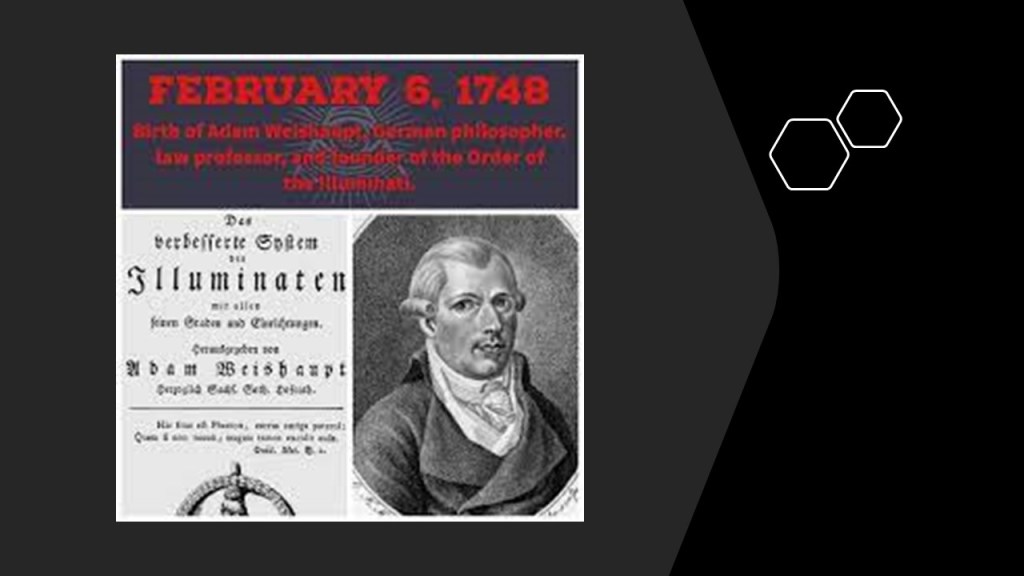
The lineage of the Duchy of Saxe-Gotha-Altenburg eventually became the House of Saxe-Coburg & Gotha, to which first-cousins Queen Victoria & Prince-Consort Albert both belonged, which became known to us as the House of Windsor in 1917.

On page 174, we find the name of “Giuseppe Mazzini,” taking over the Illuminati in 1834.

Apparently Giuseppe Mazzini, an Italian politician, journalist, and activist, had links with Henry John Temple, 3rd Viscount Palmerston, who served as Great Britain’s Prime Minister between 1855 and 1865, which was both the year of his death, and the year the American Civil War came down an end.

According to this book, Giuseppe Mazzini, who had founded a political movement for Italian youth (under age 40) in 1831, sent his right-hand man, Adriano Lemmi, and Louis Kossuth, head of the radical-democratic wing of the Hungarian-nationalists during the Uprisings of 1848, to the United States to organize “Young America” Lodges based on the same ideas.
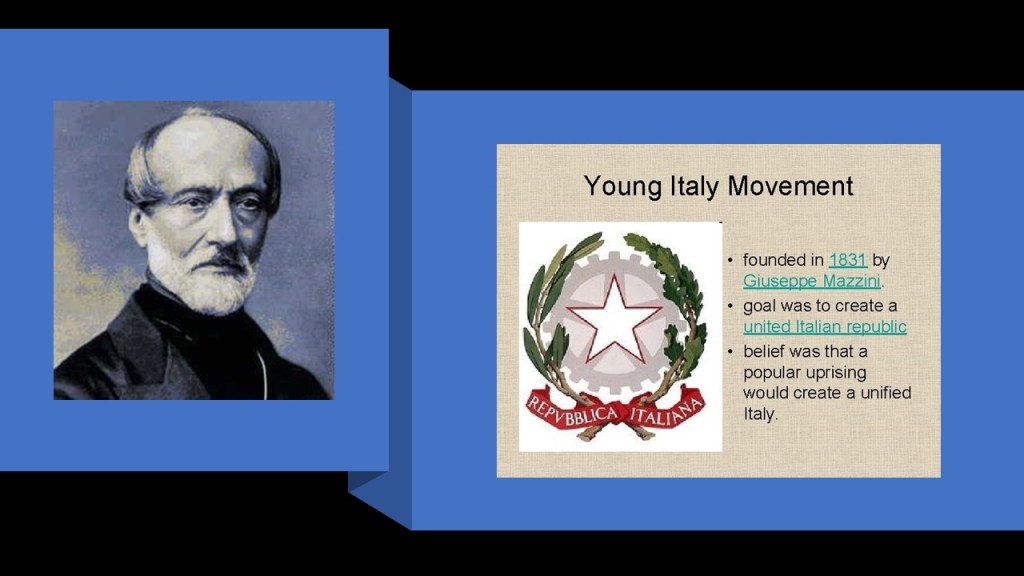
The Revolutions of 1848 were a series of political upheavals throughout Europe that year.
The Revolutions had the aim of removing the old monarchical structures and creating independent nation-states, and was the most widespread revolutionary wave in Europe’s history, with 50 countries being affected.
So, the goal was to remove the original ruling families, and ultimately replace them with a new form of government, which was ultimately controllable.

When I looked for information on the topic of Mazzini, Lemmo and Kossuth, this is what I found.
We will see some of these same names, and others, at the February 21st of 1854 meeting coming up in just a moment on page 175.
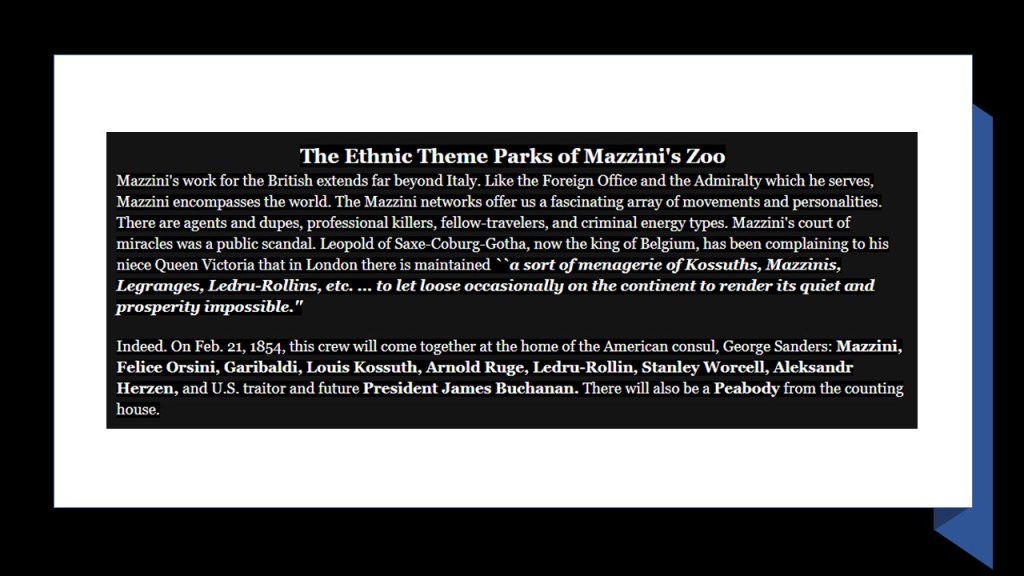
Before we get to the names at the February 21st, 1854, meeting on the same page, we also find references to U. S. Attorney General Caleb Cushing; British Freemasonic banker George Peabody; and J. S. Morgan, on page 175.
This passage says that he was affiliated with the Northern Jurisdiction of Freemasonry, and became the architect of the Civil War.
The architect of the Civil War?
More from “The Secret Founding of America” in just a moment.
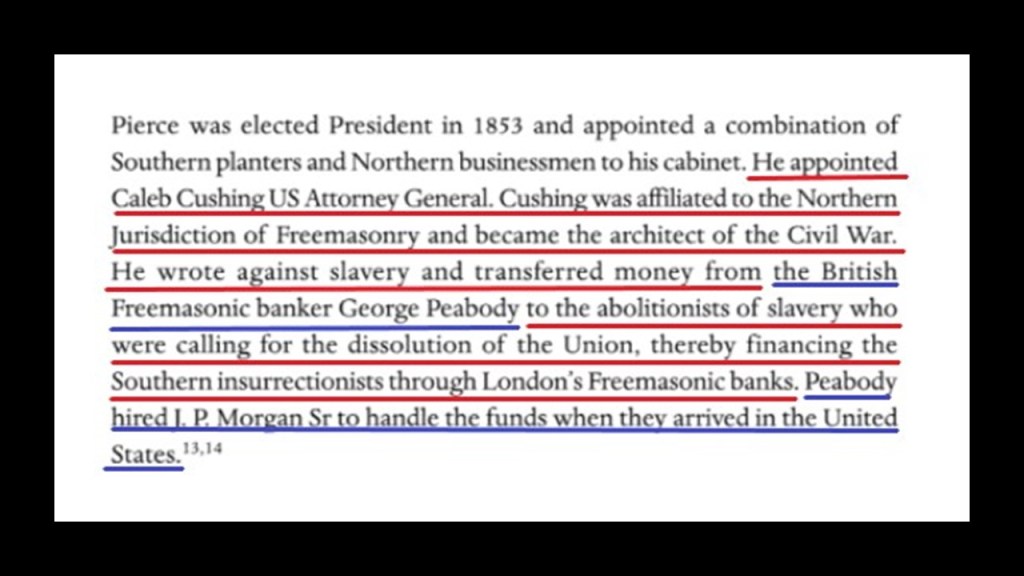
I have not heard of Caleb Cushing before this, so let me see what else I can find about him in a search.
Caleb Cushing was an American Democratic politician who served as a Congressman from Massachusetts and Attorney General during the administration of the 14th-President of the United States, Franklin Pierce.
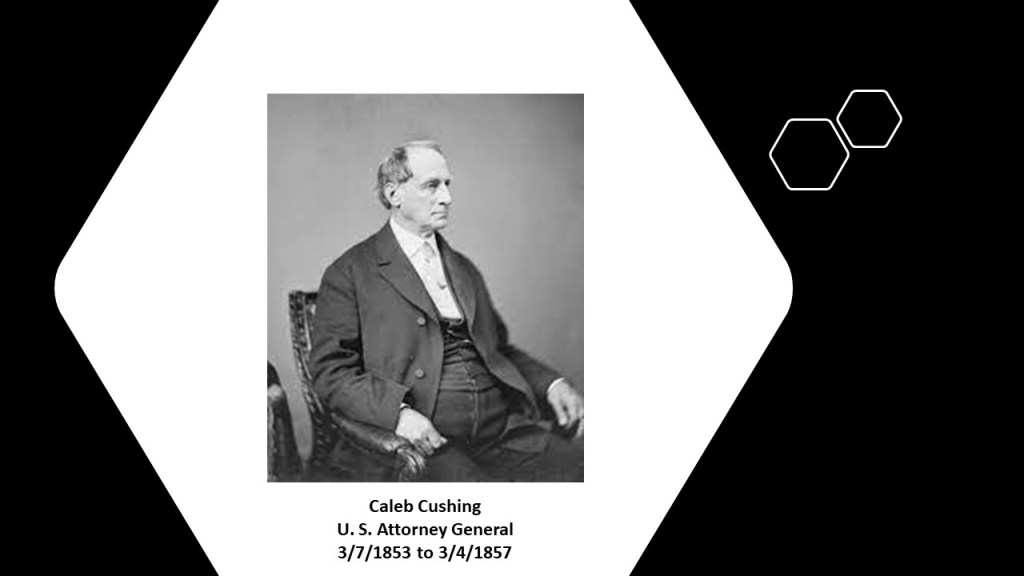
Here are a couple of other things about Caleb Cushing that I find interesting.
Caleb Cushing’s hometown in Massachusetts, from when his family moved there when he was ten, which would have been 1810, was Newburyport, which was the same town where George Peabody worked in his brother’s shop until Peabody moved to Baltimore in 1811.
No indication they knew each other, but an interesting connection nonetheless.

But an even more interesting find about Caleb Cushing was his connection to China.
Caleb Cushing was appointed by President John Tyler, the 10th-President of the United States, as Ambassador to China in 1843, a position which he held until March 4th of 1845.
The Cushing Mission to China arriving in Macau consisted of four American Warships, which were loaded with gifts, and devices like telescopes and revolvers, in the hopes of impressing the Royal Chinese Court.
When the Chinese were not inclined to receive Cushing as an envoy, Cushing threatening with the U. S. Warships in his entourage, to go directly to the Chinese Emperor.
This tactic resulted in the Chinese Emperor negotiating with Cushing, and the Treaty of Wanghia, also known as the Treaty of Peace, Amity, and Commerce between the United States and the Chinese Empire in 1844.
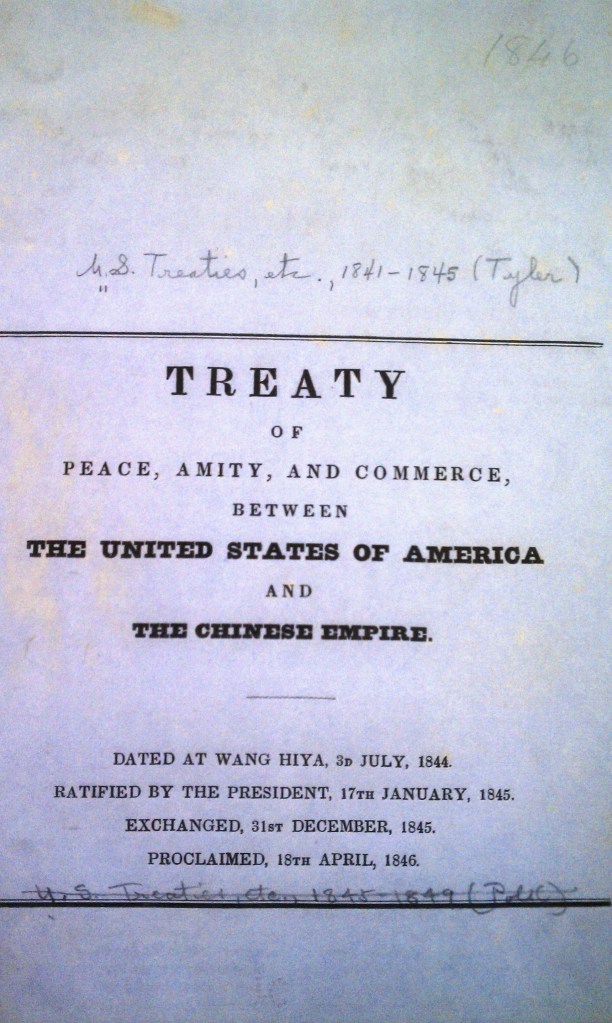
This sounds like exactly the same tactic that was used on the Japanese by the U. S. Navy’s Commodore Peary – warships visiting Tokyo and threats – resulting in the Treaty of Kanagawa, also known as a “Treaty of Peace and Amity” in 1854.
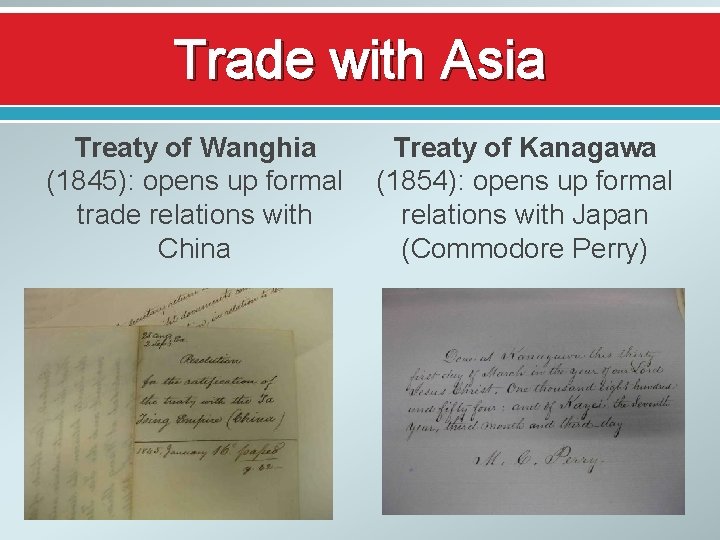
Within six years of the signing of the Treaty of Wanghia, China was enmeshed in the Taiping Rebellion, a civil war between 1850 and 1864.
It was a civil war between the established Qing Dynasty, the last imperial dynasty of China, and Taiping Heavenly Kingdom, an unrecognized oppositional state in China supporting the overthrow of the Qing Dynasty.
Though, we are told, the Qing Dynasty ultimately defeated the opposing forces with the eventual help of British and French forces, the Taiping Rebellion left the economic heartland of China in the central and lower Yangzi River basins in ruins, and millions of people lost their lives as a result of it, as well as that in western eyes, China was marked as poor and backwards.
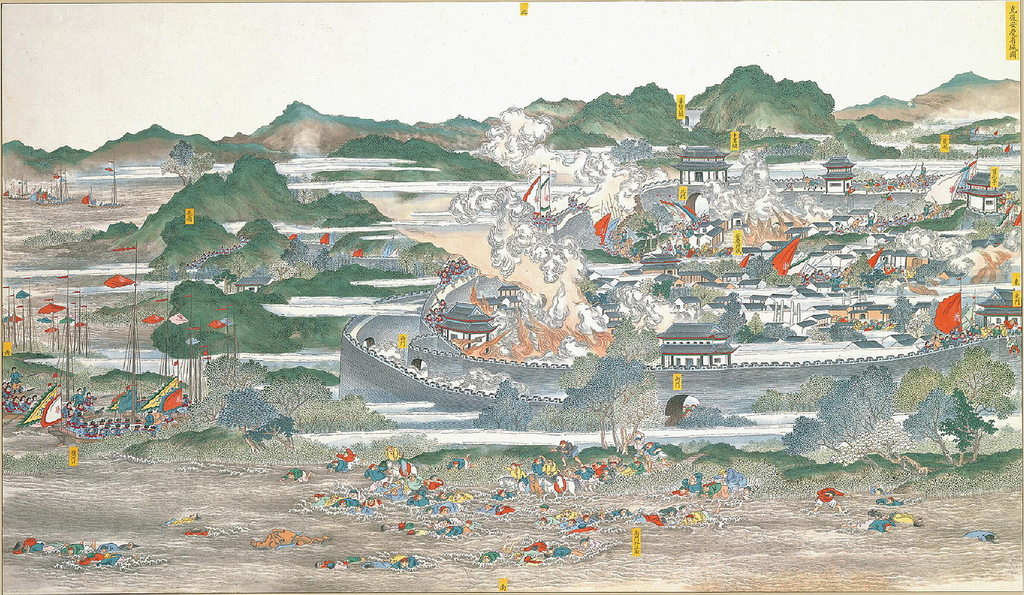
Okay, so that’s little bit more about Caleb Cushing.
Been talking about George Peabody this whole time, so what about Junius Spencer Morgan, the man the books says George Peabody hired in 1854 to handle the funds Cushing had transferred from Peabody’s bank to the United States for the Southern insurrections who were calling for the dissolution of the Union.
Junius Spencer Morgan was the founder of the company that would become J. S. Morgan & Company in 1864, that was the successor company to George Peabody & Company, of which he became the Junior Partner in October of 1854.
In 1854, Morgan was put in charge of the firm’s iron portfolio, which included the marketing of railroad bonds in London and New York.
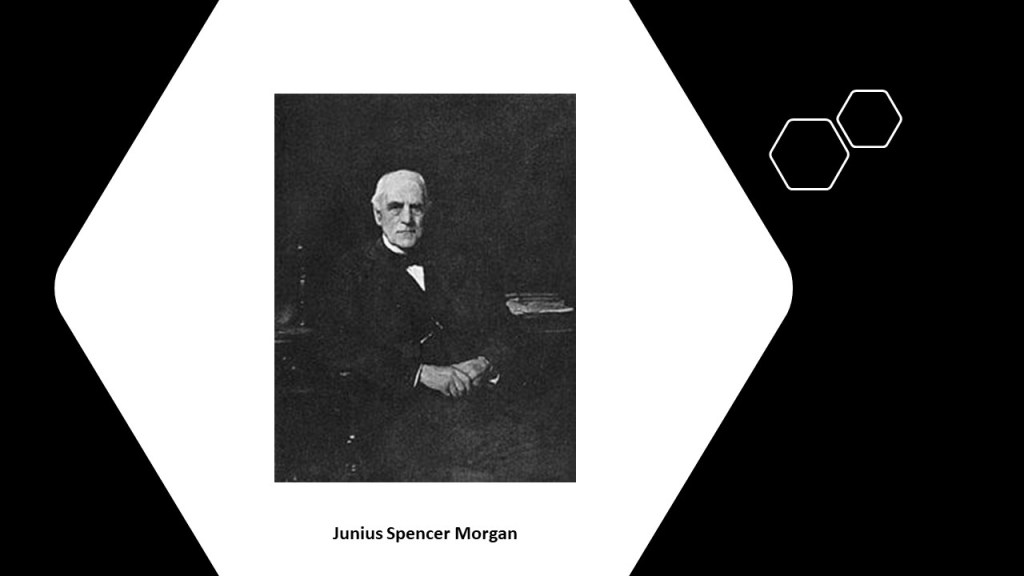
By the time J. S. Morgan died in 1890, the Morgan banks were the dominant forces in government and railroad finance, and his son John Pierpont Morgan had taken the helm of the company, becoming known as. J. P. Morgan & Company in 1895.
J. P. Morgan, an American financier and banker who dominated corporate finance on Wall Street throughout this period of time, also known as the “Gilded Age,” between the years of 1870 and 1900.
He was a driving force behind the wave of industrial consolidation in the United States in the late 18th- and early 19th-centuries…

…including the creation of U. S. Steel in 1901 by merging three companies into one, and creating the world’s first billion-dollar corporation!

So, anyway, what about the others who were at that February 21st of 1854 meeting at the house of George Sanders, American Consul, and the person who was said to have handled the Peabody funds in London, according to the “Secret Founding of America” book.
These two different sources information name many of the same names at being at this meeting.
The over-lapping names between the two lists are: Sanders, Mazzini, Kossuth, Ruge, Herzen, and the future American President James Buchanan, the 15th-President, who served in the years immediately preceding the Civil War.
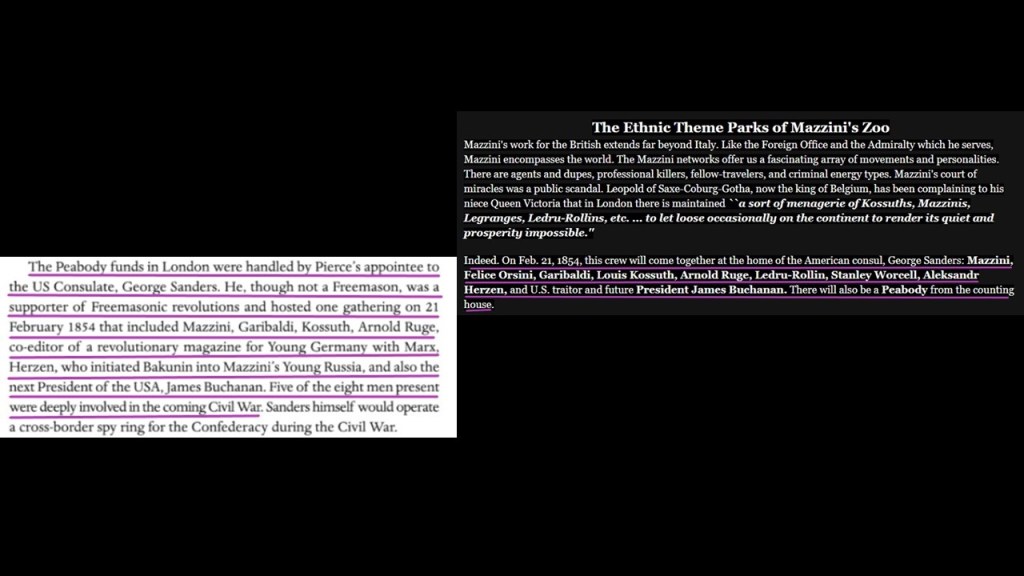
George Sanders was appointed as the Consul in London during the administration of President Franklin Pierce.
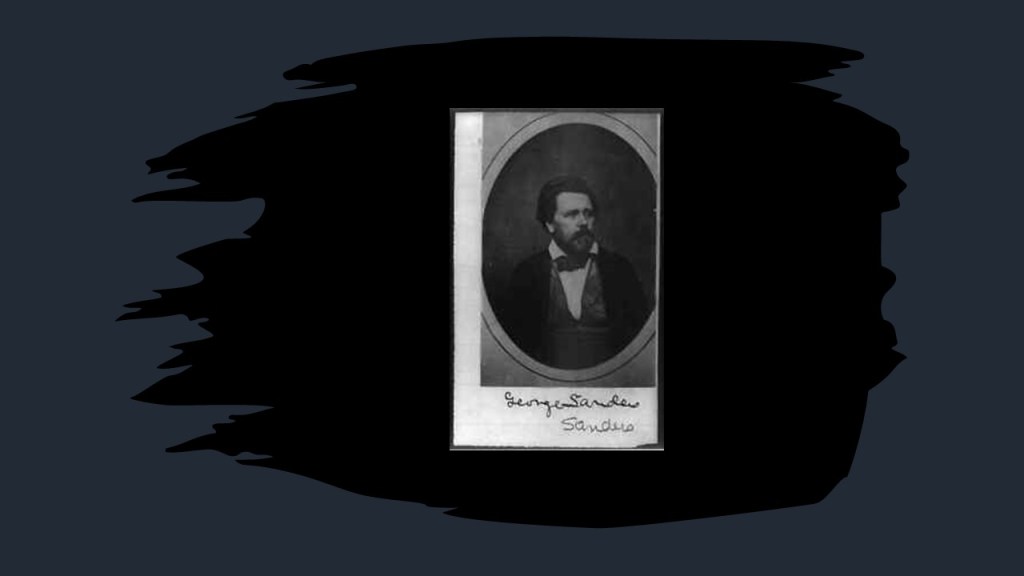
He was involved in the “Young America” movement, which had become a faction in the Democratic Party in the 1850s.
Sanders was believed to have been involved in the plot to assassinate Abraham Lincoln, though he escaped being taken into custody after it took place.
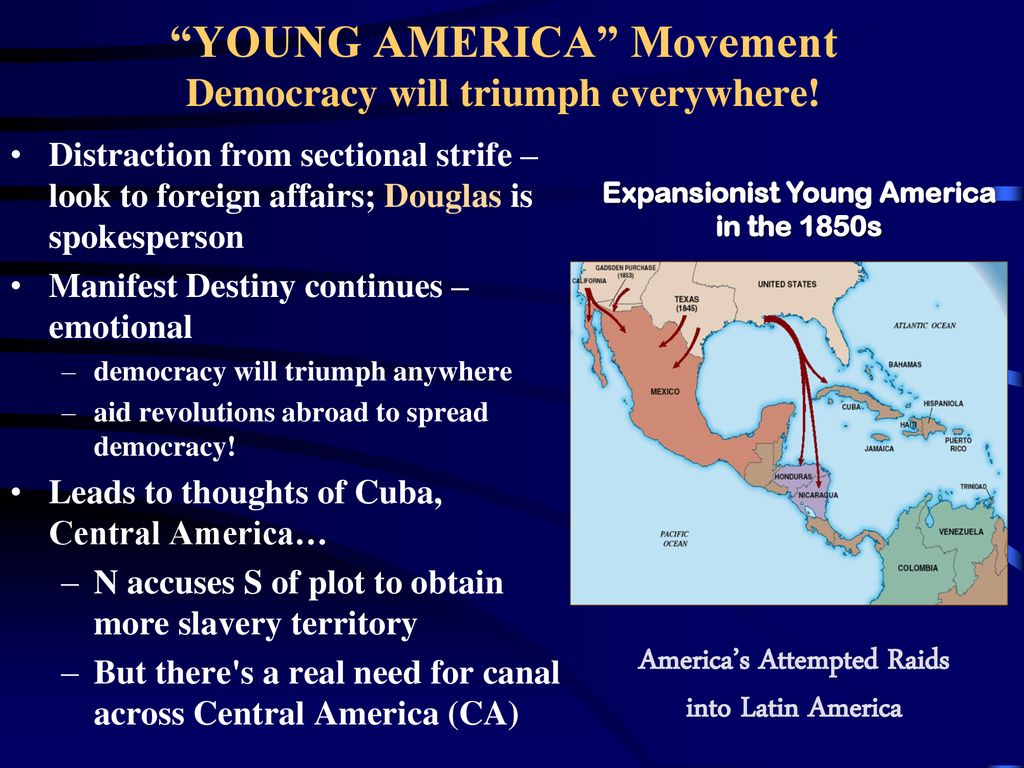
Arnold Ruge was a member of the “Young Hegelians” and expressed his belief that history is a progressive advance towards the realization of freedom, and that freedom is expressed in the State, the creation of a rational general will, which is the will of the people as a whole.
A believer in a unified Germany, and also involved in the Revolutions of 1848, Ruge organized the extreme left in the Frankfurt Parliament.
He was forced to take refuge in London in 1849, where he met up with Giuseppe Mazzini, and formed the “European Democratic Party.”
He was considered a leader in religious and political liberalism in his time.

As mentioned in this paragraph from “The Secret Founding of America,” Ruge was co-editor of a revolutionary magazine for “Young Germany” with Karl Marx, who also happened to be living in London during this same time-frame, where he had moved in 1850, and was to have his home base in London for the rest of his life.
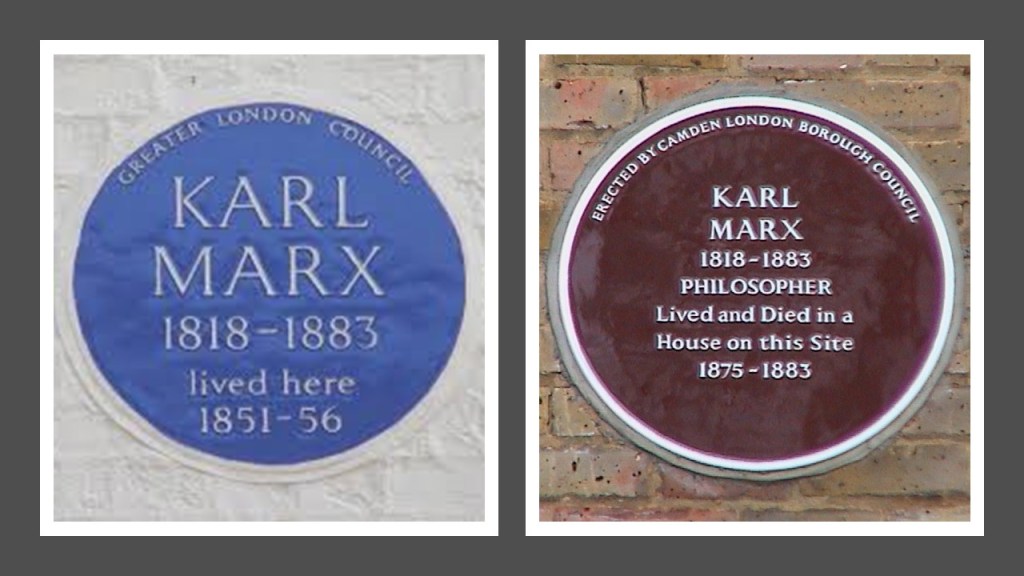
As a matter of fact, another German-born revolutionary socialist, Friederich Engles, and Russian revolutionary socialist, Vladimir Lenin, along with Karl Marx, all lived in London at some point in time!
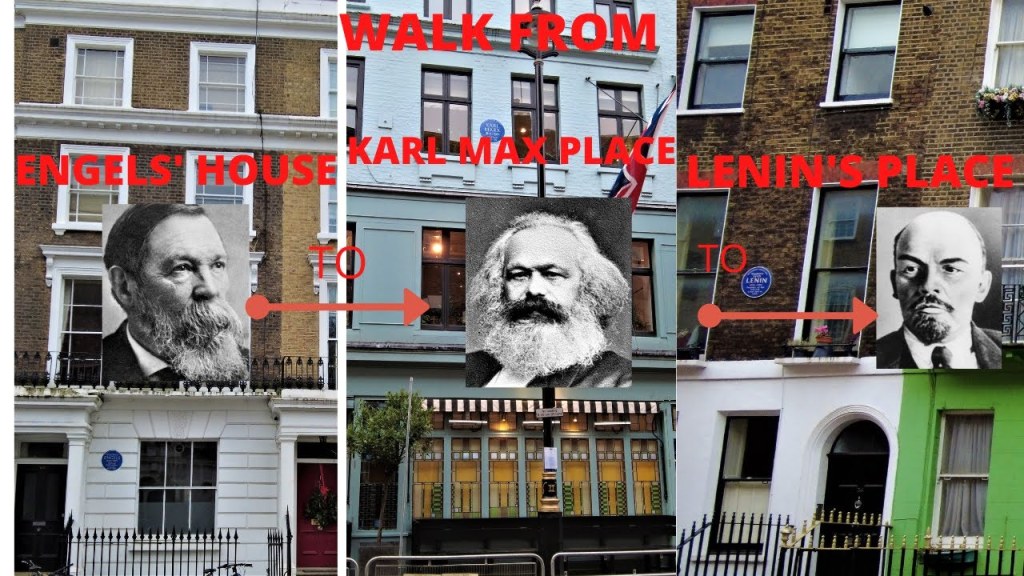
The name Herzen at the February 1854 meeting was Alexander Herzen, a Russian writer and thinker known as the “Father of Russian Socialism” and one of the main fathers of “Agrarian Populism.”
Herzen was born out of wedlock to a rich Russian landowner in April of 1812, right before Napoleon’s invasion of Russia.
He left Russia for good in 1847, landing first in Paris, where he supported the Revolutions of 1848, but was disillusioned with the failure of associated European Socialist movements.
He had assets from his inheritance that were frozen after the emigrated from Russia, but because of a business relationship of his family with Baron James de Rothschild in Paris, who negotiated the release of Herzen’s assets which were nominally transferred to Rothschild.
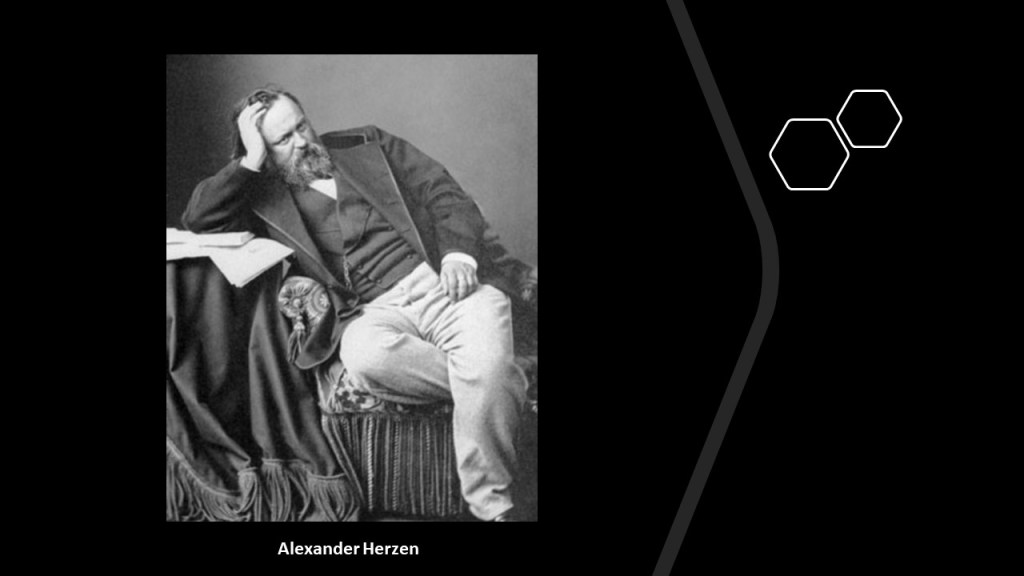
He ended up in London in 1852, where he started his own printing company, the “Free Russian Press” in 1853, with a view to becoming the “uncensored voice of free Russia.”
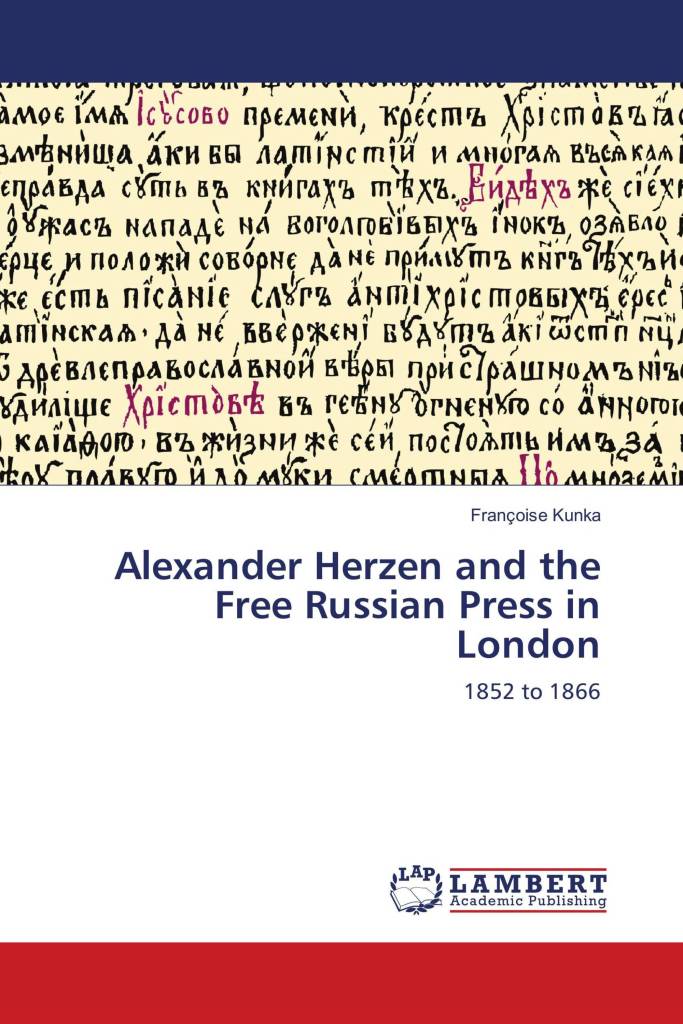
The “Free Russian Press” was launched on shortly before the beginning of the Crimean War, which started in October of 1853, and ended in February of 1856, and which the Russian Empire lost to an alliance comprised of France, the Ottoman Empire, the United Kingdom, and Sardinia.
This is a painting depicting the “Charge of the Light Brigade at the Battle of Balaklava,” which took place during the Crimean War in the Ukraine on October 25th of 1854, which resulted in a failed attack by a British Light Cavalry unit led by Lord Cardigan against Russian forces.
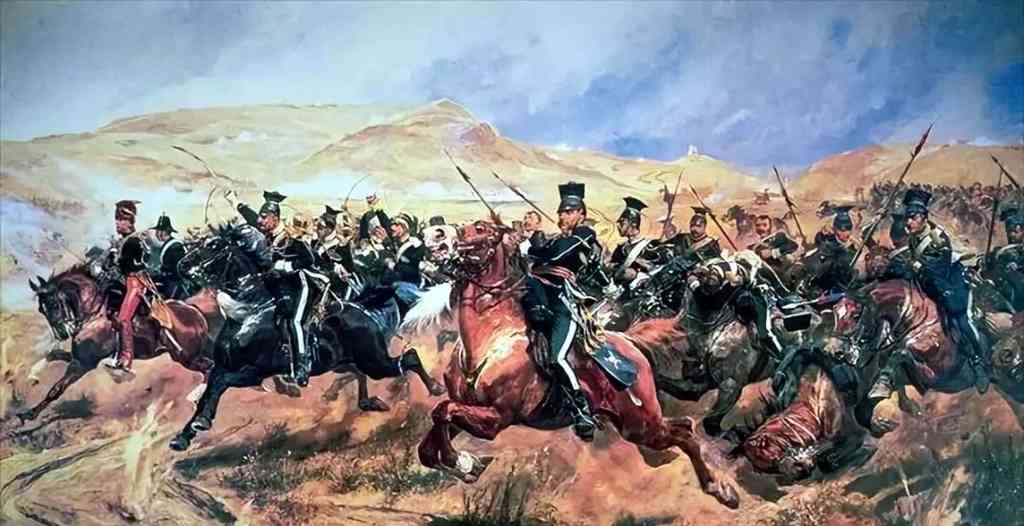
Alfred Lord Tennyson, the Poet Laureate during much of Queen Victoria’s long reign, made the battle famous in his poem “The Charge of the Light Brigade,” which was published only six-weeks after the event, in which he emphasized the valor of the brave cavalry carrying out its orders, regardless of well-prepared artillery units and high casualties until it was forced to retreat.
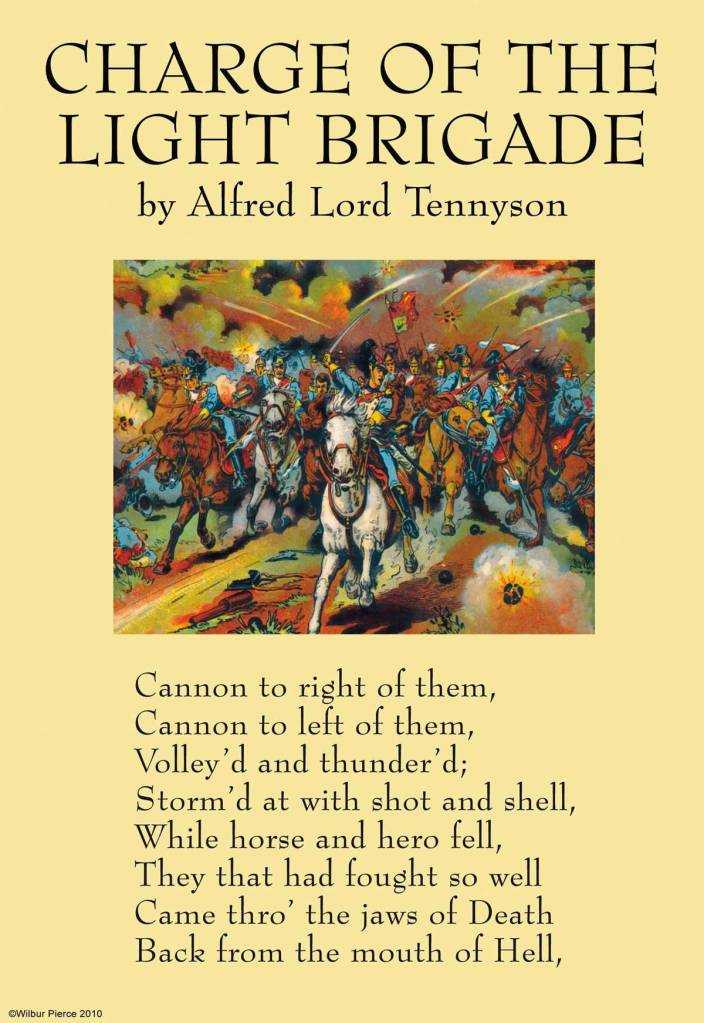
The Russian Empire lost the Crimean War in the end, resulting in a weaker Imperial Army, a drained treasury, and its influence undermined in Europe.

The future U. S. President James Buchanan was named as President Franklin Pierce’s Ambassador, or Minister to the United Kingdom, a position he held from August 23rd of 1853 to March 15th of 1856.
So he would have also been in London at the time of the aforementioned meeting on February 21st of 1854.

James Buchanan was nominated to be the Democratic Party’s Presidential nominee in 1856, and said to have benefited from being out of the country when he was living in London and not associated with slavery issues, and won the 1856 election with his running mate John C. Breckinridge.
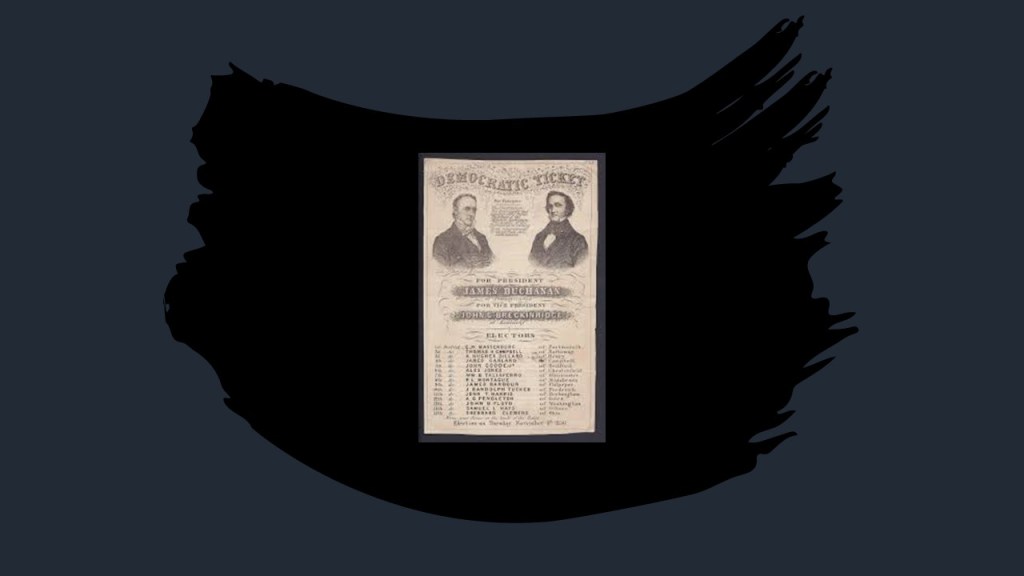
As President, he was said to have intervened in the Supreme Court’s Dred Scott case to gather majority support for a pro-slavery decision, in which a majority of the Supreme Court ruled in March of 1857 that the United States Constitution was not meant to include citizenship for people of what was called African-descent (who were in actuality the indigenous Moorish people of North America), so that the rights and privileges of the Constitution could not be conferred on them…
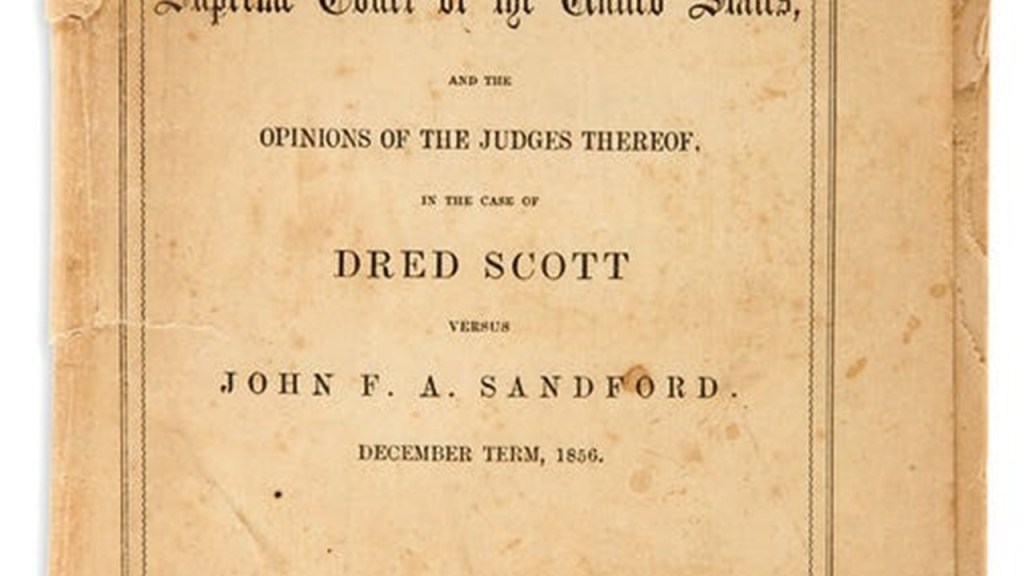
…and Buchanan attempted to engineer Kansas entering the Union as a slave state, by sending a message to Congress urging the acceptance of Kansas as a slave state, which it rejected and set the admission for Kansas as a free state in June of 1861.
This was several years after the Kansas-Nebraska Act became law on May 30th of 1854, creating the two new Territories and allowing for popular sovereignty.

It also produced a violent uprising known as “Bleeding Kansas” when pro-slavery and anti-slavery activists flooded into the new territories seeking to sway the vote.
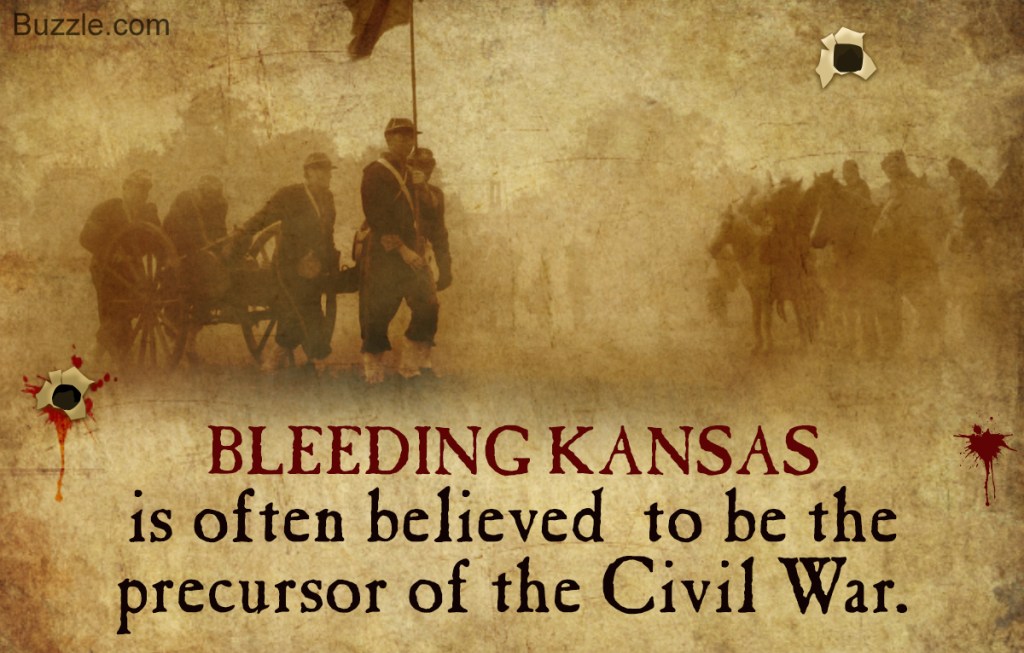
Ultimately the cause of eleven states to secede from the Union in 1860 was in support of states’ rights in the context of slavery to support the South’s agricultural economy, and the federal government not overturning abolitionist policies in the North and in new territories
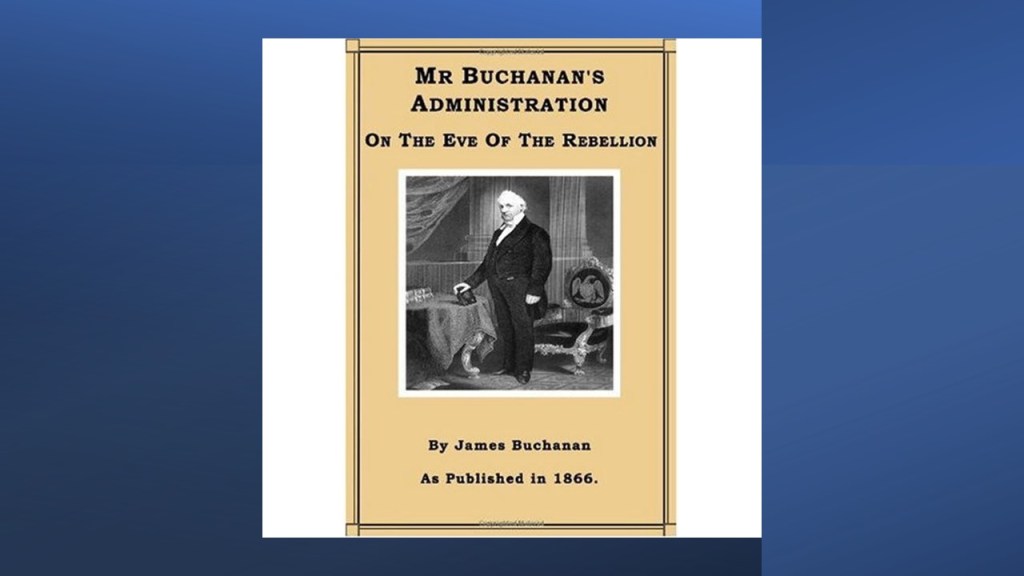
As a matter of fact, James Buchanan went down in history as the worst President of the United States.
I wonder if he took a hit to his reputation for the team?

More on this possibility from “The Secret Founding of America” book in just a moment.
The last named person at the meeting in London that I haven’t touched upon being in London yet was Louis Kossuth, the Hungarian Revolutionary.
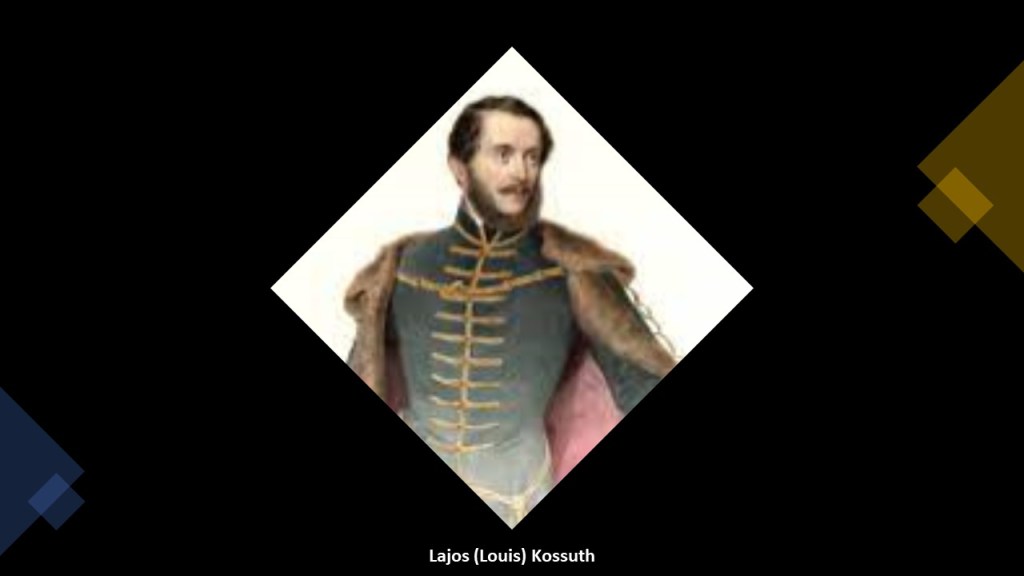
Louis Kossuth, a member of the Hungarian lower nobility through his family origins, was a leader of the 1848 Revolution in Europe, and he inspired the people in speeches to rise up against the Austrian Empire, which was created by proclamation in 1804 out of the realms of the Habsburg Empire, and included Hungary.

The Hungarian Declaration of Independence declared the Independence of Hungary from the Habsburg Monarchy during the Hungarian Revolution of 1848, issued by Louis Kossuth from the Protestant Great Church of Debrecen, said to have been built between 1805 and 1824, and which passed the National Assembly on April 13th of 1849.

Subsequently, Kossuth was the first, and only, Governor-President of the short-lived Hungarian State in 1849 from April 14th to August 11th.
In the meantime, an alliance was formed in May between the Austrian Empire and the Russian Empire, and by August of 1849, the Hungarian Army had been defeated, and the new State of Hungary ended.

Louis Kossuth left Hungary, and as things went, ended up in Great Britain, touring and speaking for a couple of weeks, in 1851, and then left for a trip to the United States, and in the 1851 – 1852 time-frame toured the country, during which time he gave a speech to a meeting of the joint-houses of the U. S. Congress, where a bust of him in the U. S. Capitol building can be found today.

He applied for admission to the Freemasonic Grand Lodge #133 of Cincinnati…

…which was the same Cincinnati lodge used by Kossuth and Lemmi as headquarters for their “Young America” lodges mentioned previously in the book, which also referenced the steps taken to “begin the process of bringing about a civil war by forming revolutionary groups throughout the United States to intensify the debate on slavery.”

Kossuth returned to London from America in July of 1852, where he lived for the next eight-years.
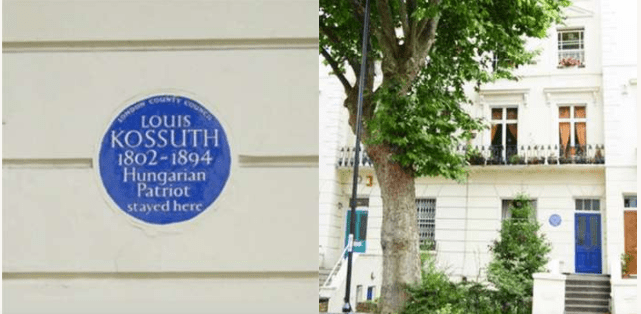
So, based on a review of what is in the written historical narrative about the men listed that were said to have been at the February 21st of 1854 meeting in London were actually living in London at the time of the meeting, and most of the men at the meeting were known revolutionaries.

What else did “The Secret Founding of America” have to say?
I was really interested in this section because I have come across Albert Pike on several occasions in my research.
According to the earlier paragraph shown, Caleb Cushing had ties to the Northern Jurisdiction of Freemasonry and became the architect of the Civil War…

…and in the next paragraph, it says that Caleb Cushing tapped Albert Pike to take the steps necessary to become the Sovereign Grand Commander of the Supreme Council of the Southern Jurisdiction of Scottish rite Freemasonry.
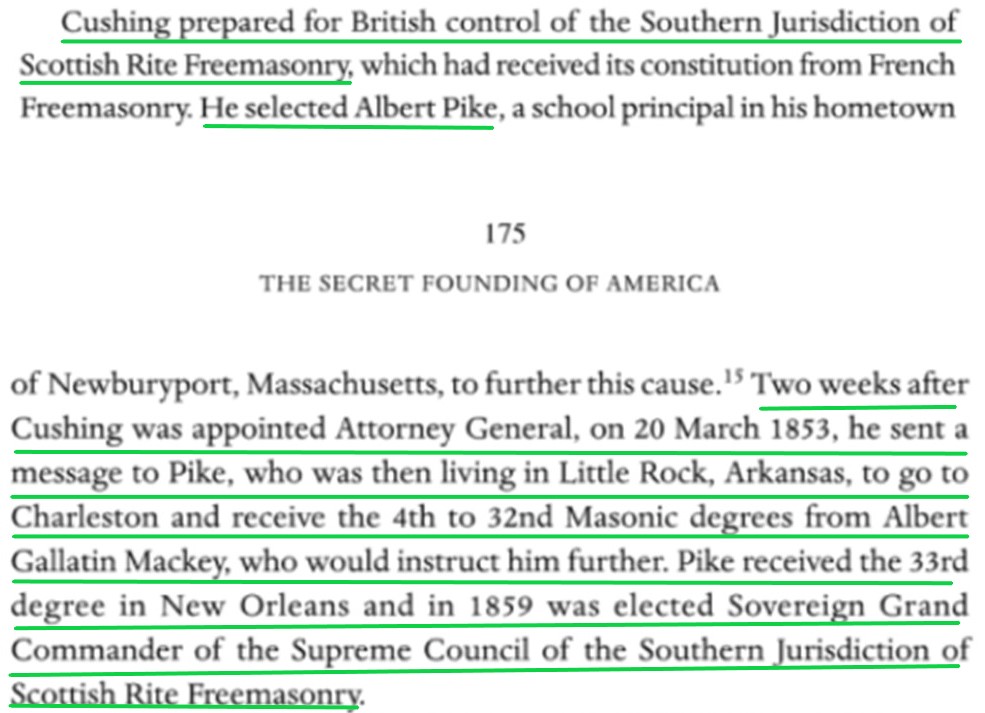
It is not hard to find Albert Pike’s connection to Freemasonry in the historical record.

Not hard at all.
What is hard to find is Albert Pike’s and Freemasonry’s connection to historical events, and that is why I was so glad to find this, because there are other very interesting pieces of information that I have come across that point to a deep involvement in major events of the 20th-century that are hard to substantiate.
I will explain what I mean by this shortly.
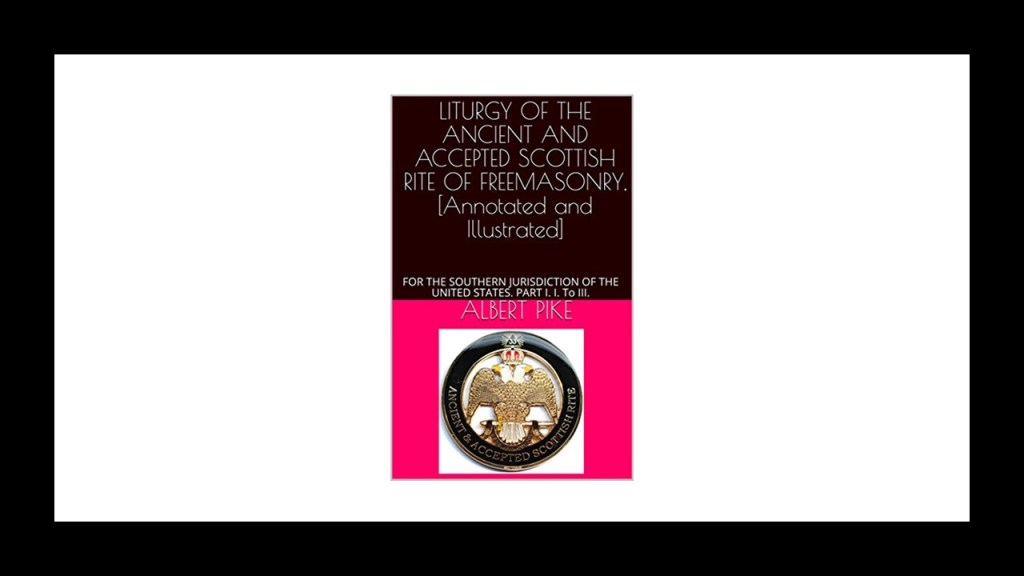
A couple more things before I leave this informative book.
One was the mention Caleb Cushing’s role in encouraging the previously mentioned 1854 Kansas-Nebraska Act.
According to this paragraph, Caleb Cushing used former Master Mason John Brown to cause the Civil War.
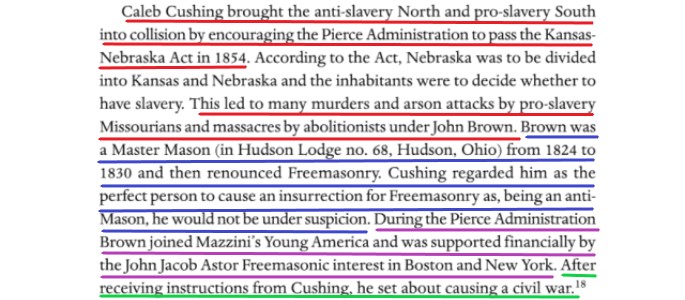
And indeed John Brown was very involved in what happened in “Bleeding Kansas.”
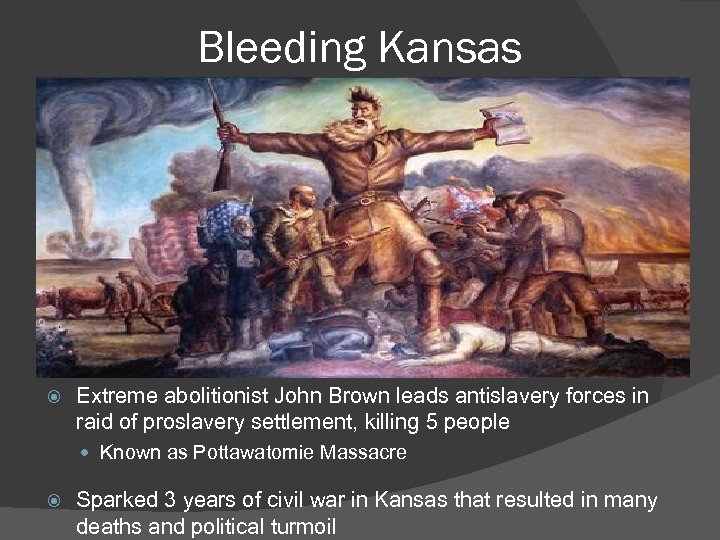
John Brown was best known for the Harper’s Ferry raid on October 16th of 1859 in West Virginia.
There was a federal arsenal located there, and while the plan was to raid the arsenal and instigate a major slave rebellion in the South, he had no rations or escape route.
In 36-hours, troops under the command of then Lt. Col. Robert E. Lee had arrested him and his cohorts, who had withdrawn to the engine house after they had been surrounded by local citizens and militia.

So while his plan was doomed from the start, it did serve to deepen the divide between the North and South.
John Brown was hung on December 2nd of 1859, less than two months after the onset of the Harper’s Ferry Raid.
Did John Brown take one for the team, too?
Or did he not see that one coming?


Another involves several of Albert Pike’s roles during the Civil War.
One is that when he became the most powerful Mason in the World when he became the Sovereign Grand Commander of the Southern Jurisdiction; he secretly organized the rebellion in the Southern States using this jurisdiction as a cover; and that most of the leadership of the Confederacy, both political and military, were Freemasons under Pike’s secret command.

One of the first times in my research that I came across Albert Pike’s name in connection with the Civil War was finding out that he was a senior officer in the Confederate Army who commanded the District of Indian Territory, what later became known as Oklahoma, in the Trans-Mississippi Theater of the American Civil War.
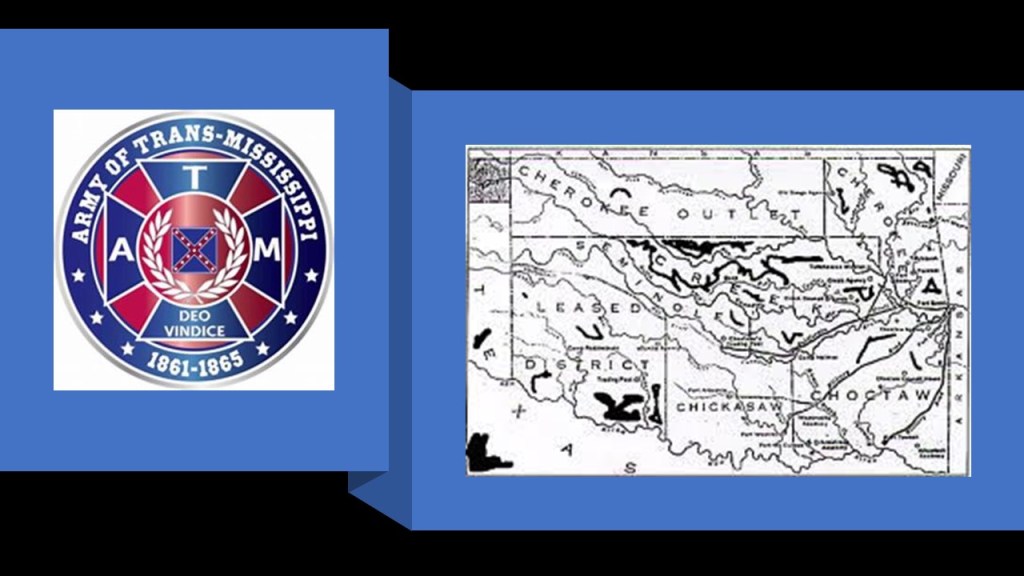
The Trans-Mississippi Theater of the Civil War covered everything west of the Mississippi River as pictured here.
We are told that over 200,000 men were engaged in the Trans-Mississippi Theater of War, and there were all together 7 battles in Arkansas, New Mexico, Missouri and Louisiana between 1862 and 1864.
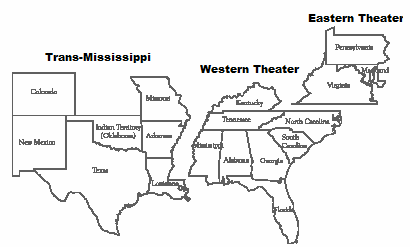
This region was also the heart of the ancient Washitaw Empire, with Monroe, Louisiana being the Imperial Seat, in what was known as “Washitaw Proper.”
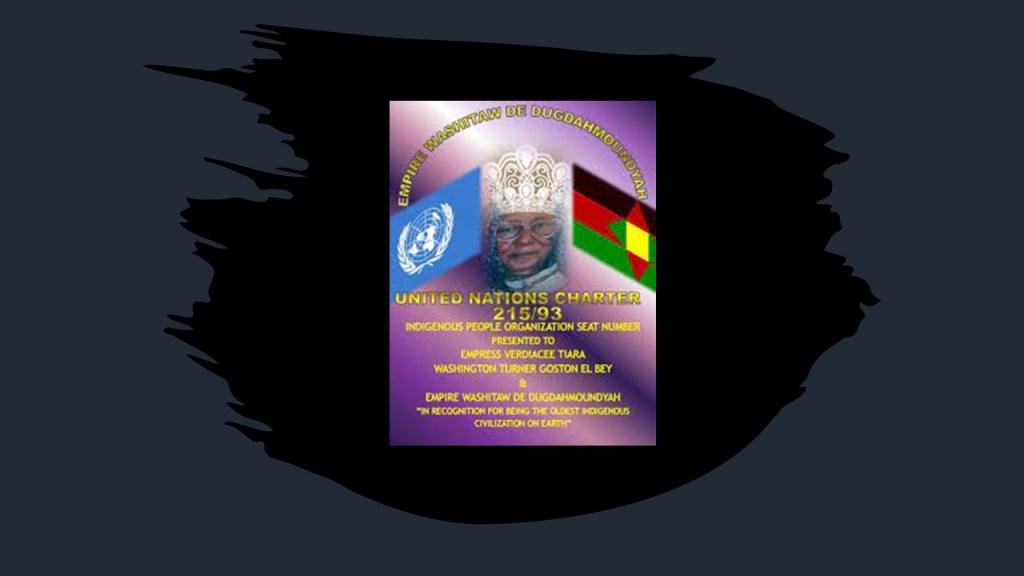
I think what was really going on here was very different from what we are told, and it has everything to do with what actually happened to the advanced, ancient Empire that was originally here.
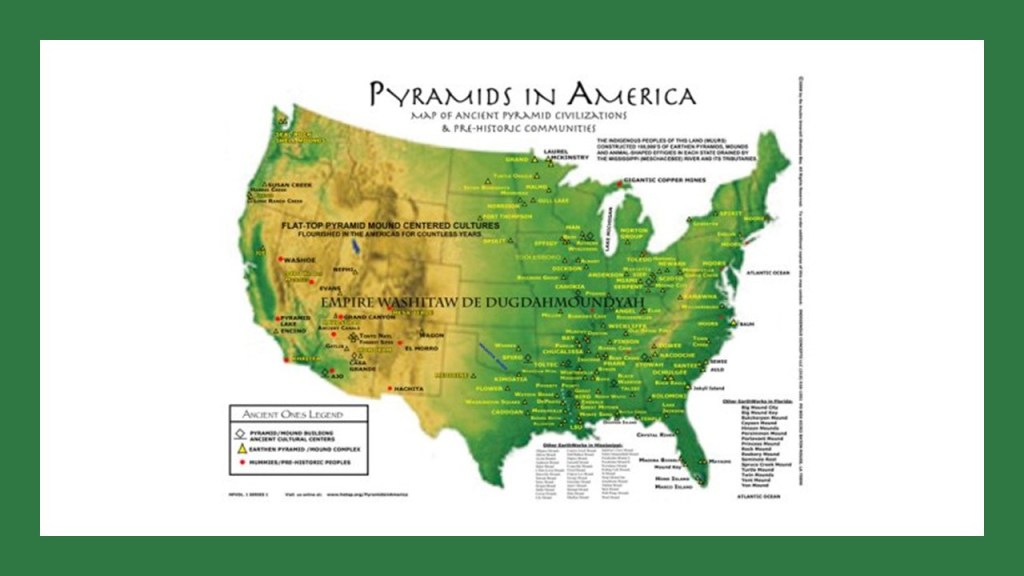
And the word theater, defined as a collaborative form of performing art that uses live performers, usually actors or actresses, to present the experience of a real or imagined event before a live audience in a specific place, like a stage, is an intriguing word choice for an area or place in which important military events occur or are progressing.
A theater can include the entirety of the air space, land and sea area that is or that may potentially become involved in war operations.
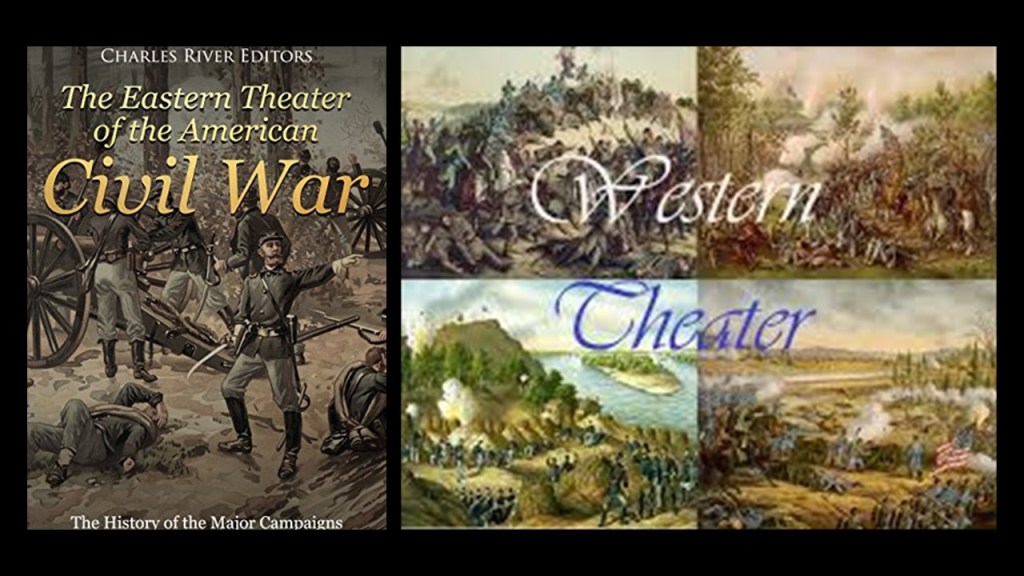
For the purposes of this blog post, I am going to end with the subject of what kinds of things happened in the year of 1871, a very eventful year it would seem.
First, I encountered in my research the short-lived Paris Commune, established on March 28th of 1871, which was a radical socialist, anti-religious and revolutionary government that ruled Paris until it was suppressed by the French army in May of 1871.
What happened in the Paris Commune was closely followed by London resident Karl Marx, who published a pamphlet in June of 1871, called “The Civil War in France,” about the significance of the struggle of the Communards in the Paris Commune.
What we know of as Commune-ism is also known as Marx-ism, and still very much with us today.
Why is that?

The second subject are these graphics I have encountered displaying alleged quotes of Albert Pike’s about World Wars I, II, and III.
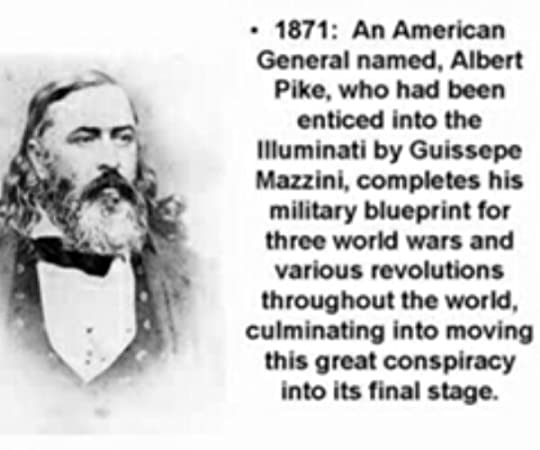
The following three quotes that appear to be the military blueprint for three world wars were said to have been contained a letter written Albert Pike to Giuseppe Mazzini in 1871.
I have encountered the quotes and the information about them being from Pike’s letter to Mazzini before, but this is the first time I have encountered a real-life Mazzini, and others, with which to connect the information.
For the First World War, he was talking about the Illuminati overthrowing the Czars and making Russia a fortress of atheistic communism in the same year Karl Marx first wrote about Communism with regards to the Paris Commune.
Coincidence?

For the Second World, he talked about taking advantage of the differences between Fascists and Zionists; destroying Nazism; Zionism creating Israel, and Communism being strong enough to control Christendom.
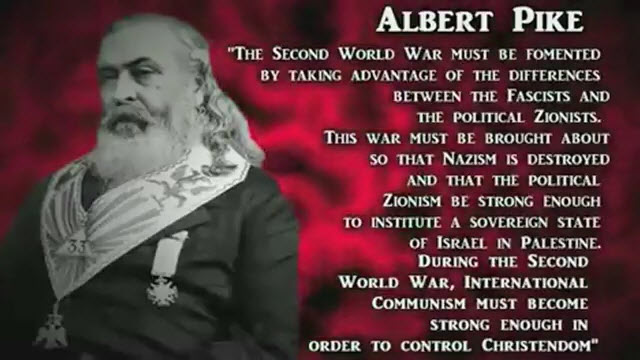
And for the Third World War, the Illuminati taking advantage of the differences between Zionist and Islamic leaders so they mutually destroy each other.
Any of this sound familiar to what we know in the present-day?
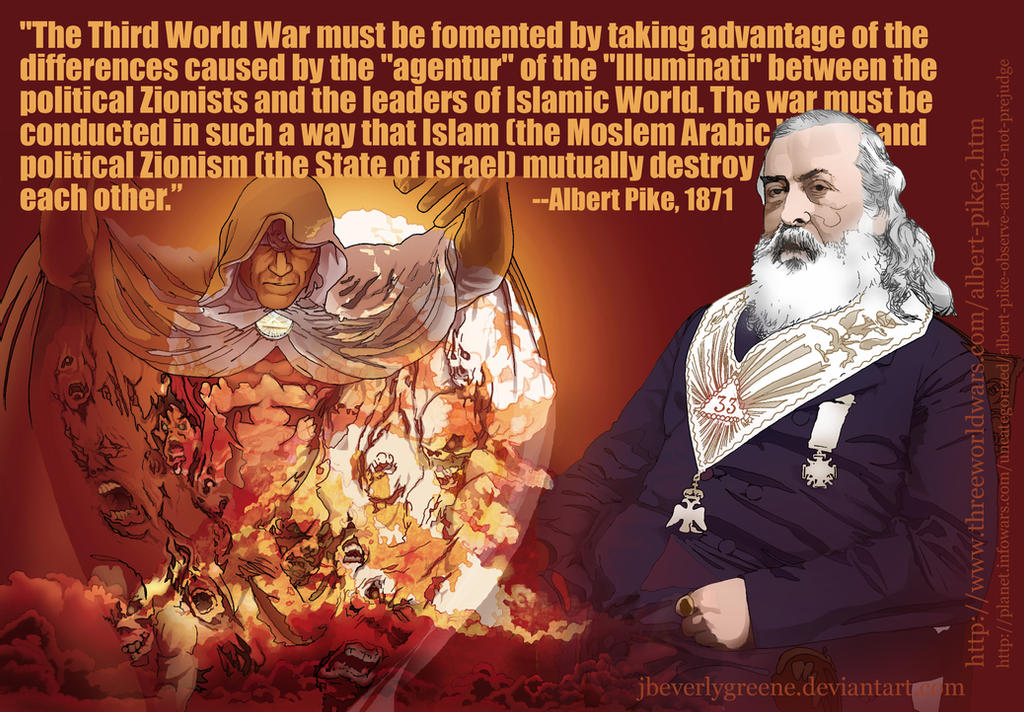
It does to me.

Could all of these conflicts, at least since the American Civil War, and maybe even the Crimean War and other wars of the 19th-century, been planned, even scripted out, for the Controller’s desired outcome, which was world control and domination?
Also, 1871 was the year the U. S. Congress passed the “District of Columbia Organic Act,” which repealed the charters of the cities of Washington and Georgetown, and established a new territorial government for the District of Columbia.

This created a single municipal government for the federal district, which was incorporated, defined as the process of “constituting a company, city, or other organization as a legal corporation.”
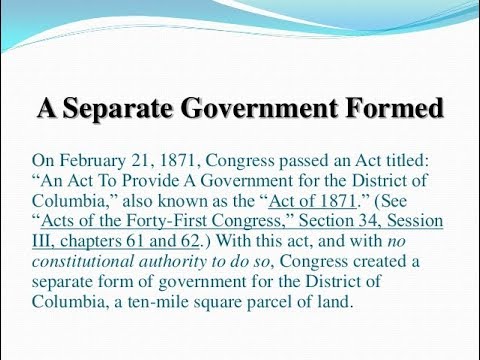
Thus the 1871 U. S. Corporation was born, which opened the door for ownership by foreign interests.

I really did not think this was going to be a long post when I first started doing the research on the life and works of George Peabody.
The lines of research kept growing because of all of the interconnected threads of the 19th-century that he was connected to in one way or another.
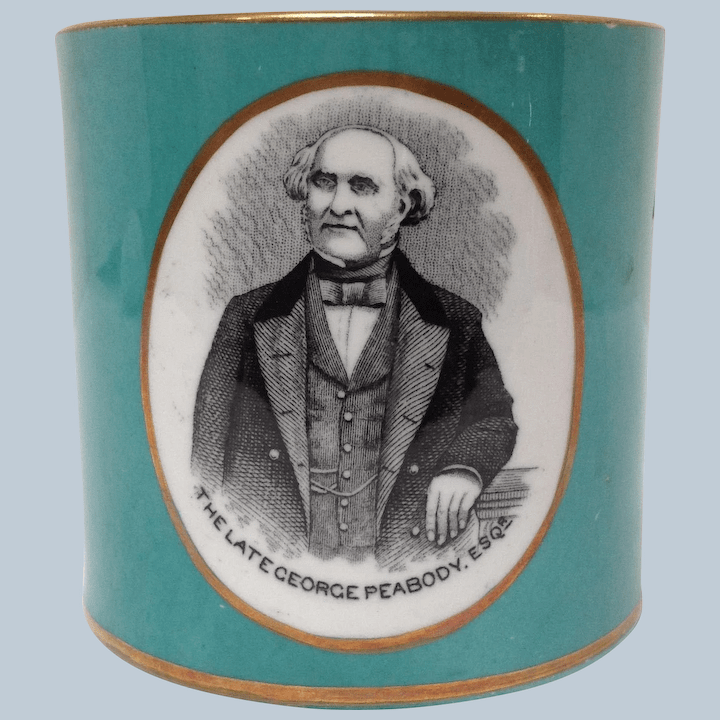
Since I am not doing this research for a Master’s or Doctoral thesis, I am not going to even try to get to the bottom of all these rabbit holes I found here, and those waiting to be found.

I am passionate about trying to find out how we got to the craziness of the world we live in today from what was originally a very advanced, integrated, and harmonious world civilization…when it was the Old World Order and not the New World Order.

Hopefully I have been able to shine some light on this vast subject of what might have taken place here that is available to find in a search, that in some way, shape, and form provides a plausible explanation for how we might have gotten to this point.

Did you know…
…that the famous American author, Jack London, was also a Socialist?

And that he published a book in 1908 called “The Iron Heel,” about the rise of an oligarchic tyranny in the United States.
An oligarchy is a form of power structure in which power rests with a small number of people.
The story-line emphasized future changes in society and politics, and not technological changes. It is called a dystopian novel, meaning characterized by mass poverty, public mistrust and suspicion, a police state or oppression.
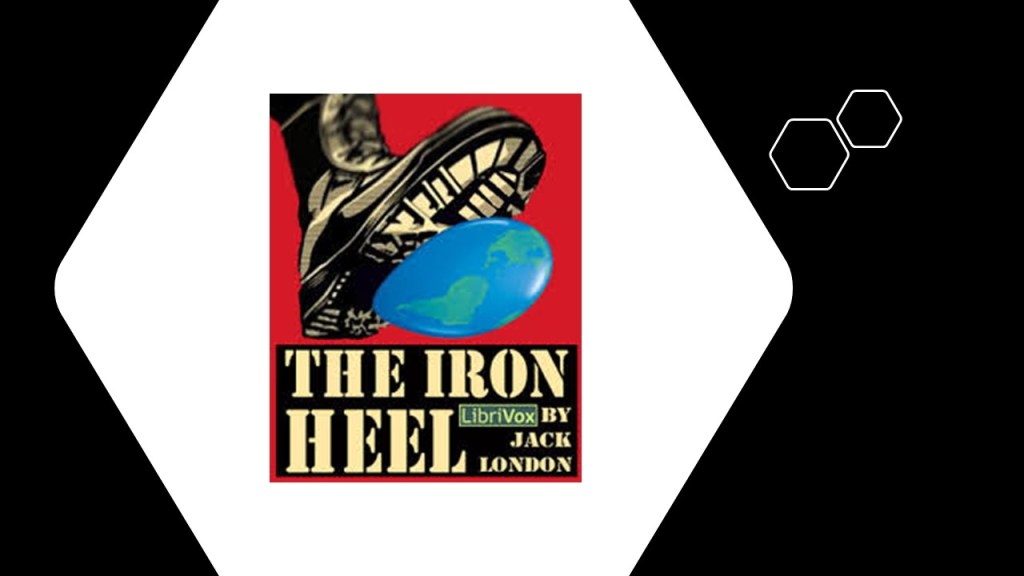
They have actually been telling us in a disguised way all along because they are required to tell us what they are doing in order to gain our consent because of our Free Will…

…so they have to managed to convince us that handing over our freedom is our own idea.

See how that works?!!

They have been working on getting us to this place for a very long time, but they have lost control of the narrative, no matter how hard they try to get it back!



Thank you for all your work; it brings so much to light. Love the ending.
LikeLike
I’ll throw in another from that time. William Wordell Mayo. Born in England, family has a huge church over there. I can find zero construction pictures on mayo rochester, mn. There was a huge “masonic temple” they used. Then there’s the problem with timelines. Rumor goes rochester was founded because of a tornado. But St. Marys was supposedly built with the mayos 2 years later. But in old paperwork and pictures, they claim what us natives know as Plummer Bldg, to have been mayo! And in pictures from the 20s, it appears that buildings windows don’t exist. And the stuff on top of the plumber buildings bell tower are amazing. Why would one need 2 16 foot tall brass doors that weigh 4000lbs each? And the “gods” inlayed in brass next time the plummer doors are eerie!
I’d be happy to share what I have, its very odd!!!
LikeLike
Can you email what you have at michelle.gibson565@gmail.com? Would love to include it in my latest “Short and Sweet” Series. I have looked at the Plummer building in the past, but not in great depth. Just comparing it to other similar towers, like the Victoria Building in London. Thanks!
LikeLike
Wow! I am so lucky to have come across your research. I started digging after spending Thanksgiving at The Peabody and was intrigued by the architecture and the crest above an entrance on the 2nd floor. I had no idea it would lead to JP Morgan, and so much more down this rabbit hole we find ourselves in. Thank you!
LikeLike